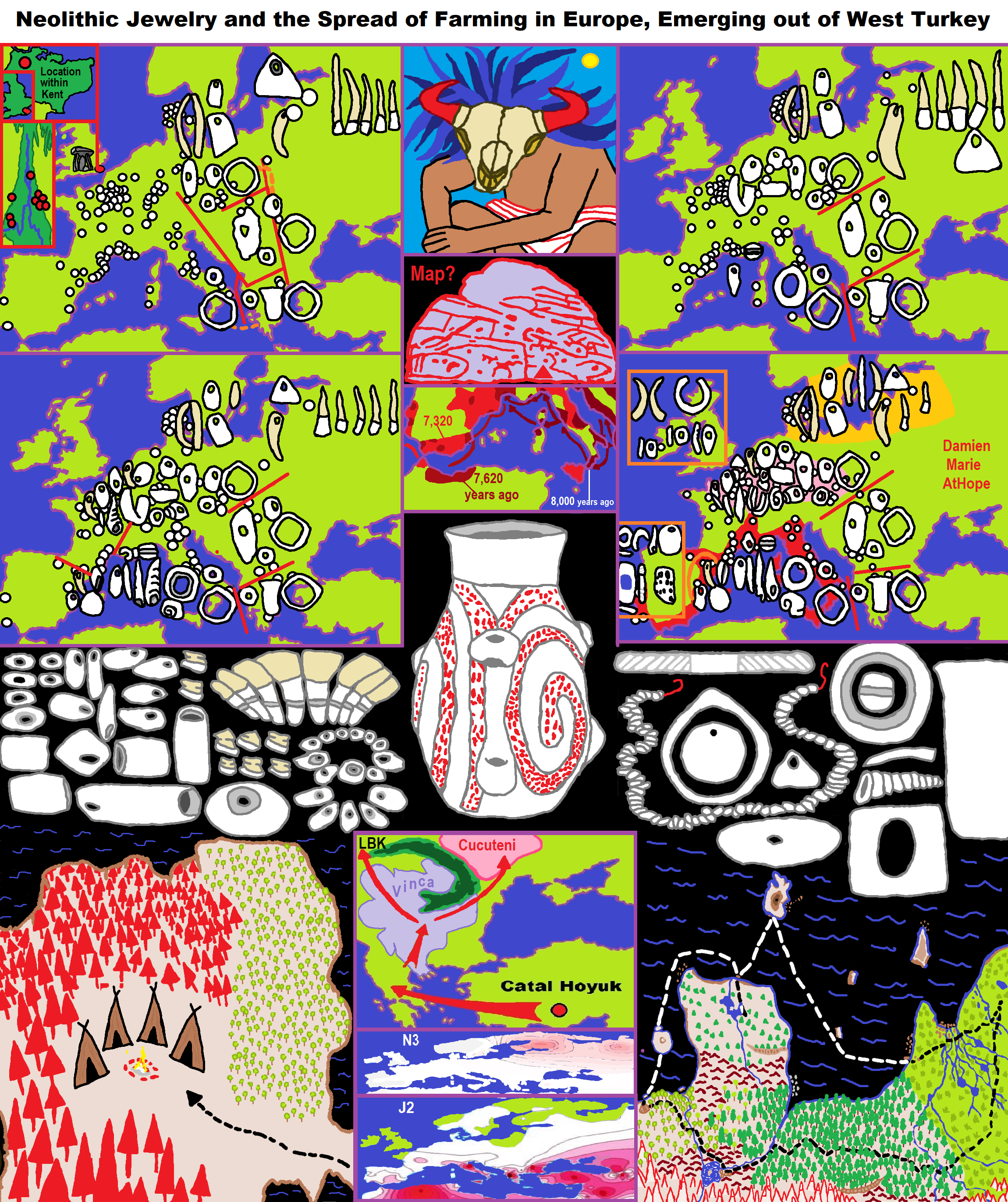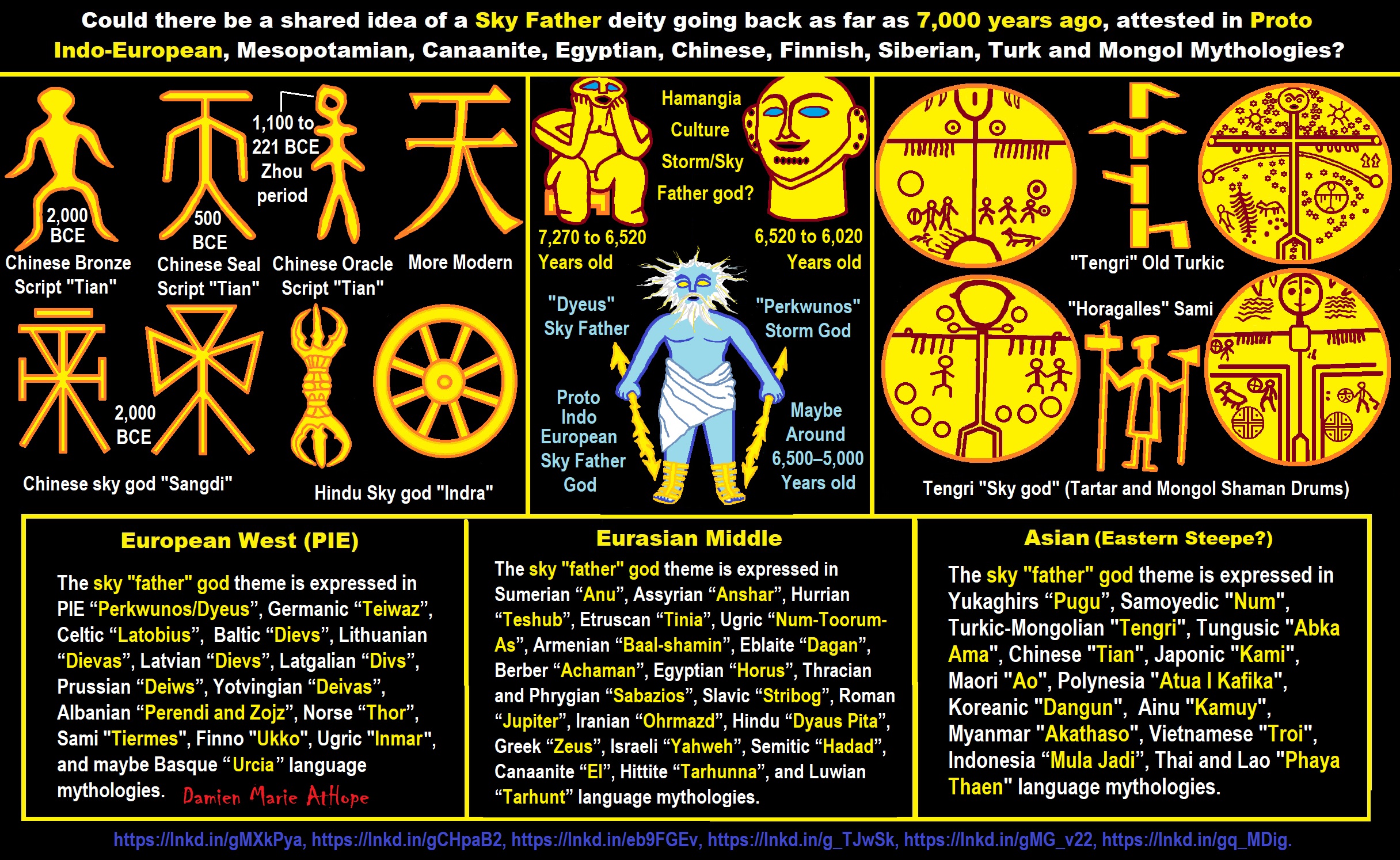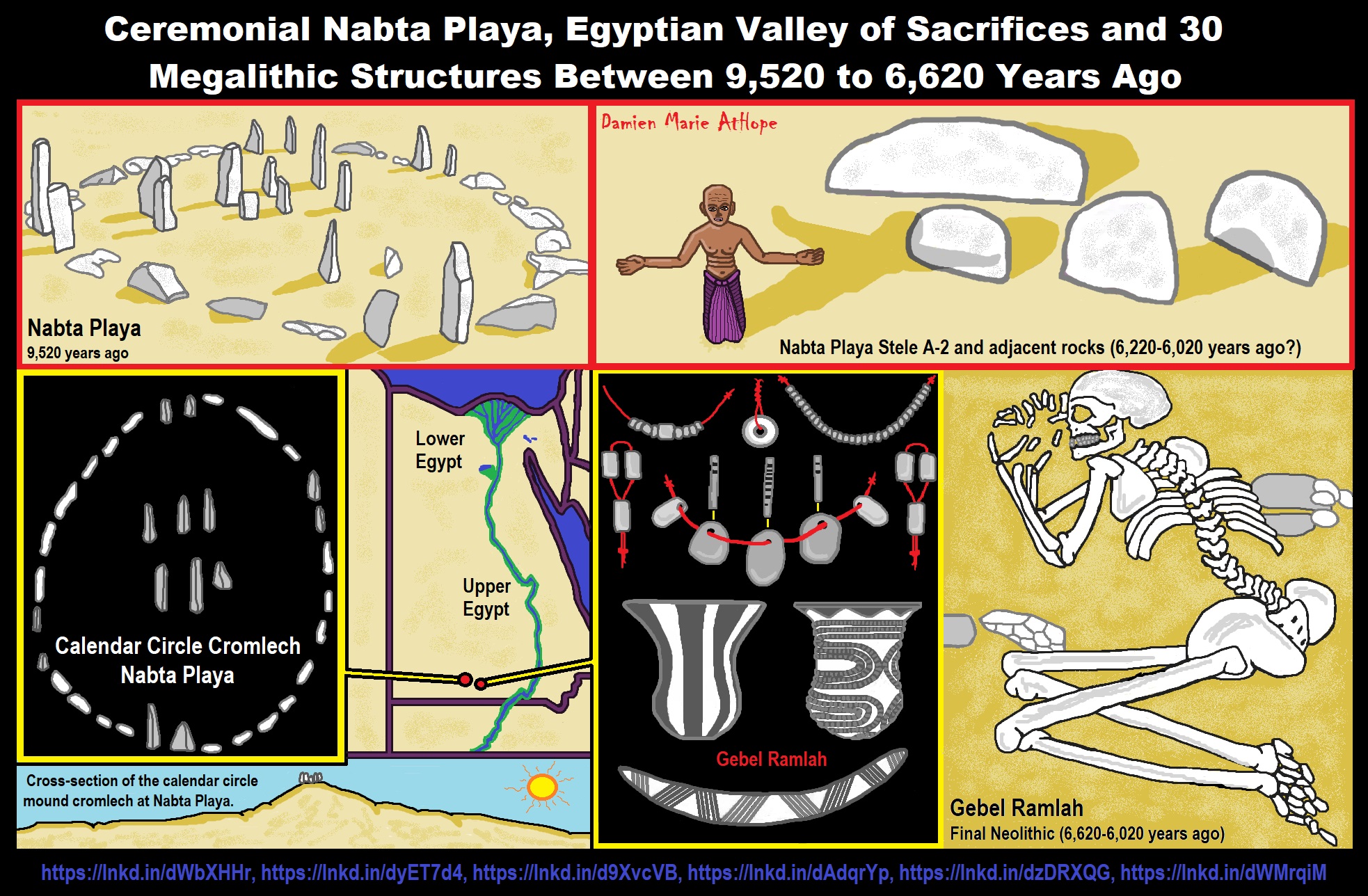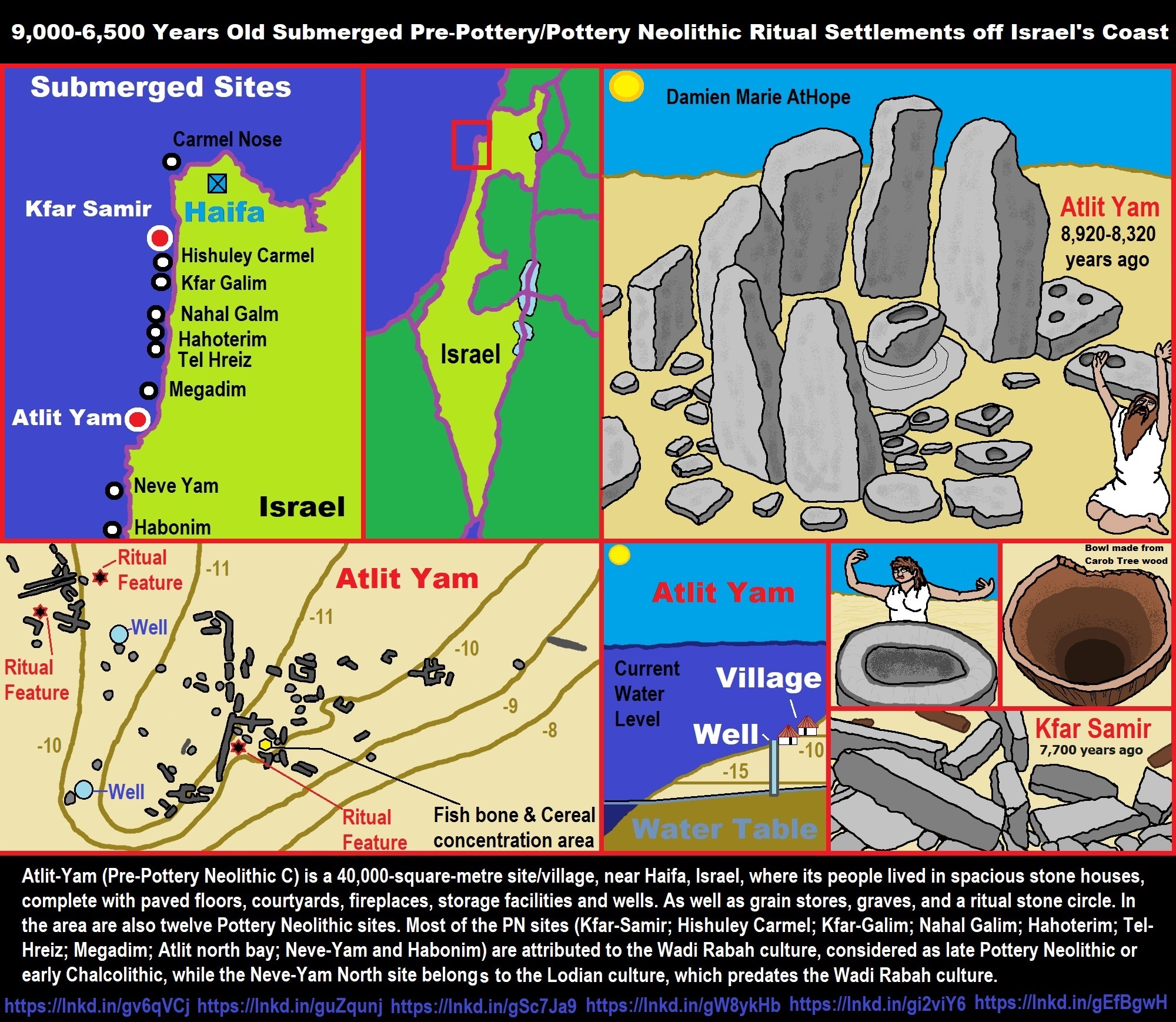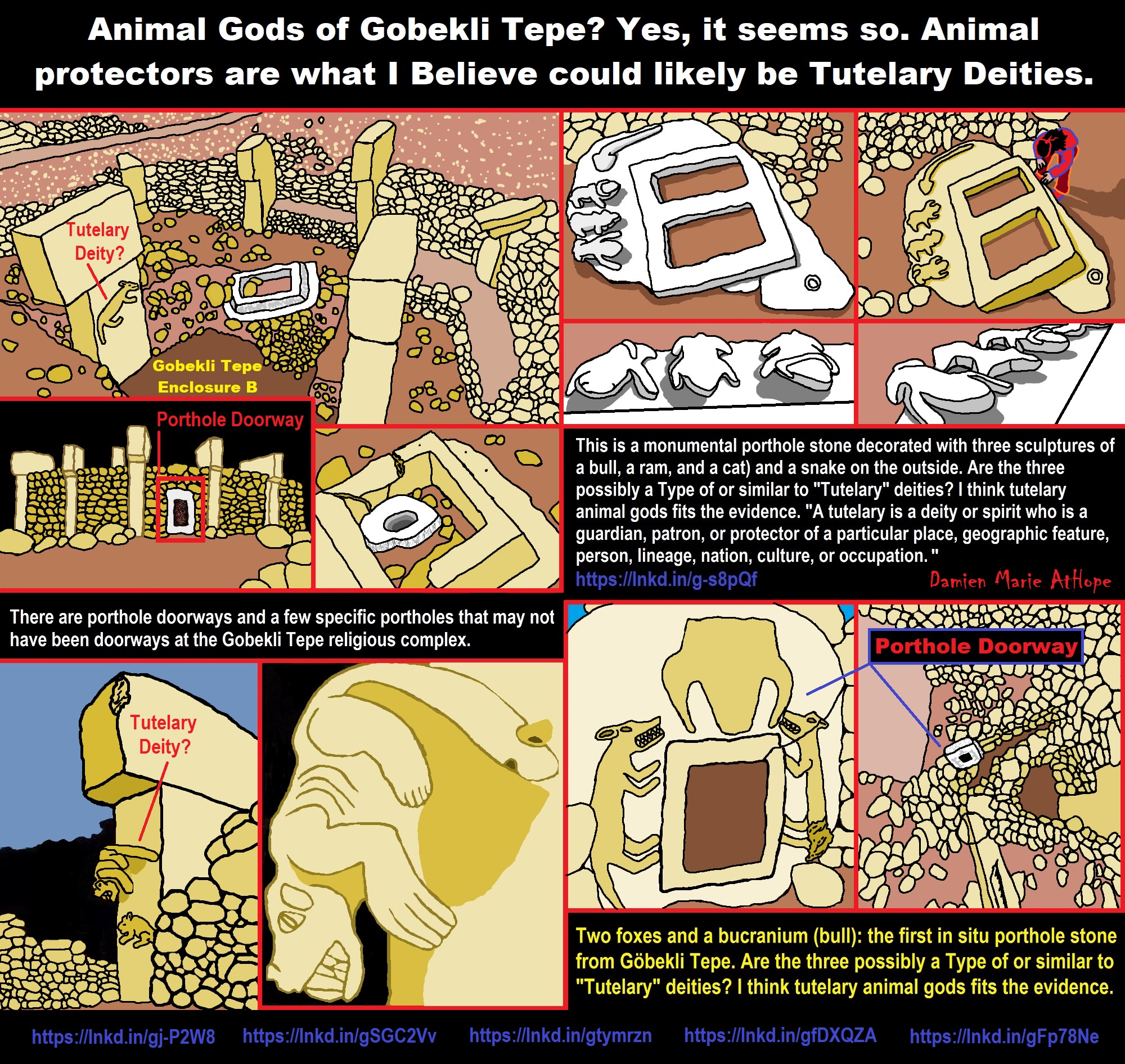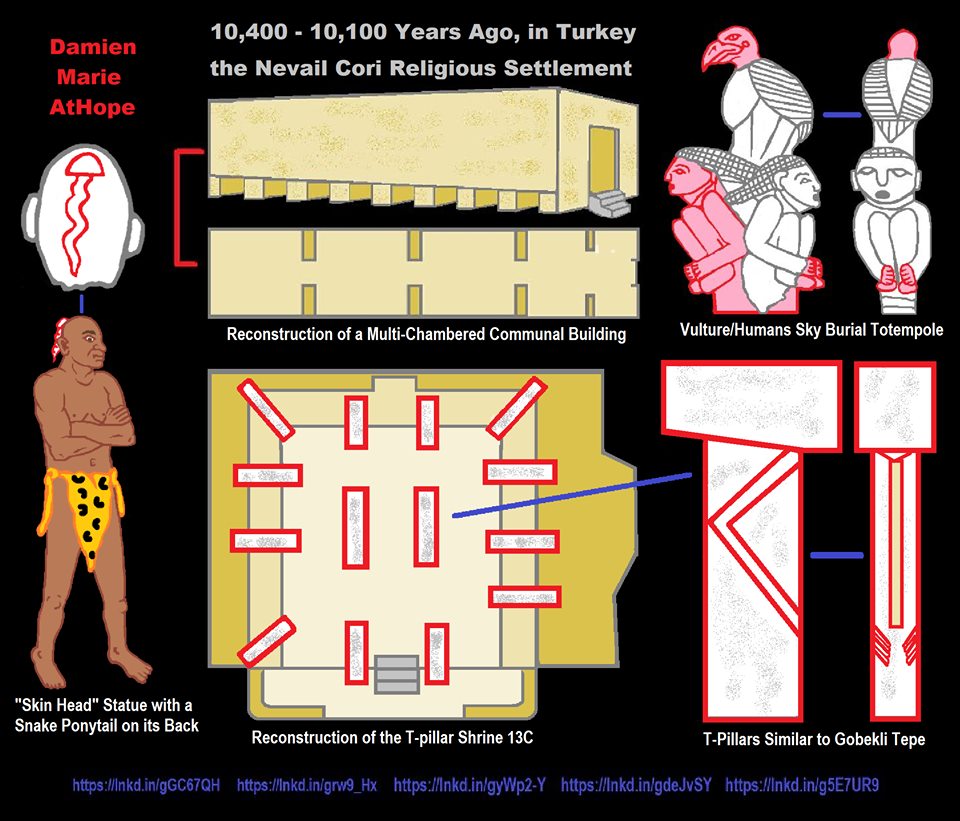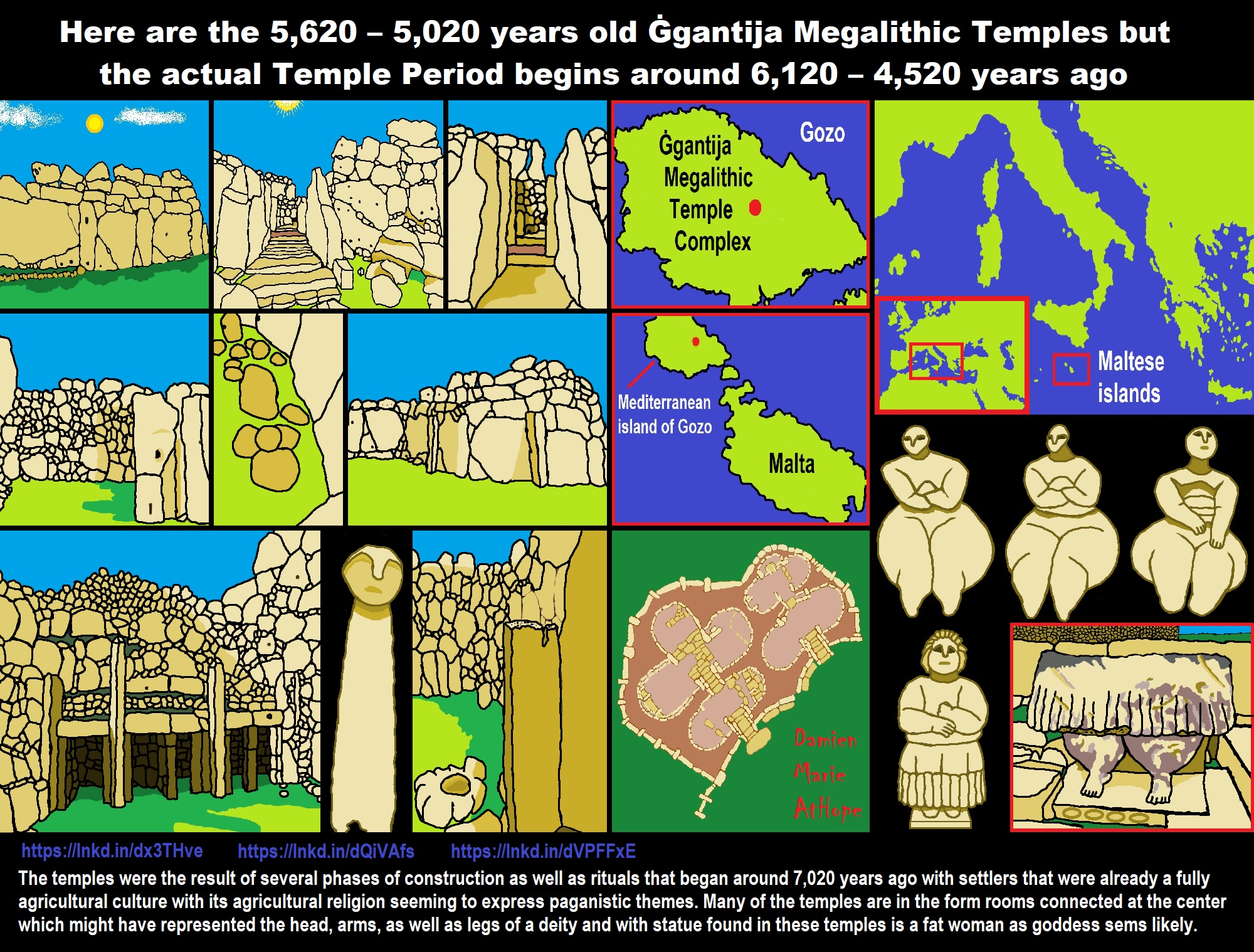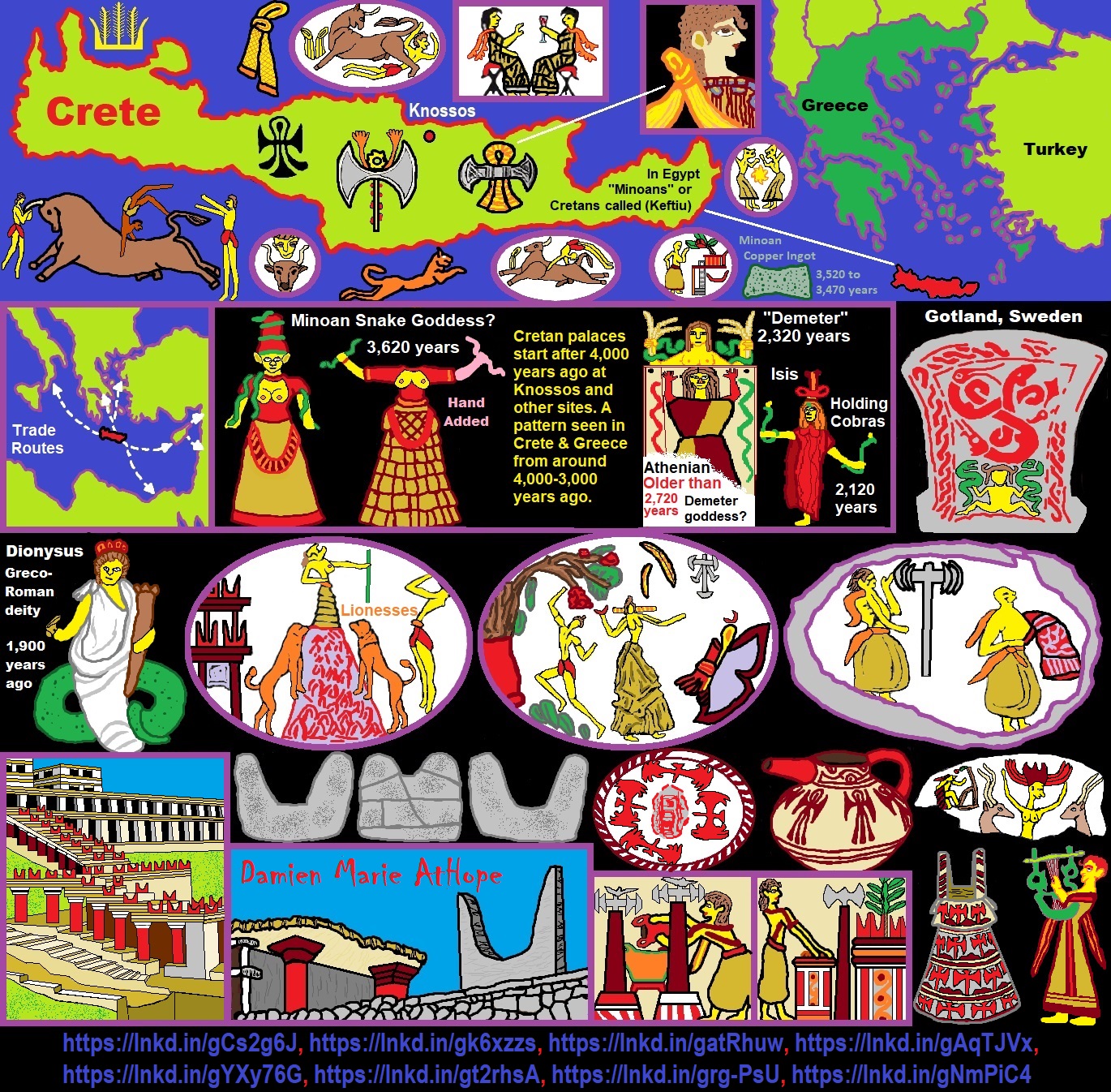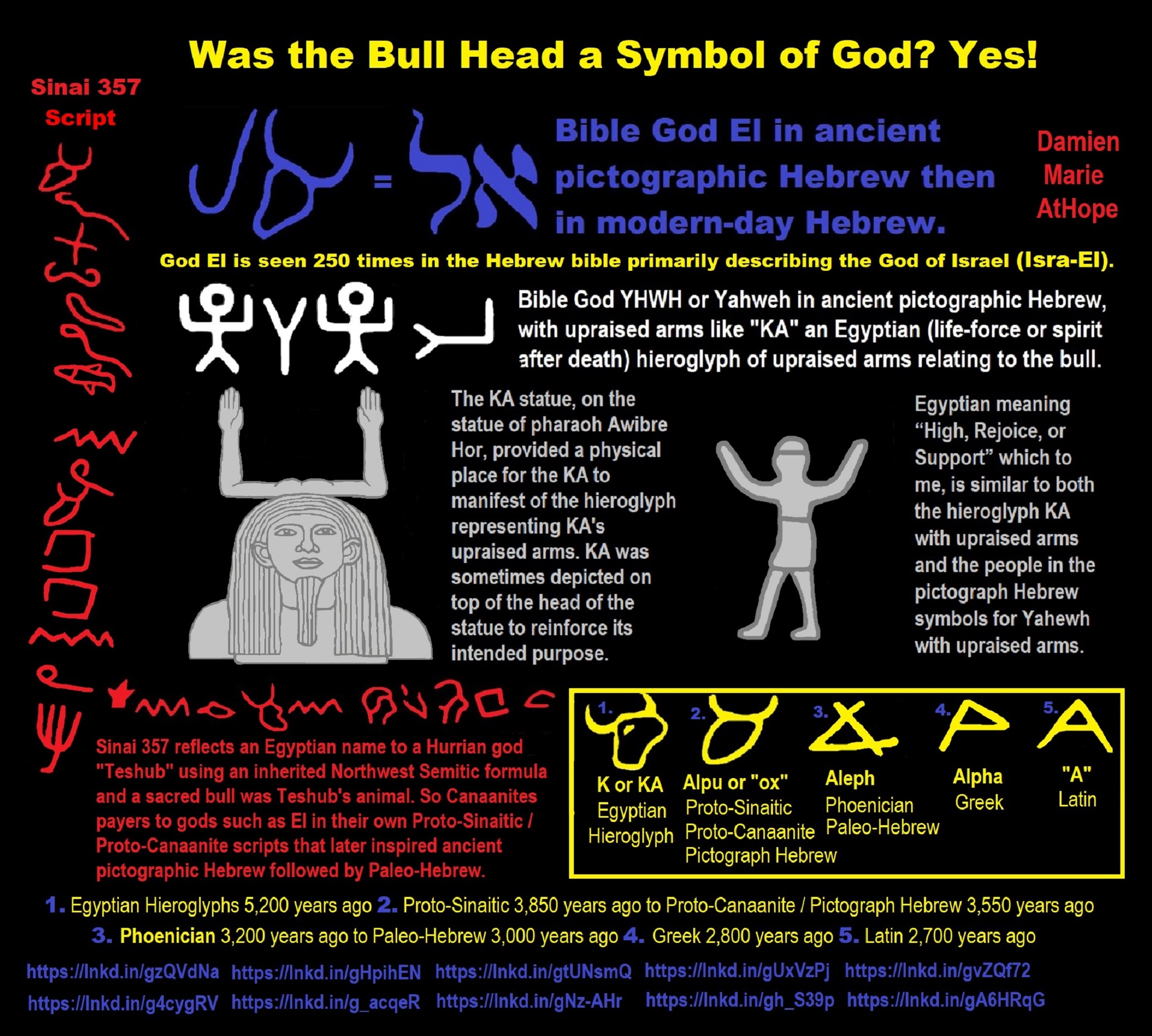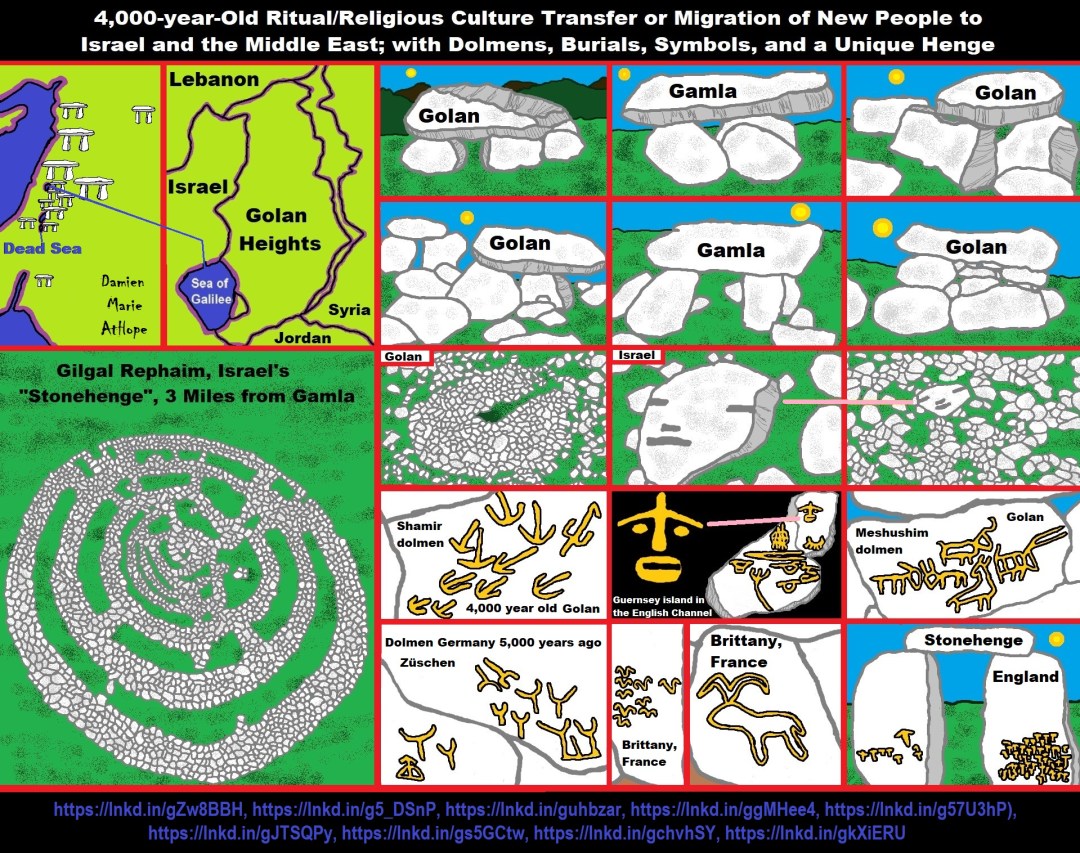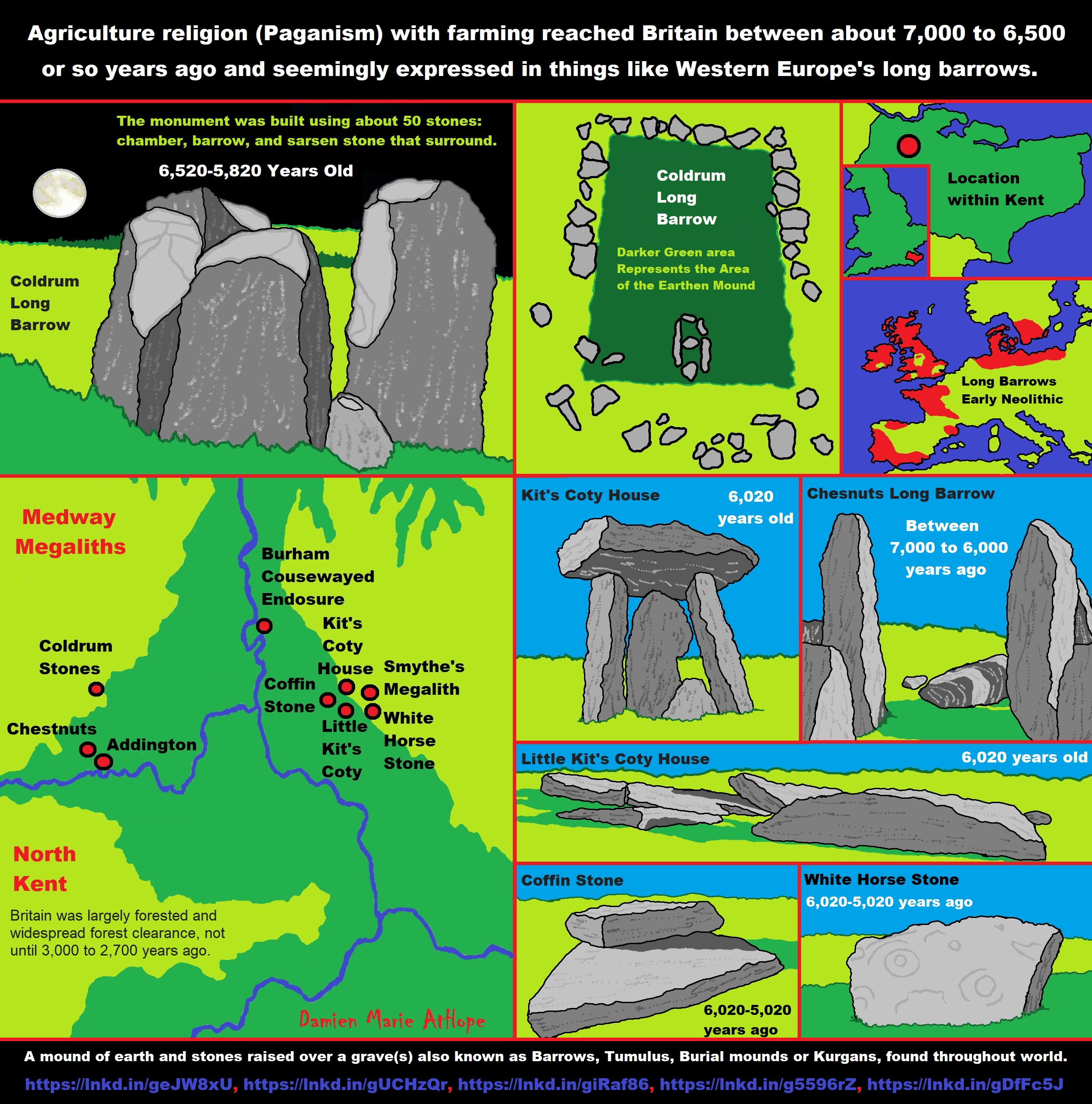
Paganism 12,000-4,000 years old
12,000-7,000 years old: related to (Pre-Capitalism)
7,000-5,000 years old: related to (Capitalism) (World War 0) Elite and their slaves!
5,000 years old: related to (Kings and the Rise of the State)
4,000 years old: related to (First Moralistic gods, then the Origin time of Monotheism)
Agriculture religion (Paganism) with farming reached Britain between about 7,000 to 6,500 or so years ago and seemingly expressed in things like Western Europe’s long barrows. The monument (Coldrum Long Barrow) was built using about 50 stones: chamber, barrow, and sarsen stone that surround.
“The Medway Megaliths, sometimes termed the Kentish Megaliths, are a group of Early Neolithic chambered long barrows and other megalithic monuments located in the lower valley of the River Medway in Kent, South-East England. Constructed from local sarsen stone and soil between the 4th and 3rd millennia BCE, they represent the only known prehistoric megalithic group in eastern England and the most south-easterly group in Britain. They remain one of several regionally contained chambered long barrow traditions in Britain, although have certain precise architectural characteristics which mark them out as distinct from other groups. The purpose of these long barrows remains elusive, although some were used as tombs for the remains of a select group of individuals. It is also widely believed that they were places where religious rituals were performed. Many archaeologists believe that they reflect the process of Neolithisation of Britain, as hunter-gatherer populations were replaced by pastoralists.” ref
“Three chambered tombs have been identified to the west of the river: the Coldrum Stones, Addington Long Barrow, and Chestnuts Long Barrow. To the east of the river, another three chambered tombs have been identified: Kit’s Coty House, Little Kit’s Coty House, and Smythe’s Megalith, although it has also been suggested that two nearby megaliths, the Coffin Stone and the White Horse Stone, are remnants of former chambered tombs. An Early Neolithic longhouse and causewayed enclosure have also been identified in the vicinity of the monuments. The Medway Megaliths have become heavily damaged and dilapidated since original construction, largely due to an intentional program of destruction in the late 13th century CE. They began to attract the interest of antiquarians in the late 16th century, who developed a number of erroneous theories about their origin, before later being scientifically investigated by archaeologists in the late 19th century. Local folklore has also grown up around the monuments, which came to be interpreted and used as sacred sites by contemporary Pagans in the latter 20th century.” ref
“The Early Neolithic was a revolutionary period of British history. Beginning in the fifth millennium BCE, it saw a widespread change in lifestyle as the communities living in the British Isles adopted agriculture as their primary form of subsistence, abandoning the hunter-gatherer lifestyle that had characterized the preceding Mesolithic period. Archaeologists have been unable to prove whether this adoption of farming was because of a new influx of migrants coming in from continental Europe or because the indigenous Mesolithic Britons came to adopt the agricultural practices of continental societies. Either way, it certainly emerged through contact with continental Europe, probably as a result of centuries of interaction between Mesolithic people living in south-east Britain and Linear Pottery culture (LBK) communities in north-eastern France.” ref
“Between 4500 and 3800 BCE, all of the British Isles came to abandon its former Mesolithic hunter-gatherer lifestyle, to be replaced by the new agricultural subsistence of the Neolithic Age. Throughout most of Britain, there is little evidence of cereal or permanent dwellings from this period, leading archaeologists to believe that the Early Neolithic economy on the island was largely pastoral, relying on herding cattle, with people living a nomadic or semi-nomadic way of life. It is apparent that although a common material culture was shared throughout most of the British Isles in this period, there was great regional variation regarding the nature and distribution of settlement, architectural styles, and the use of natural resources. There is archaeological evidence of violence and warfare in Early Neolithic Britain from such sites as West Kennet Long Barrow and Hambledon Hill, with some groups constructing fortifications to defend themselves from attackers. Contemporary archaeologists have no direct proof of gender relations on the island at this time, although most believe that it was probably a male-dominated society, in keeping with all recorded societies that practice large-scale animal husbandry.” ref
“Britain was largely forested in this period, although did witness some land clearance. It remains unclear to what extent the Kentish area was deforested in the Early Neolithic, although it appears that widespread forest clearance only took place on the chalklands of south-east Britain much later, in the Late Bronze Age. Environmental data from the area around the White Horse Stone supports the idea that the area was still largely forested in the Early Neolithic, covered by a woodland of oak, ash, hazel/alder, and Maloideae.” ref
Coldrum Long Barrow
“The Coldrum Long Barrow, also known as the Coldrum Stones and the Adscombe Stones, is a chambered long barrow located near the village of Trottiscliffe in the south-eastern English county of Kent. Probably constructed in the fourth millennium BCE, during Britain’s Early Neolithic period, today it survives only in a state of ruin. Archaeologists have established that the monument was built by pastoralist communities shortly after the introduction of agriculture to Britain from continental Europe. Part of an architectural tradition of long barrow building that was widespread across Neolithic Europe, the Coldrum Stones belong to a localized regional variant of barrows produced in the vicinity of the River Medway, now known as the Medway Megaliths. Of these, it is in the best surviving condition. It lies near to both Addington Long Barrow and Chestnuts Long Barrow on the western side of the river. Two further surviving long barrows, Kit’s Coty House and Little Kit’s Coty House, as well as possible survivals such as the Coffin Stone and White Horse Stone, are located on the Medway’s eastern side.” ref
“Built out of earth and around fifty local sarsen-stone megaliths, the long barrow consisted of a sub-rectangular earthen tumulus enclosed by kerb-stones. Within the eastern end of the tumulus was a stone chamber, into which human remains were deposited on at least two separate occasions during the Early Neolithic. Osteoarchaeological analysis of these remains has shown them to be those of at least seventeen individuals, a mixture of men, women, and children. At least one of the bodies had been dismembered before burial, potentially reflecting a funerary tradition of excarnation and secondary burial. As with other barrows, Coldrum has been interpreted as a tomb to house the remains of the dead, perhaps as part of a belief system involving ancestor veneration, although archaeologists have suggested that it may also have had further religious, ritual, and cultural connotations and uses.” ref
“In archaeology and anthropology, the term excarnation (also known as defleshing) refers to the practice of removing the flesh and organs of the dead before burial. Excarnation may be through natural means, involving leaving a body exposed for animals to scavenge, or by butchering the corpse by hand. Practices making use of natural processes for excarnation include Tibetan sky burials, Comanche platform burials, and traditional Zoroastrian funerals (see Tower of Silence). Archaeologists believe that in this practice, people typically left the body exposed on a woven litter or altar. Following excarnation, the litter with its remains would be removed from the site. Since metatarsals, finger bones, and toe bones are very small, they would easily fall through gaps in a woven structure or roll off the side during this removal. Thus a site where only small bones are found is suggestive of ritual excarnation. Some Native American groups in the southeastern portion of North America practiced excarnation in protohistoric times.” ref
“After the Early Neolithic, the long barrow fell into a state of ruined dilapidation, perhaps experiencing deliberate destruction in the Late Medieval period, either by Christian iconoclasts or treasure hunters. In local folklore, the site became associated with the burial of a prince and the countless stones motif. The ruin attracted the interest of antiquarians in the 19th century, while archaeological excavation took place in the early 20th. In 1926, ownership was transferred to heritage charity The National Trust. Open without charge to visitors all year around, the stones are the site of a rag tree, a May Day morris dance, and various modern Pagan rituals. The Coldrum Stones are named after a nearby farm, Coldrum Lodge, which has since been demolished. The monument lies in a “rather isolated site” north-east of the nearby village of Trottiscliffe, in the south-eastern English county of Kent. The site is also positioned about 500 meters (550 yards) from a prehistoric track known as the Pilgrims’ Way. The tomb can be reached along a pathway known as Coldrum Lane, which is accessible only on foot. The village of Addington is located 2.012 kilometers (1 mi 440 yds) away.” ref
The tomb building tradition
“It seems that the role of ancestors in Neolithic society was much more important than in the world of the hunter-gatherer. Clans and forebears began to have symbolic importance to the settled farming communities of the Neolithic. Dead ancestors were celebrated through funerals, feasts, and grave goods, and their carefully selected body-parts were housed in specially built monuments, often symbolizing ‘houses’ of the dead … The tombs provide the earliest and most tangible evidence of Neolithic people and their customs and are some of the most impressive and aesthetically distinctive constructions of prehistoric Britain.” ref
“Archaeologist and prehistorian Caroline Malone, 2001. Across Western Europe, the Early Neolithic marked the first period in which humans built monumental structures in the landscape. These were tombs that held the physical remains of the dead, and though sometimes constructed out of timber, many were built using large stones, now known as “megaliths“. Individuals were rarely buried alone in the Early Neolithic, instead of being interned in collective burials with other members of their community. The construction of these collective burial monumental tombs, both wooden and megalithic, began in continental Europe before being adopted in Britain in the first half of the fourth millennium BCE. The Early Neolithic people of Britain placed far greater emphasis on the ritualized burial of the dead than their Mesolithic forebears had done. Many archaeologists have suggested that this is because Early Neolithic people adhered to an ancestor cult that venerated the spirits of the dead, believing that they could intercede with the forces of nature for the benefit of their living descendants. It has furthermore been suggested that Early Neolithic people entered into the tombs – which doubled as temples or shrines – to perform rituals that would honor the dead and ask for their assistance. For this reason, historian Ronald Hutton termed these monuments “tomb-shrines” to reflect their dual purpose.” ref
“In Britain, these tombs were typically located on prominent hills and slopes overlooking the surrounding landscape, perhaps at the junction between different territories. Archaeologist Caroline Malone noted that the tombs would have served as one of a variety of markers in the landscape that conveyed information on “territory, political allegiance, ownership, and ancestors.” Many archaeologists have subscribed to the idea that these tomb-shrines served as territorial markers between different tribal groups, although others have argued that such markers would be of little use to a nomadic herding society. Instead, it has been suggested that they represent markers along herding pathways. Many archaeologists have suggested that the construction of such monuments reflects an attempt to stamp control and ownership over the land, thus representing a change in mindset brought about by Neolithicisation. Others have suggested that these monuments were built on sites already deemed sacred by Mesolithic hunter-gatherers.” ref
“Archaeologists have differentiated these Early Neolithic tombs into a variety of different architectural styles, each typically associated with a different region within the British Isles. Passage graves, characterized by their narrow passage made of large stones and one or multiple burial chambers covered in earth or stone, were predominantly located in northern Britain and southern and central Ireland. Alternately, across northern Ireland and central Britain long chambered mounds predominated, while in the east and south-east of Britain, earthen long barrows represented the dominant architectural trend. These earthen long barrows were typically constructed of timber because building stone was scarce in southern Britain; archaeologist Aubrey Burl argued that these timber tombs might have been “even more eye-catching” than their stone counterparts, perhaps consisting of “towering carved poles, flamboyantly painted”, but that evidence of such sculptures has not survived. The Medway Megaliths represent just one of these regional groups within the wider West European tradition of tomb building in this period.” ref
“Although now all in a ruinous state and not retaining their original appearance, at the time of construction the Medway Megaliths would have been some of the largest and most visually imposing Early Neolithic funerary monuments in Britain. Grouped along the River Medway as it cuts through the North Downs, they constitute the most south-easterly group of megalithic monuments in the British Isles, and the only megalithic group in eastern England. Archaeologists Brian Philp and Mike Dutto deemed the Medway Megaliths to be “some of the most interesting and well known” archaeological sites in Kent, while archaeologist Paul Ashbee described them as “the most grandiose and impressive structures of their kind in southern England”. The BBC Countryfile website notes that although none of the monuments are on the same scale as Stonehenge, they are “really quite impressive” when taken collectively, describing them as “the east of England’s answer to the megaliths of the Salisbury Plains.” ref
“They can be divided into two separate clusters: one to the west of the River Medway and the other on Blue Bell Hill to the east, with the distance between the two clusters measuring at between 8 and 10 km. The western group includes Coldrum Long Barrow, Addington Long Barrow, and the Chestnuts Long Barrow. The eastern group consists of Kit’s Coty House, Lower Kit’s Coty House, the Coffin Stone, and several other stones which might have once been parts of chambered tombs. It is not known if they were all built at the same time, or whether they were constructed in succession, while similarly it is not known if they each served the same function or whether there was a hierarchy in their usage. The Medway long barrows all conformed to the same general design plan, and are all aligned on an east to west axis. Each had a stone chamber at the eastern end of the mound, and they each probably had a stone facade flanking the entrance. The chambers were constructed from sarsen, a dense, hard, and durable stone that occurs naturally throughout Kent, having formed out of silicified sand from the Eocene. Early Neolithic builders would have selected blocks from the local area, and then transported them to the site of the monument to be erected.” ref
“Such common architectural features among these tomb-shrines indicate a strong regional cohesion with no direct parallels elsewhere in the British Isles. For instance, they would have been taller than most other tomb-shrines in Britain, with internal heights of up to 10 ft. Nevertheless, as with other regional groupings of Early Neolithic tomb-shrines (such as the Cotswold-Severn group), there are also various idiosyncrasies in the different monuments, such as Coldrum’s rectilinear shape, the Chestnut long barrow’s facade, and the long, thin mounds at Addington and Kit’s Coty. This variation might have been caused by the tomb-shrines being altered and adapted over the course of their use; in this scenario, the monuments would represent composite structures. It seems apparent that the people who built these monuments were influenced by pre-existing tomb-shrines that they were already aware of. Whether those people had grown up locally or moved into the Medway area from elsewhere is not known. Based on a stylistic analysis of their architectural designs, Stuart Piggott thought that they had originated in the area around the Low Countries, while Glyn Daniel instead believed that the same evidence showed an influence from Scandinavia.” ref
“John H. Evans instead suggested an origin in Germany, and Ronald F. Jessop thought that their origins could be seen in the Cotswold-Severn megalithic group. Paul Ashbee noted that their close clustering in the same area was reminiscent of the megalithic tomb-shrine traditions of continental Northern Europe, and emphasized that the Medway Megaliths were a regional manifestation of a tradition widespread across Early Neolithic Europe. He nevertheless stressed that a precise place of origin was “impossible to indicate” with the available evidence. There is little evidence for deposition within the tomb-shrines, largely due to the damage that they have sustained. Human bone has been found in the Coldrum Long Barrow, Addington Long Barrow, and the Coffin Stone, burned bone from Chestnuts Long Barrow, and pot sherds from Chestnuts, Addington, and Kit’s Coty. They have thus usually been interpreted as collective tombs for the interment of the physical remains of the dead. Ashbee believed that the area surrounding the megaliths might have been a “ritual landscape” that was believed to possess “especial qualities”, thus explaining why Early Neolithic people decided to construct the monuments at this location. Killick suggested that the area was chosen because of the visually imposing nature of the local landscape, also suggesting that it might have been chosen because it allowed for intervisibility between the different monuments.” ref
“Inspired by ideas pioneered elsewhere by the archaeologist Chris Tilley, Killick suggested that the Medway Megaliths were oriented to point at either the Downs or the River, noting that five of the monuments point toward at least one of these two geographical features. The views visible from the monuments are not however uniform; had the vicinity been deforested, then Kit’s Coty, Little Kit’s Coty, and Coldrum would have had 360° panoramic views of the landscape, whereas only a third of the local landscape is visible from Addington and Chestnuts Long Barrows. Killick also thought it probably that intervisibility was a factor in locating the monuments, noting that Kit’s Coty House, Little Kit’s Coty, and the Coffin Stone were probably intervisible in the Early Neolithic, as were Addington and Chestnuts Long Barrow, and the White Horse Stones and Smythe’s Megalith.” ref
Related activity
“Other evidence of Neolithic activity has also been identified in the vicinity of the megaliths. Excavation by the Oxford Archaeological Unit in the late 1990s revealed the existence of a Neolithic longhouse close to the White Horse Stone. It was stylistically very similar to longhouses belonging to the linearbandkeramic (LBK) and post-LBK cultures of central and north-western Europe, which are dated to the 5th and 6th millennia BCE. Three of the building’s post holes contained sherds of Early Neolithic ceramic Plain Bowls, which were radiocarbon dated to 4110–3530 cal BCE. In the vicinity, sherds of Clacton-style Grooved Ware and Mortlake-style Peterborough ware ceramics were also found, dating from the Mid-to-Late Neolithic, suggesting that activity continued at the site over a long period of time (c.3750–2250 BCE). It is not known what the purpose of the longhouse was, or whether it was primarily domestic or ritualistic in function, although excavators expressed their opinion that it was probably domestic and communal in use. Conversely, the archaeologist Paul Ashbee thought it likely that it was a “cult-house” on the basis of its isolated nature. Evidence of a smaller, circular building was found to the south-east of the longhouse, although this might have been later in date. Ashbee highlighted that the stone long barrows stylistically emulated the wooden long houses, and that this was probably an act of conscious imitation.” ref
Long barrows
Long barrows are a style of a monument constructed across Western Europe in the fifth and fourth millennia BCE, during the Early Neolithic period. Typically constructed from earth and either timber or stone, those using the latter material represent the oldest widespread tradition of stone construction in the world. Around 40,000 long barrows survive today. The structures have a long earthen tumulus, or “barrow”, that is flanked on two sides with linear ditches. These typically stretch for between 20 and 70 metres in length, although some exceptional examples are either longer or shorter than this. Some examples have a timber or stone chamber in one end of the tumulus. These monuments often contained human remains interred within their chambers, and as a result, are often interpreted as tombs, although there are some examples where this appears not to be the case. The choice of timber or stone may have arisen from the availability of local materials rather than cultural differences. Those that contained chambers inside of them are often termed chambered long barrows while those which lack chambers are instead called unchambered long barrows or earthen long barrows.
“A tumulus (plural tumuli) is a mound of earth and stones raised over a grave or graves. Tumuli are also known as barrows, burial mounds or kurgans, and may be found throughout much of the world. A cairn, which is a mound of stones built for various purposes, may also originally have been a tumulus. Tumuli are often categorized according to their external apparent shape. In this respect, a long barrow is a long tumulus, usually constructed on top of several burials, such as passage graves. A round barrow is a round tumulus, also commonly constructed on top of burials. The internal structure and architecture of both long and round barrows has a broad range; the categorization only refers to the external apparent shape. The method of inhumation may involve a dolmen, a cist, a mortuary enclosure, a mortuary house, or a chamber tomb. Examples of barrows include Duggleby Howe and Maeshowe. The word tumulus is Latin for ‘mound’ or ‘small hill’, which is derived from the Proto-Indo-European root *teuh2- with extended zero grade *tum-, ‘to bulge, swell’ also found in tomb, tumor, tumescent, thumb, thigh, and thousand.” ref
“The earliest examples developed in Iberia and western France during the mid-fifth millennium BCE. The tradition then spread northwards, into the British Isles and then the Low Countries and southern Scandinavia. Each area developed its own variations of the long barrow tradition, often exhibiting their own architectural innovations. The purpose and meaning of the barrows remains an issue of debate among archaeologists. One argument is that they are religious sites, perhaps erected as part of a system of ancestor veneration or as a religion spread by missionaries or settlers. An alternative explanation views them primarily in economic terms, as territorial markers delineating the areas controlled by different communities as they transitioned toward farming. Communities continued to utilise these long barrows long after their construction. In both the Roman period and the Early Middle Ages, many long barrows were reused as cemeteries. Since the sixteenth century they have attracted interest from antiquarians and archaeologists; it is from the excavations of the latter that our knowledge about them derives. Some have been reconstructed and have become tourist attractions or sacred sites used for rituals by modern Pagan and other religious groups. Given their dispersal across Western Europe, long barrows have been given different names in the various different languages of this region. The term barrow is a southern English dialect word for an earthen tumulus, and was adopted as a scholarly term for such monuments by the 17th-century English antiquarian John Aubrey. Synonyms found in other parts of Britain included low in Cheshire, Staffordshire, and Derbyshire, tump in Gloucestershire and Hereford, howe in Northern England and Scotland, and cairn in Scotland. Another term to have achieved international usage has been dolmen, a Breton word meaning “table-stone”; this is typically used in reference to the stone chambers found in some, although not all, long barrows. The historian Ronald Hutton suggested that such sites could also be termed “tomb-shrines” to reflect the fact that they appear to have often been used both to house the remains of the dead and to have been used in ritual activities. Some contain no burials while others have been found to contain the remains of up to fifty people.” ref
Chambered and earthen
“The decision as to whether a long barrow used wood or stone appears to have been based largely on the availability of resources. Some of the long barrows contained stone-lined chambers within them. Early 20th-century archaeologists began to call these monuments chambered tombs. The archaeologists Roy and Lesley Adkins referred to these monuments as megalithic long barrows. In most cases, local stone was used where it was available. The style of the chamber falls into two categories. One form, known as grottes sepulchrales artificielles in French archaeology, are dug into the earth. The second form, which is more widespread, are known as cryptes dolmeniques in French archaeology and involved the chamber being erected above ground. Many chambered long barrows contained side chambers within them, often producing a cruciform shape. Others had no such side alcoves; these are known as undifferentiated tombs. Some long barrows do not contain chambers inside of them. John Thurnham termed these “unchambered” barrows, while the archaeologist Stuart Piggott favored the term “earthen” barrows for them. Ian Kinnes instead used the term “non-megalithic barrows”. These long barrows might have used timber because stone was not available. Some classificatory systems, such as that employed by the United Kingdom’s National Monuments Record, do not distinguish between the different types of long barrow. The archaeologist David Field noted that drawing typological distinctions on the basis of material used can mask important similarities between different long barrows. Also criticizing the focus on classification, the archaeologists Lewis-Williams and Pearce believed that doing so distracted scholars from the task of explaining the meaning and purpose behind the monuments.” ref
Design and architecture
“Long barrows are single mounds, usually of earth, which are flanked by ditches. They are usually between 20 and 70 metres in length, although these are some exceptional examples at either end of this spectrum. The construction of long barrows in the Early Neolithic would have required the co-operation of a number of different individuals and would have represented an important investment in time and resources. They were built without the use of metal tools. There is often regional variation in style and material. In the north and west of Britain, for instance, long barrows often consist of stone mounds containing chambers inside of them, whereas in the south and east of Britain these long barrows are typically made of earth.” ref
“Many were altered and restyled over their long period of use. Ascertaining at what date a long barrow was constructed is difficult for archaeologists as a result of the various modifications that were made to the monument during the Early Neolithic. Similarly, both modifications and later damage can make it difficult to determine the nature of the original long barrow design. Architecturally, there is much overlap between long barrows and other monument types from Neolithic Europe, such as the bank barrows, cursus monuments, long cairns, and mortuary enclosures. Bank barrows are stylistically similar to the long barrows but are considerably longer. Cursus monuments also exhibit parallel ditches, but also extend over much longer distances than the long barrows. Enviro-archaeological studies have demonstrated that many of the long barrows were erected in wooded landscapes. In Britain, these chambered long barrows are typically located on prominent hills and slopes, in particular being located above rivers and inlets and overlooking valleys. In Britain, long barrows were also often constructed near to causewayed enclosures, a form of earthen monument.” ref
Regional variation
“In the area of southern Spain, Portugal, southwestern France, and Brittany, the long barrows typically include large stone chambers. In Britain, earthen long barrows predominate across much of the southern and eastern parts of the island. Around 300 earthen long barrows are known from across the eastern side of Britain, from Aberdeenshire in the north down to the South Downs in the south, with two projections westward into Dorset and Galloway. Excavation has suggested that these earthen long barrows were likely constructed between 3800 and 3000 BCE. Another prominent regional tradition in Britain is the Cotswold-Severn Group found in the west of the island. These are typically chambered long barrows, and contained human bone in comparatively large quantities, averaging between 40 and 50 people in each. The long barrows found in the Netherlands and northern Germany also used stone in their construction where it was available. The examples of long barrows found in parts of Poland are also typically earthen rather than megalithic. Further north, in Denmark and southern Sweden, the long barrows typically used stone in their construction.” ref
Function
“The purpose and meaning of Early Neolithic long barrows are not known, though archaeologists can make suggestions on the basis of recurring patterns that can be observed within the tradition. Archaeologists have not, however, agreed upon the most likely meaning and purpose of these monuments, with various different interpretations being put forward. Lynch suggested that the long barrows likely had “broad religious and social roles” for the communities who built and used them, comparing them in this way to the churches of medieval and modern Europe.” ref
Funerary spaces
“Many of the long barrows were used as tombs in which to place the remains of deceased individuals. For this reason, archaeologists like Malone have referred to them as “houses of the dead”. Conversely, many of the long barrows do not appear to have been used as tombs; various examples that have been excavated by archaeologists have shown no evidence of having had human remains deposited there. The archaeologists David Lewis-Williams and David Peace, however, noted that these long barrows were more than tombs, also being “religious and social foci”, suggesting that they were places where the dead were visited by the living and where people maintained relationships with the deceased. In some cases, the bones deposited in the chamber may have been old when placed there. In other instances, they may have been placed into the chamber long after the long barrow was built. In some instances, collections of bone originally included in the chamber might have been removed and replaced during the Early Neolithic itself. The human remains placed in long barrows often included a mix of men, women, and children. The bones of various individuals were often mixed together. This may have reflected a desire to obliterate distinctions of wealth and status among the deceased. Not all of those who died in the Early Neolithic were buried in these long barrows, although what criteria was used to determine whose remains were interred there and whose were not remains unknown. Large sections of the Early Neolithic population were not buried in them, although how their bodily remains are dealt with is not clear. It is possible that they were left in the open air.” ref
“It is also not known where the act of excarnation took place prior to the deposition of bones within the chambers. Some human bones have been found in the ditches of causewayed enclosures, a form of Early Neolithic earthen monument, while evidence for the Early Neolithic outdoor exposure of corpses has also been found at Hambledon Hill. The postholes found in front of many long barrows may also have represented the bases of platforms on which excarnation took place. When entering the chambers to either add or remove new material, individuals would likely have been exposed to the smell of decaying corpses. It is unknown if entering this area was therefore seen by Early Neolithic Europeans as an ordeal to be overcome or an honorable job to be selected for. In some chambers, human remains were arranged and organized according to the type of bone or the age and sex of the individual that they came from, factors that determined which chamber they were placed in. Lynch noted that “the bulk of our surviving evidence suggests that collectivity became and remained the norm until the late neolithic”.” ref
“Comparatively rarely, grave goods have been found interred alongside human bone inside the long barrows. Where these have been found, archaeologists have typically interpreted them as the remains of funerary ceremonies or of feasts. The choice of grave goods included reflects regional variation. In the Cotswold-Severn Group in southwestern England, cattle bones were commonly found within the chambers, where they had often been treated in a manner akin to the human remains. Sometimes human remains were deposited in the chambers over many centuries. For instance, at West Kennet Long Barrow in Oxfordshire, southern England, the earliest depositions of human remains were radiocarbon dated to the early-to-mid fourth millennium BCE, while a later deposition of human remains was found to belong to the Beaker culture, thus indicating a date in the final centuries of the third millennium BCE; this meant that human remains had been placed into the chamber intermittently over a period of 1500 years. This indicates that some chambered long barrows remained in sporadic use until the Late Neolithic. In various cases, archaeologists have found specific bones absent from the assemblages within the chambers. For instance, at Fussell’s Lodge in Wiltshire, southern England, a number of skeletal assemblages were found to be missing not just small bones but also long bones and skulls. It is, therefore, possible that some bones were deliberately removed from the chambers in the Early Neolithic for use in ritualistic activities.” ref
Origins of the design
“The source of inspiration for the design of the chambered long barrows remains unclear. Suggestions that have proved popular among archaeologists is that they were inspired either by natural rock formations or by the shape of wooden houses. It has been suggested that their design was based on the wooden long houses found in central Europe during the Early Neolithic, however, there is a gap of seven centuries between the last known long houses and the first known chambered long barrows.” ref
Religious sites
“According to one possible explanation, the long barrows served as markers of place that were connected to Early Neolithic ideas about cosmology and spirituality, and accordingly were centres of ritual activity mediated by the dead. The inclusion of human remains has been used to argue that these long barrows were involved in a form of ancestor veneration. Malone suggested that the prominence of these barrows suggested that ancestors were deemed far more important to Early Neolithic people than their Mesolithic forebears. In the early twentieth century, this interpretation of the long barrows as religious sites was often connected to the idea that they were the holy sites of a new religion spread by either settlers or missionaries. This explanation has been less popular with archaeologists since the 1970s. Adopting an approach based in cognitive archaeology, Lewis-Williams and Pearce argued that the chambered long barrows “reflected and at the same time constituted… a culturally specific expression of the neurologically generated tiered cosmos”, a cosmos mediated by a system of symbols. They suggested that the entrances to the chambers were viewed as transitional zones where sacrificial rituals took place, and that they were possibly spaces for the transformation of the dead using fire.” ref
Territorial markers
“A second explanation is that these long barrows were intrinsically connected to the transition to farming, representing a new way of looking at the land. In this interpretation, the long barrows served as territorial markers, dividing up the land, signifying that it was occupied and controlled by a particular community, and thus warning away rival groups. In defending this interpretation, Malone noted that each “tomb-territory” typically had access to a range of soils and landscape types in its vicinity, suggesting that it could have represented a viable territorial area for a particular community. Also supporting this interpretation is the fact that the distribution of chambered long barrows on some Scottish islands shows patterns that closely mirror modern land divisions between farms and crofts. This interpretation also draws ethnographic parallels from recorded communities around the world, who have also used monuments to demarcate territory. This idea became popular among archaeologists in the 1980s and 1990s, and—in downplaying religion while emphasizing an economic explanation for these monuments—it was influenced by Marxist ideas then popular in the European archaeological establishment. In the early twenty-first century, archaeologists began to challenge this idea, as evidence emerged that much of Early Neolithic Britain was forested and its inhabitants were likely pastoralists rather than agriculturalists. Accordingly, communities in Britain would have been semi-nomadic, with little need for territorial demarcation or clear markings of land ownership. Also, this explanation fails to explain why the chambered long barrows should be clustered in certain areas rather than being evenly distributed throughout the landscape.” ref
Later history
Many of the chambered long barrows have not remained intact, having been damaged and broken up during the millennia. In some cases, most of the chamber has been removed, leaving only the three-stone dolmen. During the first half of the first millennium BCE, many British long barrows saw renewed human activity. At Julliberrie’s Grave in Kent, southeast England, three inhumations were buried at the southern edge of the ditch around the long barrow. The barrow at Wayland’s Smithy in Oxfordshire, also in southeast England, saw a cemetery established around the long barrow, with at least 46 skeletons buried in 42 graves, many having been decapitated. 17 Romano-British burials were discovered at Wor Barrow in Dorset, eight of which were missing their heads. The deposition of coins around long barrows also appears to have been quite common in Roman Britain, and these may have been placed by these monuments as offerings. A hoard of Constantinian coins was for instance placed in a pot around Julliberrie’s Grave. A solitary coin from the reign of Allectus was found in the ditch around the long barrow at Skendleby I.
Antiquarian and archaeological investigation
“The first serious study of chambered long barrows took place in the sixteenth and seventeenth centuries, when the mounds that covered chambers were removed by agriculture. By the nineteenth century, antiquarians and archaeologists had come to recognize this style of monument as a form of tomb. In the latter nineteenth and early twentieth centuries, archaeologists like V. Gordon Childe held to the cultural diffusionist view that such Western European monuments had been based on tombs originally produced in parts of the eastern Mediterranean region, suggesting that their ultimate origin was either in Egypt or in Crete. In this view, the tradition was seen as having spread westward as part of some form of “megalithic religion”. A seminal study of the long barrows authored by the Welsh archaeologist Glyn Daniel was published in 1958 as The Megalith Builders of Western Europe. In 1950, Daniel stated that about a tenth of known chambered long barrows in Britain had been excavated, while regional field studies helped to list them. Few of the earlier excavations recorded or retained any human remains found in the chamber. From the 1960s onward, archaeological research increasingly focused on examining regional groups of long barrows rather than the wider architectural tradition. From this decade onward, the meticulous excavation of various long barrows also led to the widespread recognition that long barrows were often multi-phase monuments which had been changed over time.” ref
“Up until the 1970s, archaeologists widely believed that the long barrows of Western Europe were based on Near Eastern models. Archaeological investigation of long barrows has been hindered by the misidentification of other features. Long barrows have been confused with coniger mounds and rabbit warrens, sometimes termed pillow mounds, which can take on a similar shape. Rifle butts can also sometimes take on shapes similar to those of long barrows. Later landscaping has also led to misidentification; the two mounds at Stoke Park in Bristol, southwest England were for instance thought to be long barrows until an excavation in the 1950s revealed that they post-dated the Middle Ages, and thus must have been created by more recent landscaping projects. In areas which were previously impacted by glaciation, moraine deposits on valley floors have sometimes been mistaken for long barrows. At Dunham New Park in Cheshire, northwest England, for instance, a mound was initially believed to be a long barrow and only later assessed as a natural feature. Damage sustained by Neolithic long barrows can also lead to them being mistaken for other types of monuments, such as the oval barrows and round barrows which are usually of later date. Aerial photography has proven useful in identifying many more examples that are barely visible on the ground.” ref

“Asian varieties of millet made their way from China to the Black Sea region of Europe by 5000 BCE or 7,000 years ago.” https://en.wikipedia.org/wiki/Millet
Origins of ‘Transeurasian’ languages traced to Neolithic millet farmers in north-eastern China about 9,000 years ago
“A study combining linguistic, genetic, and archaeological evidence has traced the origins of a family of languages including modern Japanese, Korean, Turkish and Mongolian and the people who speak them to millet farmers who inhabited a region in north-eastern China about 9,000 years ago. The findings outlined on Wednesday document a shared genetic ancestry for the hundreds of millions of people who speak what the researchers call Transeurasian languages across an area stretching more than 5,000 miles (8,000km).” ref
“Millet was an important early crop as hunter-gatherers transitioned to an agricultural lifestyle. There are 98 Transeurasian languages, including Korean, Japanese, and various Turkic languages in parts of Europe, Anatolia, Central Asia, and Siberia, various Mongolic languages, and various Tungusic languages in Manchuria and Siberia. This language family’s beginnings were traced to Neolithic millet farmers in the Liao River valley, an area encompassing parts of the Chinese provinces of Liaoning and Jilin and the region of Inner Mongolia. As these farmers moved across north-eastern Asia over thousands of years, the descendant languages spread north and west into Siberia and the steppes and east into the Korean peninsula and over the sea to the Japanese archipelago.” ref


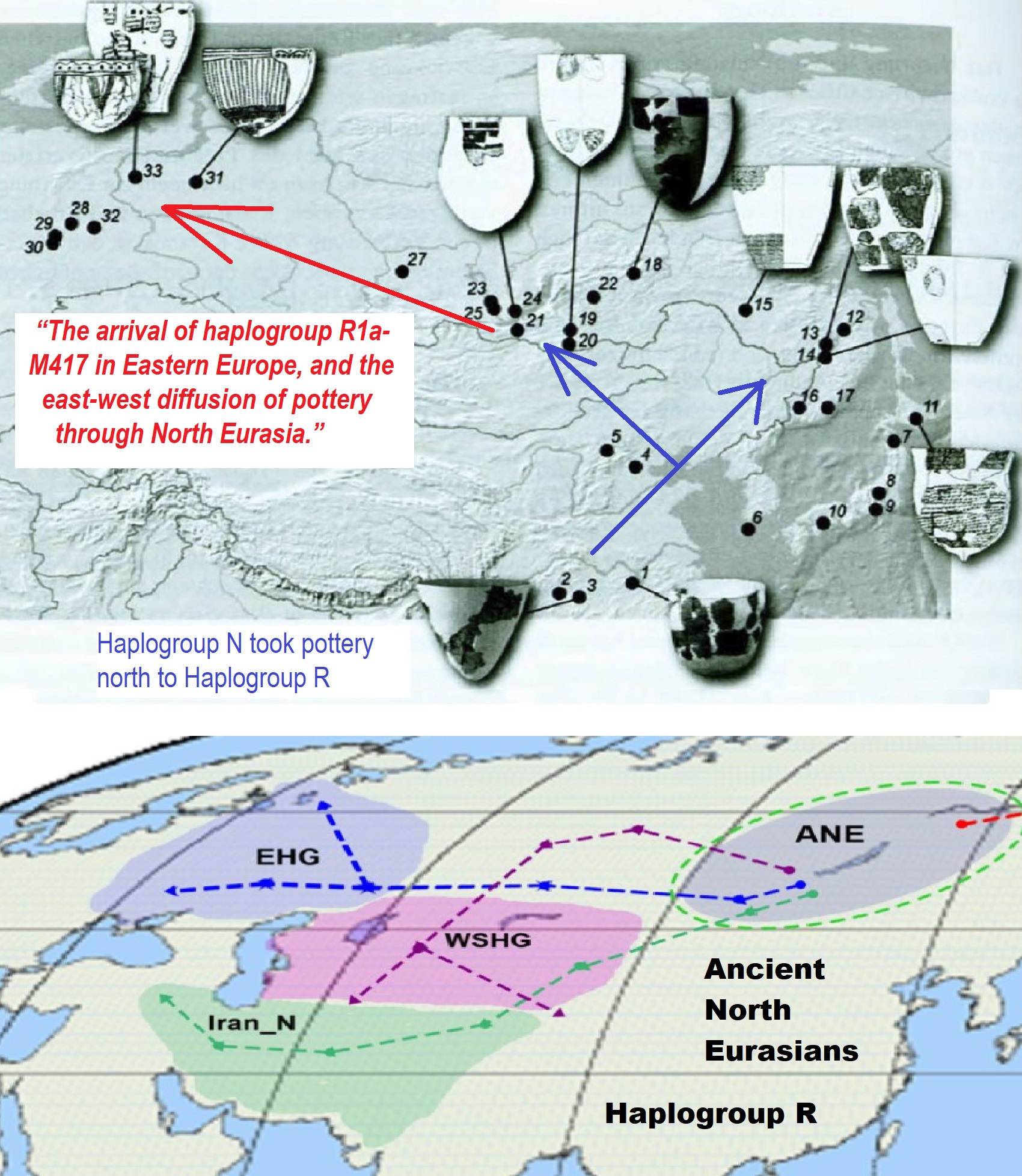
“The arrival of haplogroup R1a-M417 in Eastern Europe, and the east-west diffusion of pottery through North Eurasia.” https://indo-european.eu/2018/02/the-arrival-of-haplogroup-r1a-m417-in-eastern-europe-and-the-east-west-diffusion-of-pottery-through-north-eurasia/
Ancient North Eurasian https://en.wikipedia.org/wiki/Ancient_North_Eurasian
Ancient North Eurasian/Mal’ta–Buret’ culture haplogroup R* https://en.wikipedia.org/wiki/Mal%27ta%E2%80%93Buret%27_culture
“The arrival of haplogroup R1a-M417 in Eastern Europe, and the east-west diffusion of pottery through North Eurasia.” ref
R-M417 (R1a1a1)
“R1a1a1 (R-M417) is the most widely found subclade, in two variations which are found respectively in Europe (R1a1a1b1 (R-Z282) ([R1a1a1a*] (R-Z282) and Central and South Asia (R1a1a1b2 (R-Z93) ([R1a1a2*] (R-Z93).” ref
R-Z282 (R1a1a1b1a) (Eastern Europe)
“This large subclade appears to encompass most of the R1a1a found in Europe.
- R1a1a1b1a [R1a1a1a*] (R-Z282*) occurs in northern Ukraine, Belarus, and Russia at a frequency of c. 20%.
- R1a1a1b1a3 [R1a1a1a1] (R-Z284) occurs in Northwest Europe and peaks at c. 20% in Norway.
- R1a1a1c (M64.2, M87, M204) is apparently rare: it was found in 1 of 117 males typed in southern Iran.” ref
R1a1a1b2 (R-Z93) (Asia)
“This large subclade appears to encompass most of the R1a1a found in Asia, being related to Indo-European migrations (including Scythians, Indo-Aryan migrations, and so on).
- R-Z93* or R1a1a1b2* (R1a1a2* in Underhill (2014)) is most common (>30%) in the South Siberian Altai region of Russia, cropping up in Kyrgyzstan (6%) and in all Iranian populations (1-8%).
- R-Z2125 occurs at highest frequencies in Kyrgyzstan and in Afghan Pashtuns (>40%). At a frequency of >10%, it is also observed in other Afghan ethnic groups and in some populations in the Caucasus and Iran.
- R-M434 is a subclade of Z2125. It was detected in 14 people (out of 3667 people tested), all in a restricted geographical range from Pakistan to Oman. This likely reflects a recent mutation event in Pakistan.
- R-M560 is very rare and was only observed in four samples: two Burushaski speakers (north Pakistan), one Hazara (Afghanistan), and one Iranian Azerbaijani.
- R-M780 occurs at high frequency in South Asia: India, Pakistan, Afghanistan, and the Himalayas. The group also occurs at >3% in some Iranian populations and is present at >30% in Roma from Croatia and Hungary.” ref
R-M458 (R1a1a1b1a1)
“R-M458 is a mainly Slavic SNP, characterized by its own mutation, and was first called cluster N. Underhill et al. (2009) found it to be present in modern European populations roughly between the Rhine catchment and the Ural Mountains and traced it to “a founder effect that … falls into the early Holocene period, 7.9±2.6 KYA.” M458 was found in one skeleton from a 14th-century grave field in Usedom, Mecklenburg-Vorpommern, Germany. The paper by Underhill et al. (2009) also reports a surprisingly high frequency of M458 in some Northern Caucasian populations (for example 27.5% among Karachays and 23.5% among Balkars, 7.8% among Karanogays and 3.4% among Abazas).” ref
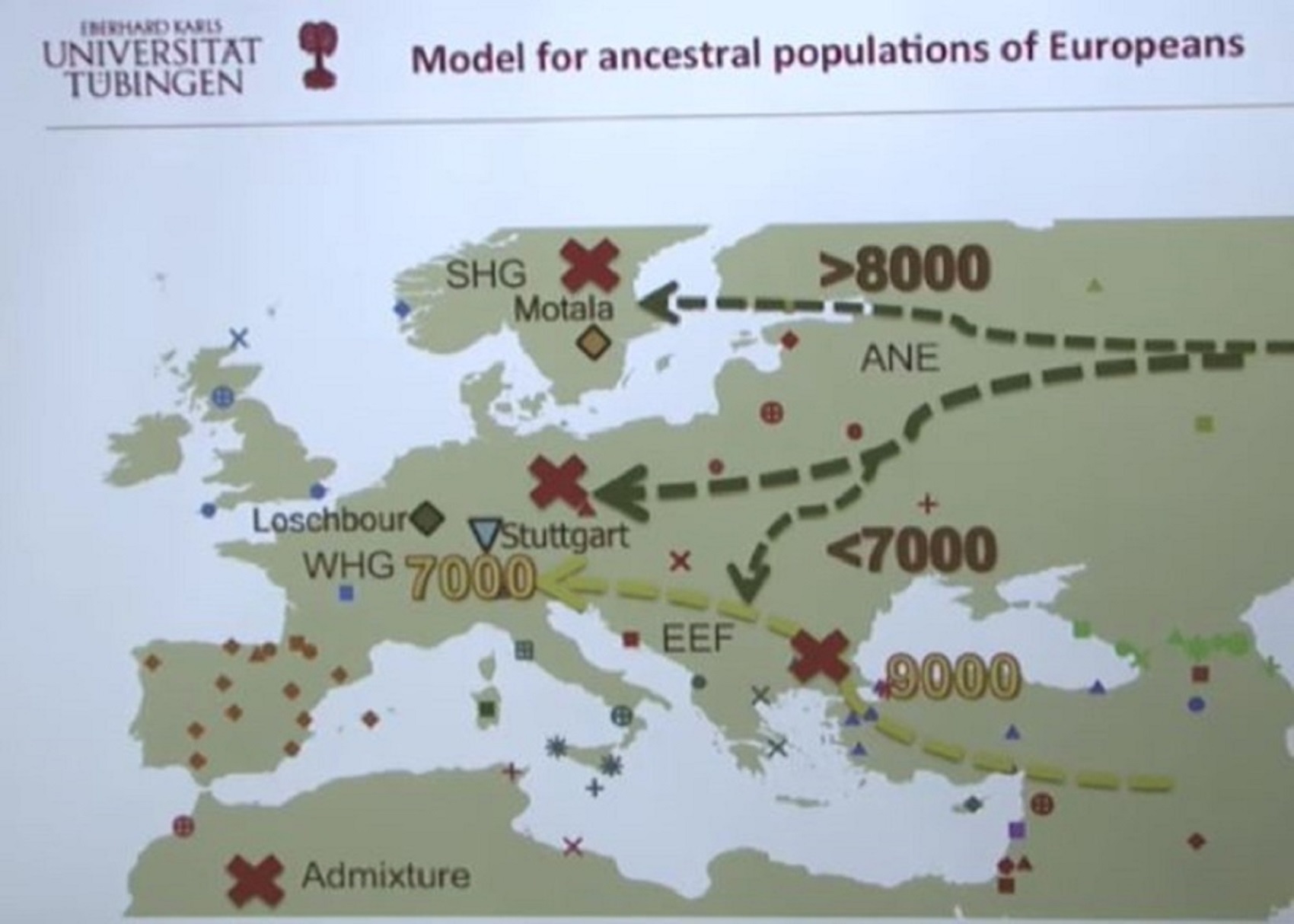
Pic ref
Ancient Human Genomes…Present-Day Europeans – Johannes Krause (Video)
Ancient North Eurasian (ANE)
Eastern Hunter-Gatherer (EHG)
Western Hunter-Gatherers (WHG)
Scandinavian Hunter-Gatherer (SHG)
Early European Farmers (EEF)
A quick look at the Genetic history of Europe
“The most significant recent dispersal of modern humans from Africa gave rise to an undifferentiated “non-African” lineage by some 70,000-50,000 years ago. By about 50–40 ka a basal West Eurasian lineage had emerged, as had a separate East Asian lineage. Both basal East and West Eurasians acquired Neanderthal admixture in Europe and Asia. European early modern humans (EEMH) lineages between 40,000-26,000 years ago (Aurignacian) were still part of a large Western Eurasian “meta-population”, related to Central and Western Asian populations. Divergence into genetically distinct sub-populations within Western Eurasia is a result of increased selection pressure and founder effects during the Last Glacial Maximum (LGM, Gravettian). By the end of the LGM, after 20,000 years ago, A Western European lineage, dubbed West European Hunter-Gatherer (WHG) emerges from the Solutrean refugium during the European Mesolithic. These Mesolithic hunter-gatherer cultures are substantially replaced in the Neolithic Revolution by the arrival of Early European Farmers (EEF) lineages derived from Mesolithic populations of West Asia (Anatolia and the Caucasus). In the European Bronze Age, there were again substantial population replacements in parts of Europe by the intrusion of Ancient North Eurasian (ANE) lineages from the Pontic–Caspian steppes. These Bronze Age population replacements are associated with the Beaker culture archaeologically and with the Indo-European expansion linguistically.” ref
“As a result of the population movements during the Mesolithic to Bronze Age, modern European populations are distinguished by differences in WHG, EEF, and ANE ancestry. Admixture rates varied geographically; in the late Neolithic, WHG ancestry in farmers in Hungary was at around 10%, in Germany around 25%, and in Iberia as high as 50%. The contribution of EEF is more significant in Mediterranean Europe, and declines towards northern and northeastern Europe, where WHG ancestry is stronger; the Sardinians are considered to be the closest European group to the population of the EEF. ANE ancestry is found throughout Europe, with a maximum of about 20% found in Baltic people and Finns. Ethnogenesis of the modern ethnic groups of Europe in the historical period is associated with numerous admixture events, primarily those associated with the Roman, Germanic, Norse, Slavic, Berber, Arab and Turkish expansions. Research into the genetic history of Europe became possible in the second half of the 20th century, but did not yield results with a high resolution before the 1990s. In the 1990s, preliminary results became possible, but they remained mostly limited to studies of mitochondrial and Y-chromosomal lineages. Autosomal DNA became more easily accessible in the 2000s, and since the mid-2010s, results of previously unattainable resolution, many of them based on full-genome analysis of ancient DNA, have been published at an accelerated pace.” ref
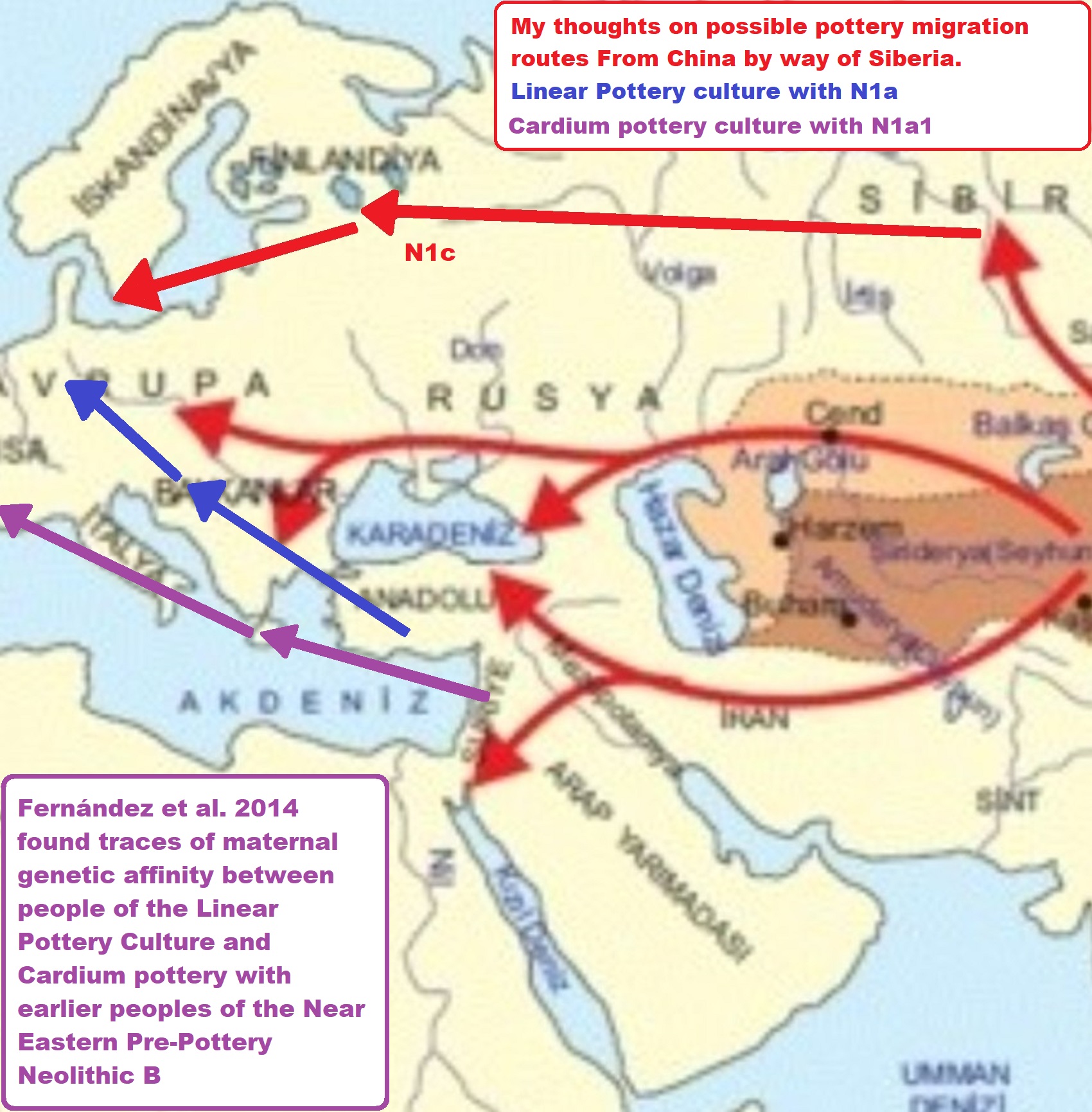
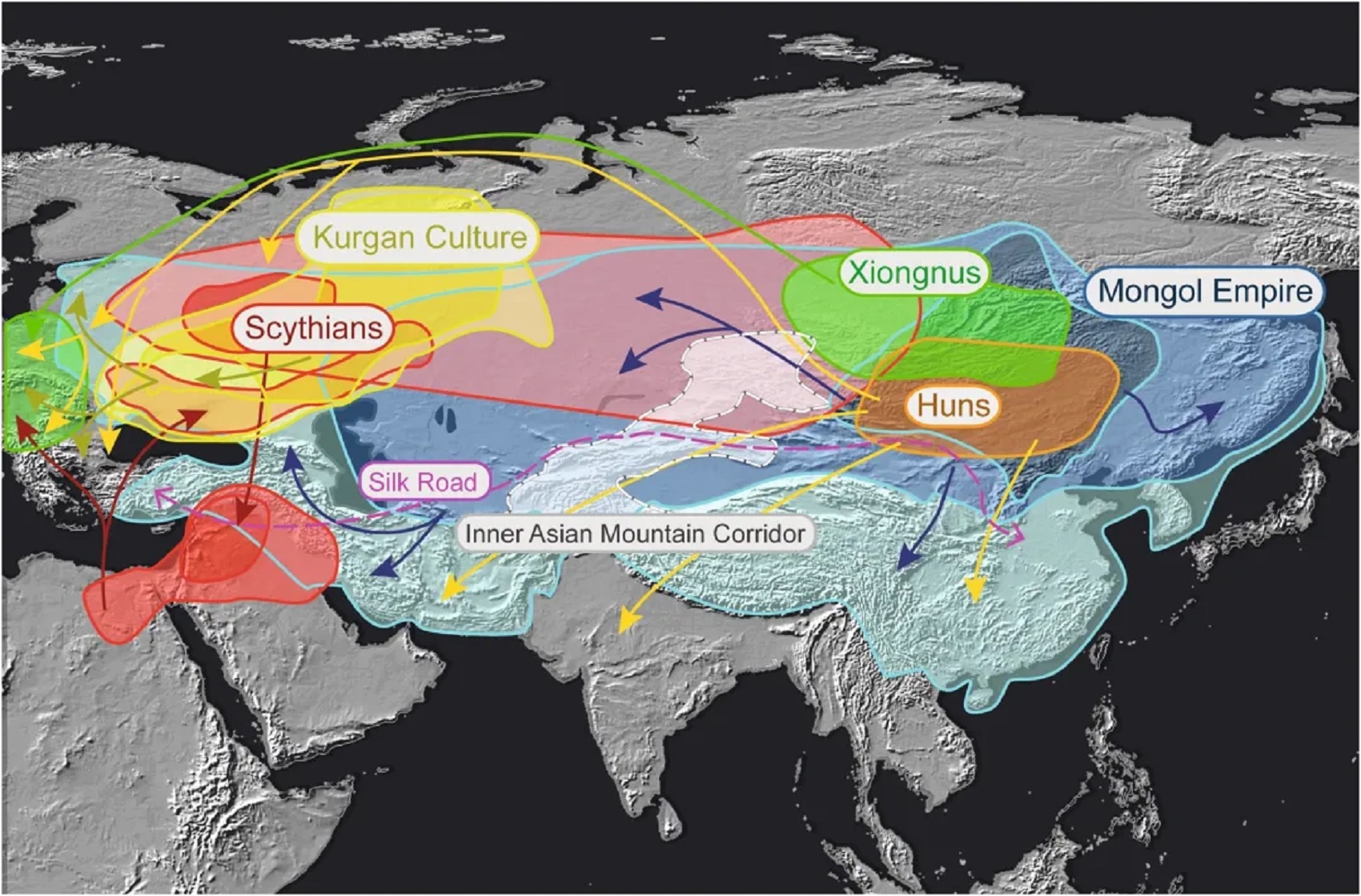
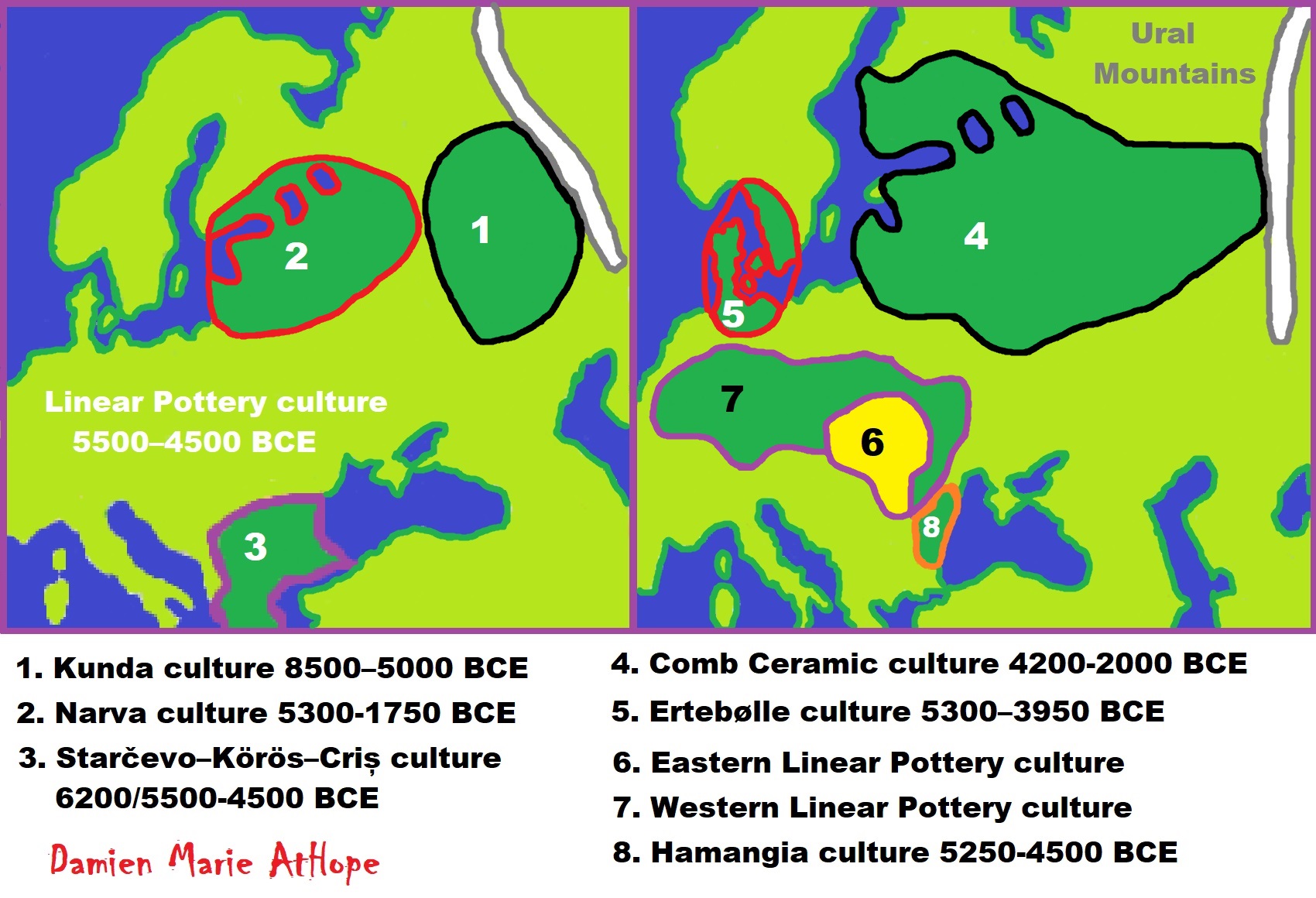
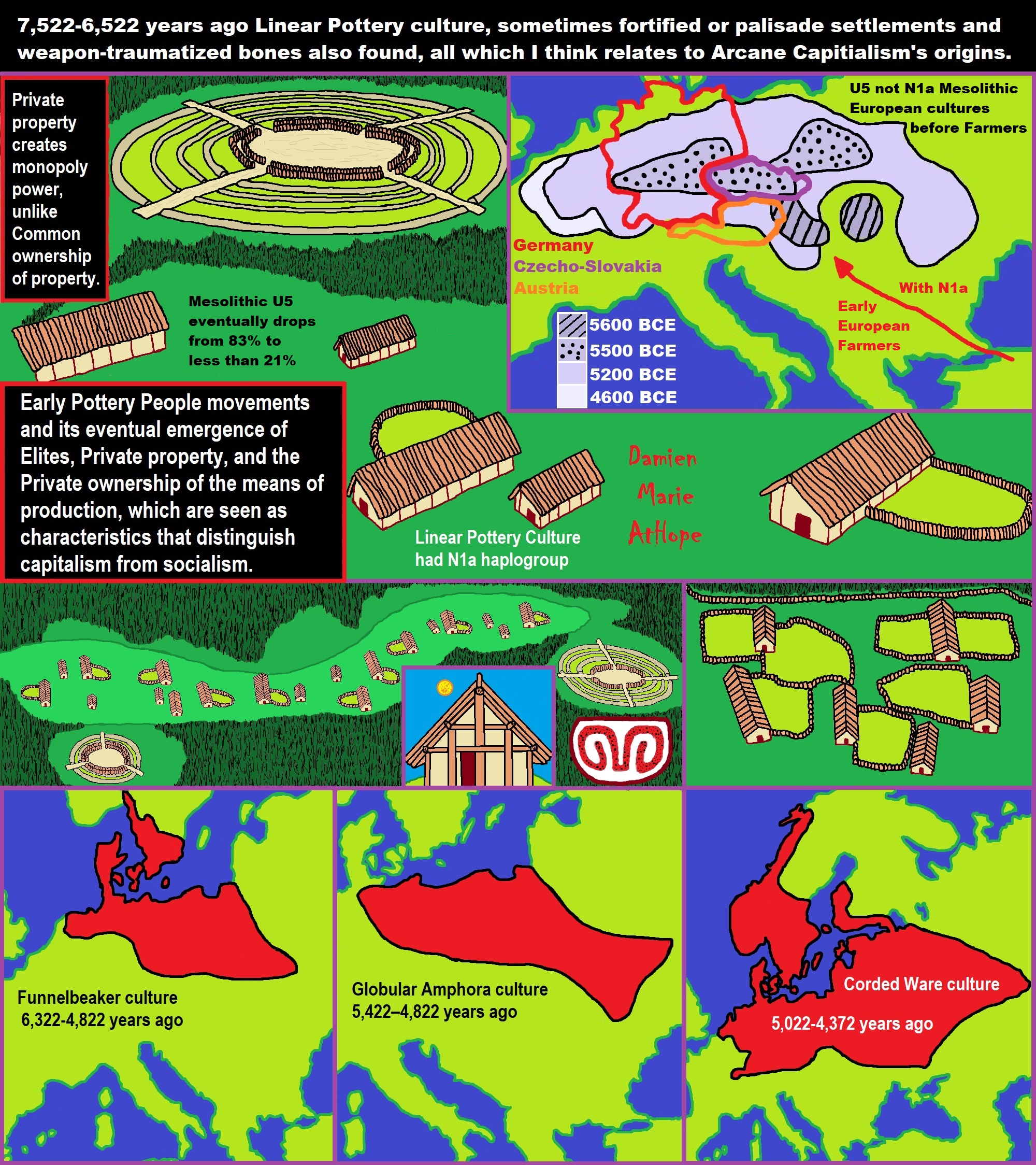
When the First Farmers Arrived in Europe, Inequality Evolved
“Forests gave way to fields, pushing hunter-gatherers to the margins—geographically and socially. There is no clear genetic evidence of interbreeding along the central European route until the (Linear Pottery culture 5500–4500 BCE or 7,522-6,522 years ago) LBK farmers reached the Rhine. And yet the groups mixed in other ways—potentially right from the beginning. A tantalizing hint of such interactions came from Gamba’s discovery of a hunter-gatherer bone in a farming settlement at a place called Tiszaszőlős-Domaháza in Hungary. But there was nothing more to be said about that individual. Was he a member of that community? A hostage? Someone passing through?” ref
“With later evidence, the picture became clearer. At Bruchenbrücken, a site north of Frankfurt in Germany, farmers, and hunter-gatherers lived together roughly 7,300 years ago in what Gronenborn calls a “multicultural” settlement. It looks as if the hunters may have come there originally from farther west to trade with the farmers, who valued their predecessors’ toolmaking techniques—especially their finely chiseled stone arrowheads. Perhaps some hunter-gatherers settled, taking up the farming way of life. So fruitful were the exchanges at Bruchenbrücken and other sites, Gronenborn says, that they held up the westward advance of farming for a couple of centuries.” ref
“There may even have been rare exceptions to the rule that the two groups did not interbreed early on. The Austrian site of Brunn 2, in a wooded river valley not far from Vienna, dates from the earliest arrival of the LBK farmers in central Europe, around 7,600 years ago. Three burials at the site were roughly contemporaneous. Two were of individuals of pure farming ancestry, and the other was the first-generation offspring of a hunter and a farmer. All three lay curled up on their sides in the LBK way, but the “hunter” was buried with six arrowheads.” ref
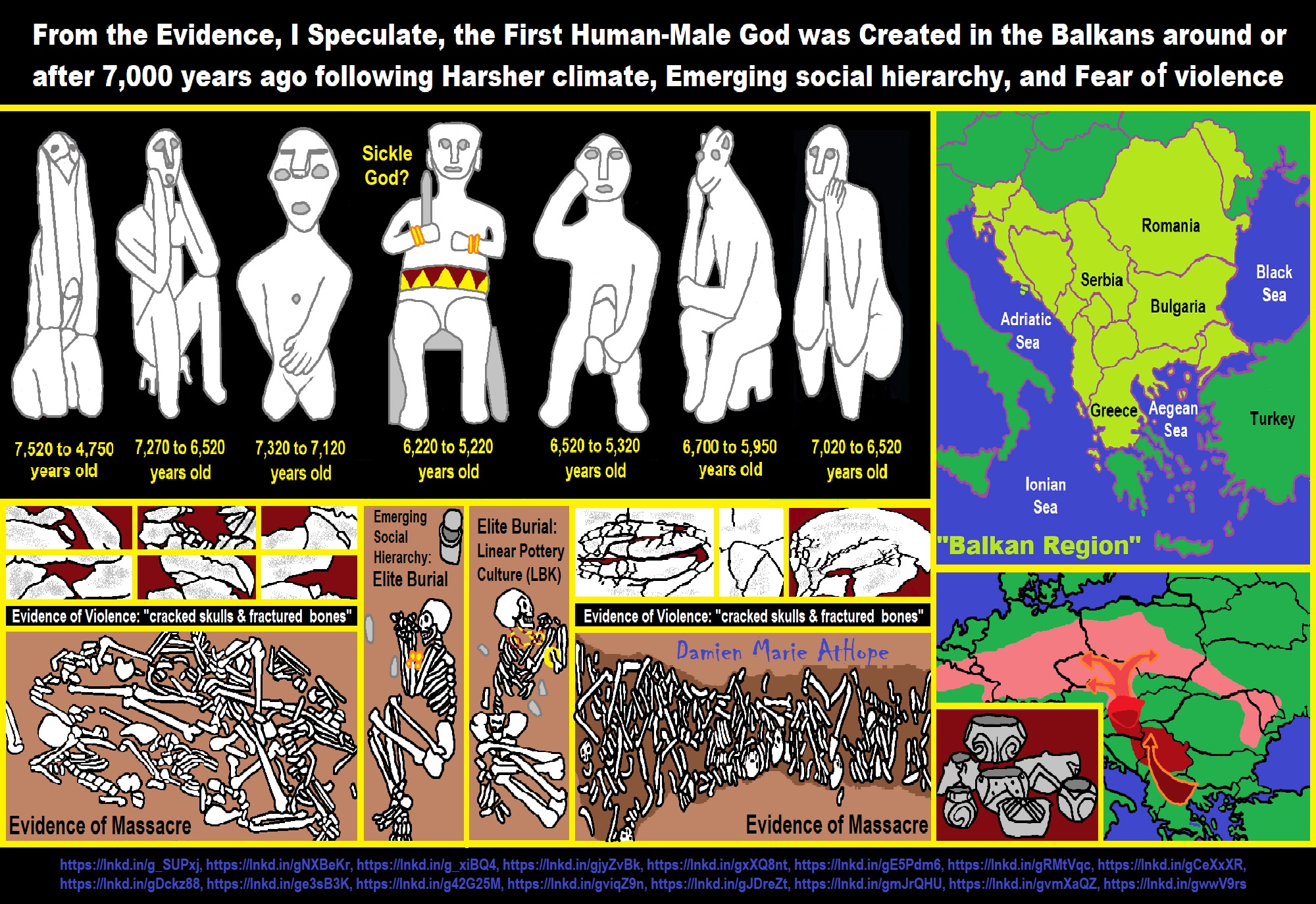

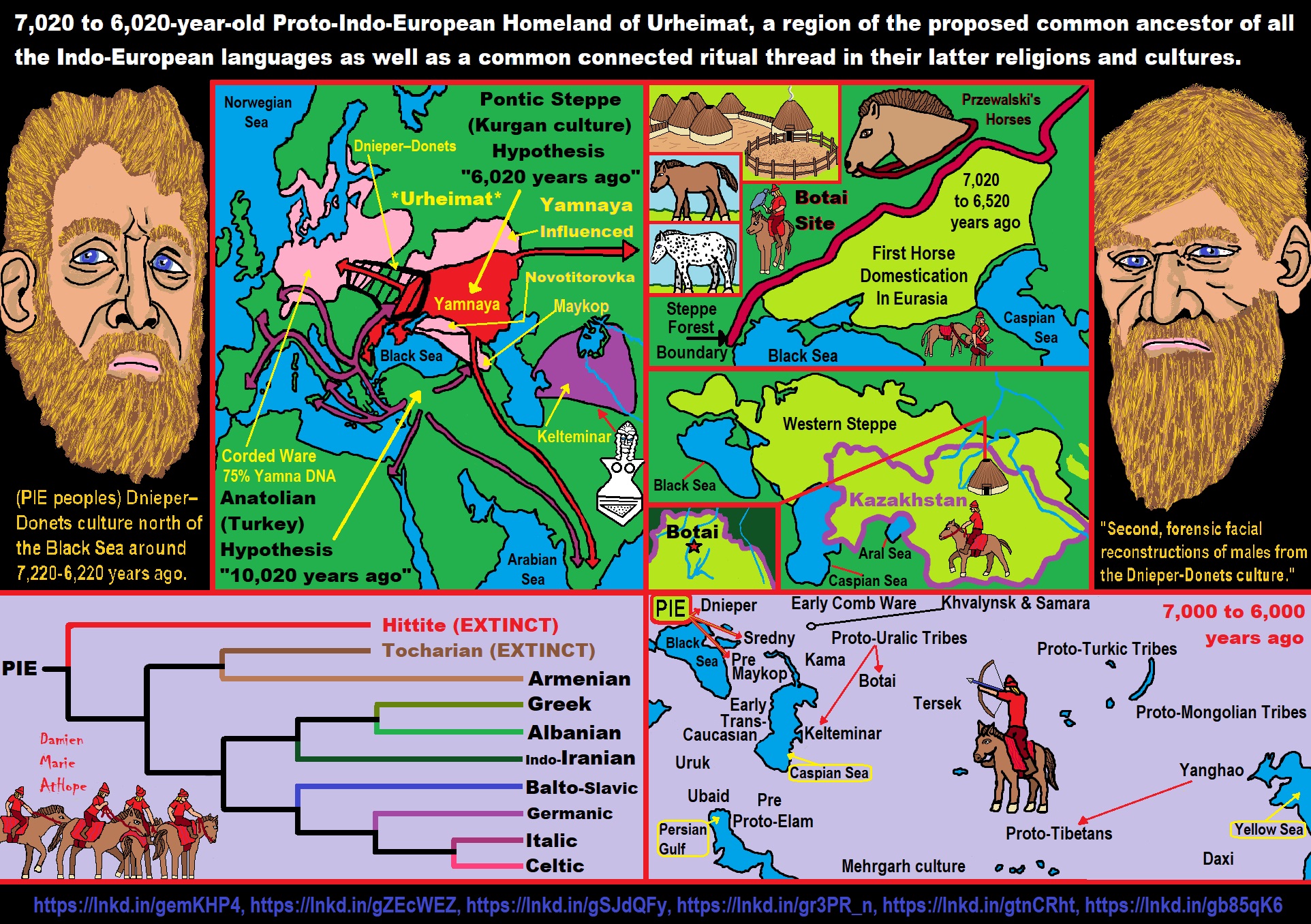
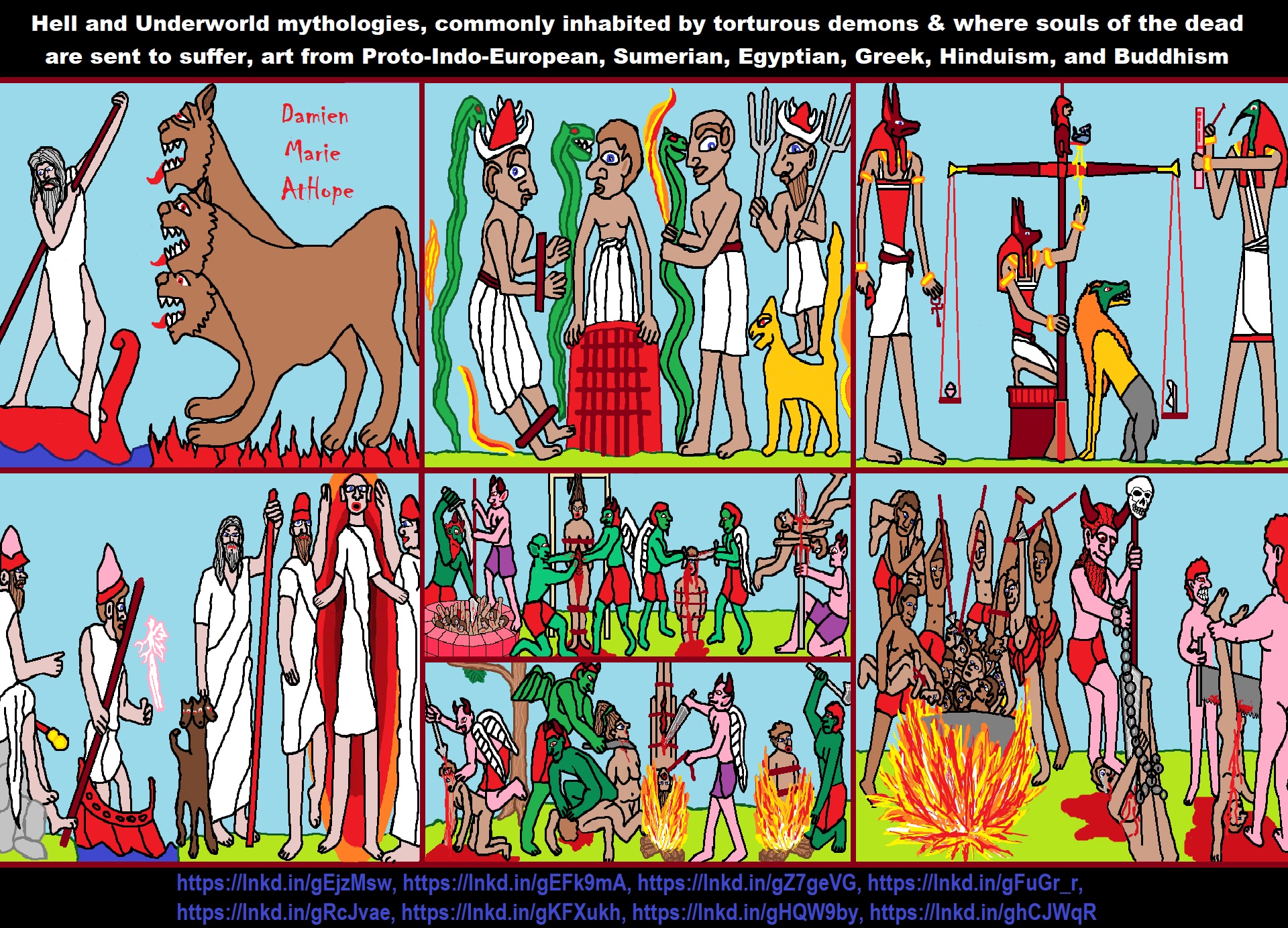

ref, ref, ref, ref, ref, ref, ref, ref, ref, ref, ref, ref
Masseboth similar but much smaller than a European Menhir, dates to around 13,000-11,000 years ago in the Near East. Kurgan a burial mound over a timber burial chamber, dates to around 7,000/6,000 years ago. Dolmen a single-chamber ritual megalith, dates to around 7,000/6,000 years ago. Ziggurat a multi-platform temple around 4,900 years ago. Pyramid a multi-platform tomb, dates to around 4,700 years ago. #3 is a Step Pyramid (or proto pyramid) for the burial of Pharaoh Djoser it went through several revisions and redevelopments. First are three layers of Mastaba “house of eternity” a flat-roofed rectangular structure, then two step pyramid one on top the other, showing the evolution of ideas.
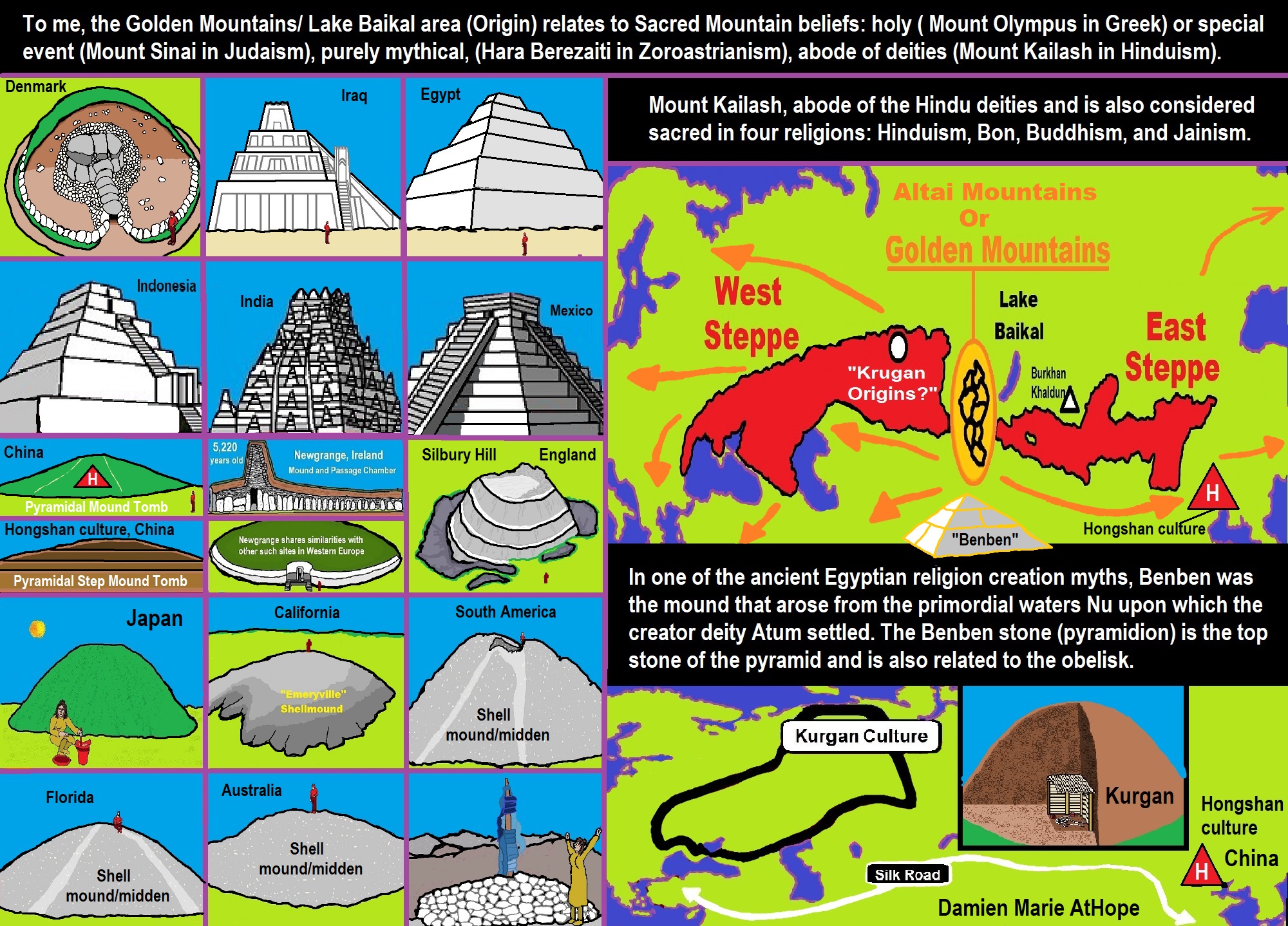



Pic ref
Ancient Women Found in a Russian Cave Turn Out to Be Closely Related to The Modern Population https://www.sciencealert.com/ancient-women-found-in-a-russian-cave-turn-out-to-be-closely-related-to-the-modern-population
Abstract
“Ancient genomes have revolutionized our understanding of Holocene prehistory and, particularly, the Neolithic transition in western Eurasia. In contrast, East Asia has so far received little attention, despite representing a core region at which the Neolithic transition took place independently ~3 millennia after its onset in the Near East. We report genome-wide data from two hunter-gatherers from Devil’s Gate, an early Neolithic cave site (dated to ~7.7 thousand years ago) located in East Asia, on the border between Russia and Korea. Both of these individuals are genetically most similar to geographically close modern populations from the Amur Basin, all speaking Tungusic languages, and, in particular, to the Ulchi. The similarity to nearby modern populations and the low levels of additional genetic material in the Ulchi imply a high level of genetic continuity in this region during the Holocene, a pattern that markedly contrasts with that reported for Europe.” ref
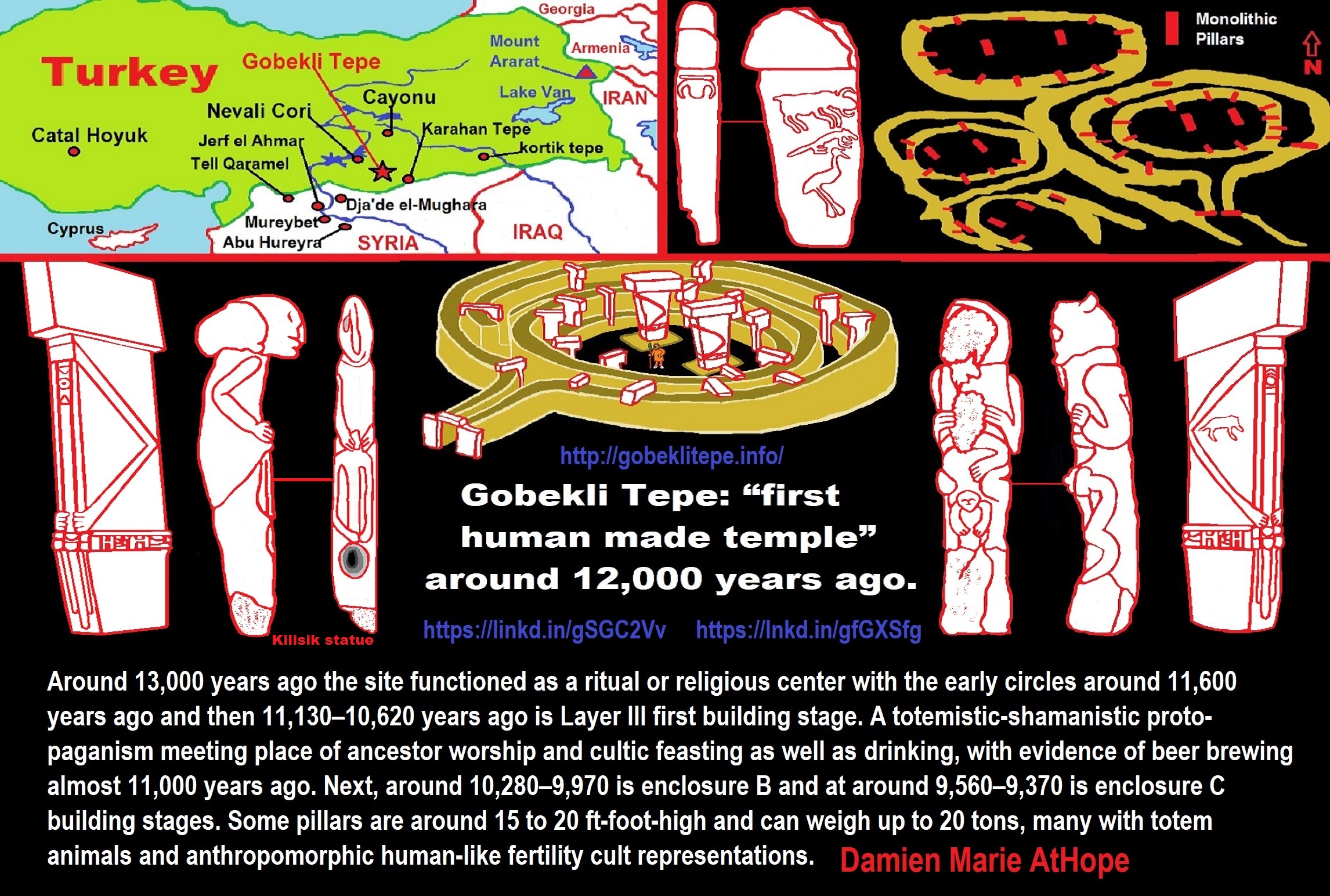

ref, ref, ref, ref, ref, ref, ref
Trialetian culture (16,000–8000 years ago) the Caucasus, Iran, and Turkey, likely involved in Göbekli Tepe. Migration 1?
Haplogroup R possible time of origin about 27,000 years in Central Asia, South Asia, or Siberia:
- Mal’ta–Buret’ culture (24,000-15,000 years ago)
- Afontova Gora culture (21,000-12,000 years ago)
- Trialetian culture (16,000–8000 years ago)
- Samara culture (7,000-6,500 years ago)
- Khvalynsk culture (7,000-6,500 years ago)
- Afanasievo culture (5,300-4,500 years ago)
- Yamna/Yamnaya Culture (5,300-4,500 years ago)
- Andronovo culture (4,000–2,900 years ago) ref
Trialetian sites
Caucasus and Transcaucasia:
- Edzani (Georgia)
- Chokh (Azerbaijan), layers E-C200
- Kotias Klde, layer B” ref
Eastern Anatolia:
- Hallan Çemi (from ca. 8.6-8.5k BC to 7.6-7.5k BCE)
- Nevali Çori shows some Trialetian admixture in a PPNB context” ref
Trialetian influences can also be found in:
- Cafer Höyük
- Boy Tepe” ref
Southeast of the Caspian Sea:
- Hotu (Iran)
- Ali Tepe (Iran) (from cal. 10,500 to 8,870 BCE)
- Belt Cave (Iran), layers 28-11 (the last remains date from ca. 6,000 BCE)
- Dam-Dam-Cheshme II (Turkmenistan), layers7,000-3,000 BCE)” ref
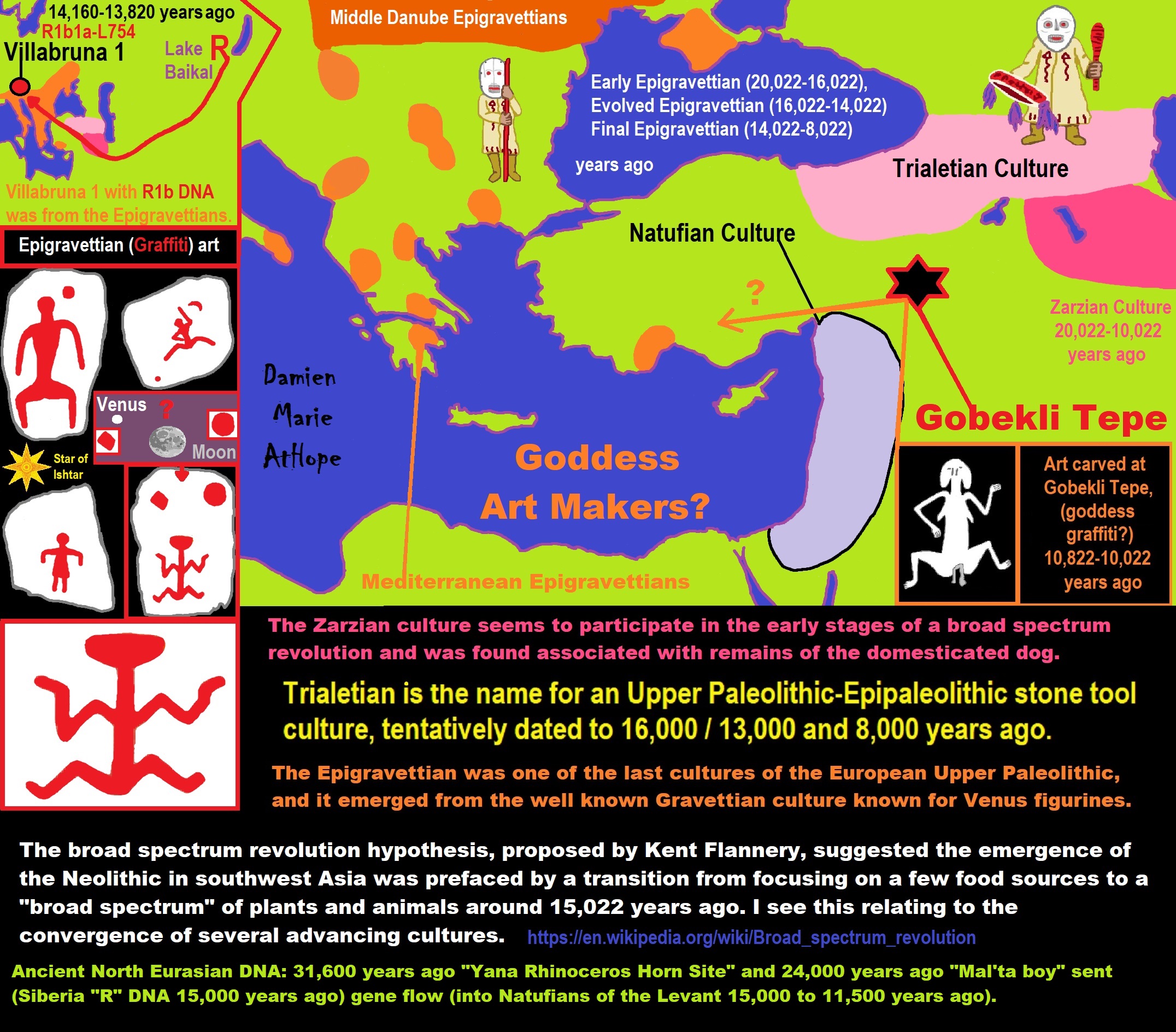
ref, ref, ref, ref, ref, ref, ref, ref, ref, ref, ref, ref, ref, ref, ref
Trialetian peoples which I think we’re more male-centric and involved in the creation of Göbekli Tepe, from its start around Pre-Pottery Neolithic A (12,000 – 10,800 years ago) began with their influence and this is seen in animal deities many clearly male and the figures also being expressively male themed as well at first, and only around Pre-Pottery Neolithic B (10,800 – 8,500 years ago) or so it seems with what I am guessing is new Epigravettian peoples with a more female-centric style (reminiscent but less than the Gravettians known for Venus figurines) influence from migration into the region, to gain new themes that add a female element both with A totem pole seeming to express birth or something similar and graffiti of a woman either ready for sex or giving birth or both. and Other bare figures seem to show a similar body position reminiscent of the graffiti of a woman.
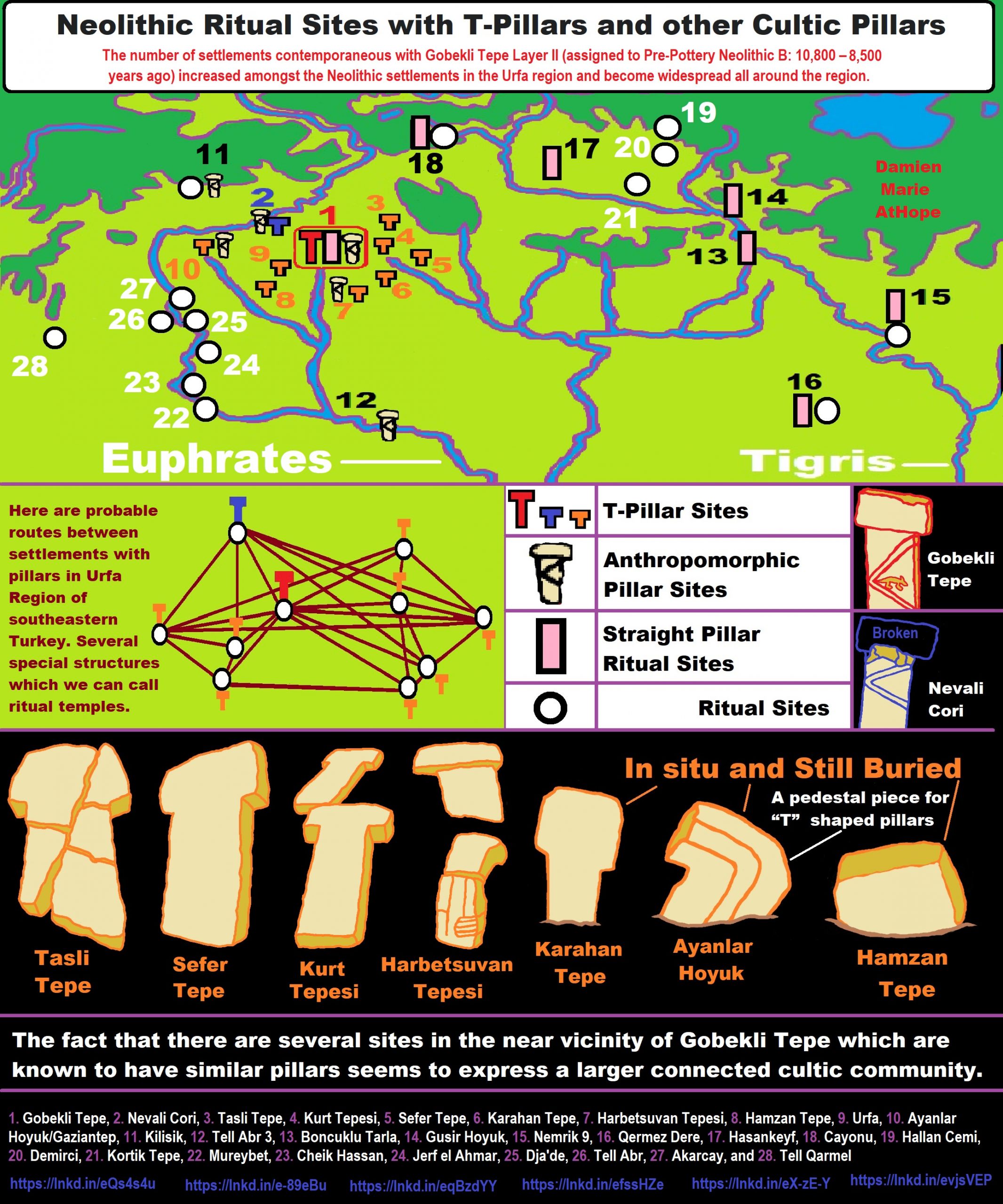
The number of settlements contemporaneous with Gobekli Tepe Layer II (assigned to Pre-Pottery Neolithic B: 10,800 – 8,500 years ago) increased amongst the Neolithic settlements in the Urfa region and become widespread all around the region.
- Gobekli Tepe, 2. Nevali Cori, 3. Tasli Tepe, 4. Kurt Tepesi, 5. Sefer Tepe, 6. Karahan Tepe, 7. Harbetsuvan Tepesi, 8. Hamzan Tepe, 9. Urfa, 10. Ayanlar Hoyuk/Gaziantep, 11. Kilisik, 12. Tell Abr 3, 13. Boncuklu Tarla, 14. Gusir Hoyuk, 15. Nemrik 9, 16. Qermez Dere, 17. Hasankeyf, 18. Cayonu, 19. Hallan Cemi, 20. Demirci, 21. Kortik Tepe, 22. Mureybet, 23. Cheik Hassan, 24. Jerf el Ahmar, 25. Dja’de, 26. Tell Abr, 27. Akarcay, and 28. Tell Qarmel
Göbekli Tepe is not alone, in fact, it is part of a religious/cultural connected ritual culture in the general region. There are several other similar sites with similar T-pillars to Göbekli Tepe or other types of stone pillar providing a seeming connected cult belief or religious culture of pillars seen in the PPNA-PPNB in the northern portion of the Near East.
“The locations of the sites that contain “T” shaped pillars are the main topic that needs more understanding to grasp the larger sociocultural-religious cultural complex in the same general region. Another matter under discussion is to comprehend the differences between the small-scale settlements that contain cult centers and “T” shaped pillars and the larger ones found at Gobekli Tepe layer III. The fact that settlements with “T” shaped pillars contain both the remains of circular domestic buildings and the pillars such as seen at Cayonu and Nevali Cori, which are also known to contain cult and domestic buildings. It is contemplated that such settlements are contemporary with Gobekli Tepe layer II and the cult building known from Nevali Cori based on the similarities and differences of the “T” shaped pillars. In the light of the finds unearthed from the settlements in Şanliurfa region that contain “T” shaped pillars, such settlements should be dated to the end of Late Pre-Pottery Neolithic A (LPPNA) and the Early Pre-Pottery Neolithic B (EPPNB).” ref

ref, ref, ref, ref, ref, ref, ref
Bear worship
“Bear worship (also known as the bear cult or arctolatry) is the religious practice of the worshipping of bears found in many North Eurasian ethnic religions such as among the Sami, Nivkh, Ainu, Basques, Germanic peoples, Slavs, and Finns. There are also a number of deities from Celtic Gaul and Britain associated with the bear, and the Dacians, Thracians, and Getians were noted to worship bears and annually celebrate the bear dance festival. The bear is featured on many totems throughout northern cultures that carve them. Bears were the most worshipped animals of Ancient Slavs. During pagan times, it was associated with the god Volos, the patron of domestic animals. Eastern Slavic folklore describes the bear as a totem personifying a male: father, husband, or a fiancé. Legends about turnskin bears appeared, it was believed that humans could be turned into bears for misbehavior.” ref
“Bears in Korean mythology, According to legend, Ungnyeo (literally “bear woman”) was a bear who turned into a woman, and gave birth to Dangun, the founder of the first Korean kingdom, Gojoseon. Bears were revered as motherly figures and as symbolic of patience. In Finnish paganism, the bear was considered a taboo animal and the word for “bear” (oksi) was a taboo word. Euphemisms such as mesikämmen “honey-hand” were used instead. Bear hunting and killing a bear was followed by a party called peijaiset with ceremony intended to show that the bear would be a “honored guest” instead of a slaughtered animal, and that its death was “accidental”, in order to not to anger the bear’s spirit. The skull of the bear was hung onto a tree, which was venerated as a totem.” ref
The bear festival is a religious festival celebrated by the indigenous Nivkh in Russia’s far east. A Nivkh shaman (ch’am) would preside over the Bear Festival, celebrated in the winter between January and February depending on the clan. Bears were captured and raised in a corral for several years by local women, treating the bear like a child. The bear is considered a sacred earthly manifestation of Nivkh ancestors and the gods in bear form. During the Festival, the bear is dressed in a specially made ceremonial costume and offered a banquet to take back to the realm of gods to show benevolence upon the clans. After the banquet, the bear is killed and eaten in an elaborate religious ceremony. The festival was arranged by relatives to honor the death of a kinsman. The bear’s spirit returns to the gods of the mountain ‘happy’ and rewards the Nivkh with bountiful forests. Generally, the Bear Festival was an inter-clan ceremony where a clan of wife-takers restored ties with a clan of wife-givers upon the broken link of the kinsman’s death. The Bear Festival was suppressed in the Soviet period; since then the festival has had a modest revival, albeit as a cultural rather than a religious ceremony.” ref
The Ainu people, who live on select islands in the Japanese archipelago, call the bear “kamuy” in their language, which translates to mean “god” similar to Kami. While many other animals are considered to be gods in the Ainu culture, the bear is the head of the gods. For the Ainu, when the gods visit the world of man, they don fur and claws and take on the physical appearance of an animal. Usually, however, when the term “kamuy” is used, it essentially means a bear. The Ainu people willingly and thankfully ate the bear as they believed that the disguise (the flesh and fur) of any god was a gift to the home that the god chose to visit. While on Earth – the world of man – the Ainu believed that the gods appeared in the form of animals. The gods had the capability of taking human form, but they only took this form in their home, the country of the gods, which is outside the world of man. To return a god back to his country, the people would sacrifice and eat the animal sending the god’s spirit away with civility. This ritual is called Omante and usually involves a deer or adult bear.” ref
“Kami (Japanese: are the deities, divinities, spirits, phenomena, or “holy powers”), that are venerated in the religion of Shinto. They can be elements of the landscape, forces of nature, or beings and the qualities that these beings express; they can also be the spirits of venerated dead people. Many kami are considered the ancient ancestors of entire clans (some ancestors became kami upon their death if they were able to embody the values and virtues of kami in life).” ref
“Omante occurred when the people sacrificed an adult bear, but when they caught a bear cub they performed a different ritual which is called Iomante, in the Ainu language, or Kumamatsuri in Japanese. Kumamatsuri translates to “bear festival” and Iomante means “sending off”. The event of Kumamatsuri began with the capture of a young bear cub. As if he was a child given by the gods, the cub was fed human food from a carved wooden platter and was treated better than Ainu children for they thought of him as a god. If the cub was too young and lacked the teeth to properly chew food, a nursing mother will let him suckle from her own breast. When the cub reaches 2–3 years of age, the cub is taken to the altar and then sacrificed. Usually, Kumamatsuri occurs in midwinter when the bear meat is the best from the added fat. The villagers will shoot it with both normal and ceremonial arrows, make offerings, dance, and pour wine on top of the cub corpse. The words of sending off for the bear god are then recited. This festival lasts for three days and three nights to properly return the bear god to his home.” ref
Bear Goddesses and Gods Across Ancient Cultures
“Gods and goddesses of the ancient world held a connection with certain animals. This is because our ancestors’ beliefs were animistic – they believed everything on earth had consciousness. Wildlife was sacred in ancient times. The bear is one of the most powerful and most feared of the animal kingdom. Dating back thousands of years, the people of Europe left their marks on cave walls—some of these drawings were of bears. Moreover, shamans have revered the bear for its power, but also for its motherhood qualities and healing abilities. Bear medicine is strong medicine. It’s no wonder ancient gods and goddesses were connected to the bear. Learn of the bear goddesses and a bear god here.” ref
The Greek Bear Goddesses
“The typical illustration of Artemis, Greek Goddess of the Hunt, depicts her with either a hunting dog or stag. However, one of Artemis’ most sacred animals was the bear. Artemis had domain over the forest and all wildlife within it. The bear was the largest and most powerful animal, and so Artemis found it to be a special animal. Any time a bear was killed by the Greeks, Artemis would lay a plague on the people as punishment. Artemis’ cult spread over Greece. In Brauron, young girls played she-bears in honor of Artemis and as a preparation for motherhood. They wore bear masks and acted wildly in worship of her. Artemis’ name is theorized to have meant bear-sanctuary. If we break it down—art is close to ark which means bear, and temis is close to temnis which means sanctuary. We will see in the next section how another Goddess’ name reflects this etymology.” ref
“Another close association between Artemis and bears is in the tale of one of Artemis’ followers named Callisto. Callisto was a nymph (demi-god nature spirit), and as followers of Artemis, women were charged to stay chaste and pure from men. Callisto was lured into having relations with Zeus, who impregnated her. When Artemis found out, she changed Callisto into a bear. Other versions say Athena was angered when Zeus impregnated the nymph and so she turned Callisto into a bear. The constellations Ursa Major and Ursa Minor (known to the Greeks as Arktos—bear) are said to be the soul remnants of Callisto and her son, and were placed in the sky by Zeus himself.” ref
Celtic Bear Goddess
“We don’t know a lot about Artio, the Bear Goddess of the ancient Celtic-Gauls, but we know she was intimately connected to bears. The few pieces of evidence we have of her cult’s existence were found in Switzerland and southern Germany. A bronze statue depicting Artio feeding a giant bear surfaced in Bern, Switzerland. Scholars say Artio feeds the bear with a bowl of fruit in her lap. But could it be the other way around? It seems to me the goddess is being confronted by the bear and she is not backing down. There was once a great tale about this encounter, I am sure; however, over time the lore of Artio has been lost. The inscription on the Bern statue translates to “for the goddess Artio”. As with Artemis’ name, there is a clear link to the bear in Artio’s name. Art translates to bear in Gaulish. Could Artio, the Bear Goddess of the Gauls, be the same goddess as the Greeks’ bear goddess Artemis?” ref
Hungarian Bear Goddess
“Much of what we know of the Hungarian Bear Goddess Ildiko has been lost in time, or perhaps is just not readily accessible by my research methods. However, according to the Encyclopedia of Spirits by Judika Iles, Ildiko was a goddess of the forest and wildlife. One of her most sacred animals was the bear. Ildiko was like Artemis – she was the goddess of the hunt but also a protector of forest animals. This is because of the need for balance—she guides the hunters but also protects animals in need of preservation or honor. Ildiko is a common name in Hungary with a Germanic origin meaning “warrior”. We can see how a warrior goddess would also be keen of bears—power, wisdom, and ferocity.” ref
Finnish Bear Goddess
“Above all, Mielikki is a healing goddess of Finland. She is associated with the woods and with wildlife, just as Artemis and Ildiko, but her main attribute is her healing abilities. She heals the animals when they are sick or wounded. This corresponds directly with the medicine of the bear. Shamans know bears to be healers, and so Mielikki is like the bear in this way. Mielikki is one of the bear goddesses who had a part in the creation of the bear. The story goes that Mielikki left earth and traveled into space, past the moon, in search of the materials with which to make the perfect animal. She returned and stitched together the materials from the heavens to make the bear. The bear is Mielikki’s favorite animal, above all. The tale of Mielikki going into space to find the materials to make the bear correlates nicely with the tales of the other Bear Goddesses Artemis, Callisto, and Zeus putting Callisto into the sky to make the Ursa Major and Minor constellations. There is an asteroid and a mountain on the planet Venus named for Mielikki.” ref
Slavs and the bear worship
“Bear was one of the most worshipped animals among the ancient Slavic tribes. It was connected to the god Volos, who was the protector of animals and wilderness. In Slavic folklore, the bear is usually depicted as a male, either as a father, husband or groom.” ref
Norse or Germanic pagans Odin: The All-Father and Bear God
“Odin is a popular god among Norse and Germanic pagans and his cult has spread to nearly every part of the modern world. He is known as the All-Father, the One-Eyed, and the terrifying one. He is a wise, yet powerful god and knows how to win a battle. Because of this, warriors and magicians of ancient times sought Odin for his knowledge and ferocity. When depicted, he is usually illustrated as an old man with white hair and beard, cloaked, and carrying a staff. One of his eyes is missing, a sacrifice Odin made to tap into the wisdom of the well of Urðr. Odin is almost always flanked by two of his totem animals—ravens and wolves. However, some claim Odin may also be guarded by two great bears. I’ve yet to find solid evidence of this claim; however, this could be in part because of Odin’s association with the berserkers (shaman warriors) who often wore the pelts of bears. Either way, a god of war, wisdom, healing, and trickery such as Odin would be well received as a friend of the bear.” ref
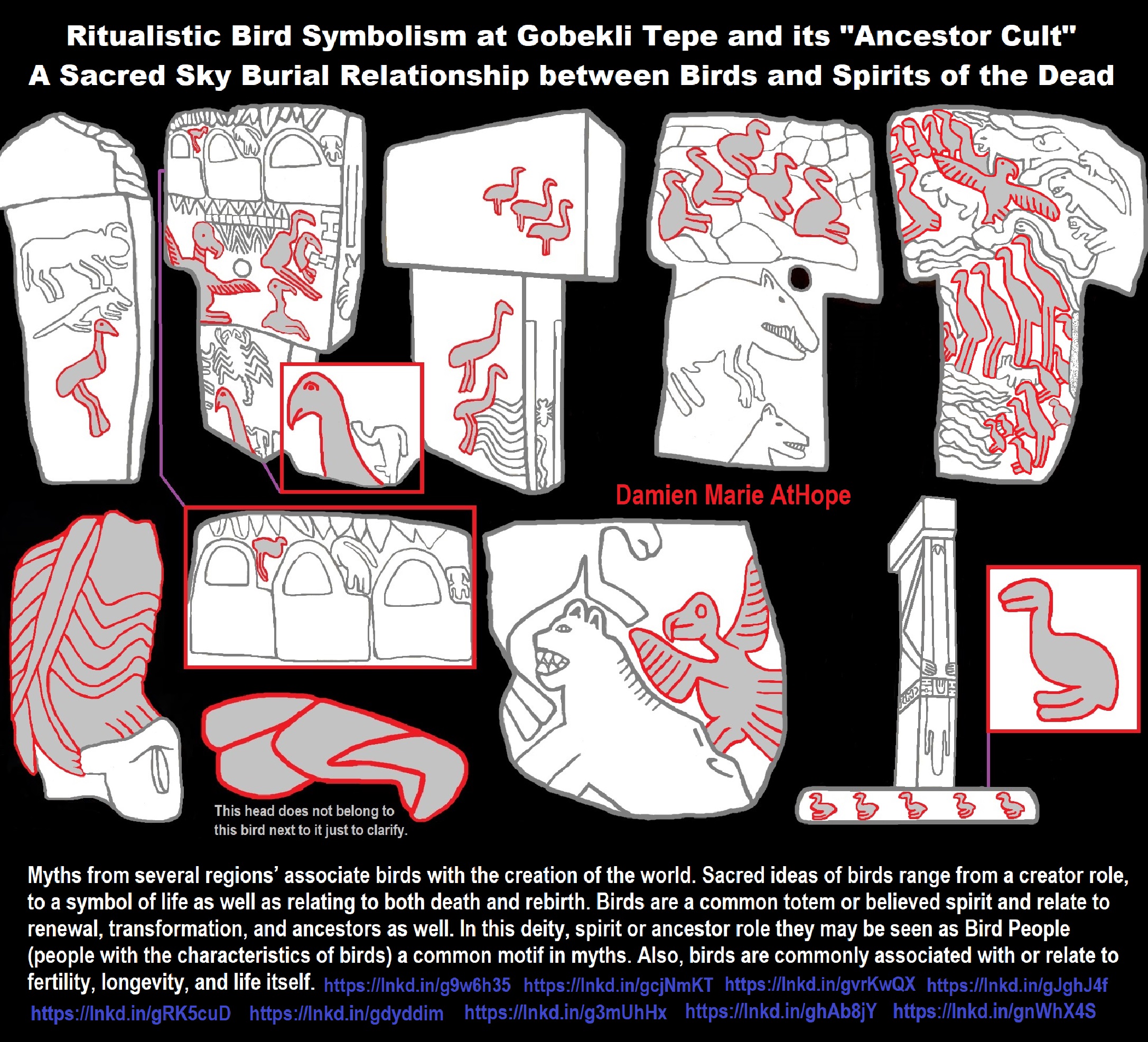
ref, ref, ref, ref, ref, ref, ref, ref, ref, ref, ref, ref, ref, ref, ref, ref, ref
Gobekli Tepe: “first human made temple” around 12,000 years ago
Ritualistic Bird Symbolism at Gobekli Tepe and its “Ancestor Cult” a Sacred Sky Burial Relationship between Birds and Spirits of the Dead
Myths from several regions’ associate birds with the creation of the world. Sacred ideas of birds range from a creator role, to a symbol of life as well as relating to both death and rebirth. Birds are a common totem or believed spirit and relate to renewal, transformation, and ancestors as well. In this deity, spirit or ancestor role they may be seen as Bird People (people with the characteristics of birds) a common motif in myths. Also, birds are commonly associated with or relate to fertility, longevity, and life itself.

ref, ref, ref, ref, ref, ref, ref, ref
Sky Burials: Animism, Totemism, Shamanism, and Paganism
“In archaeology and anthropology, the term excarnation (also known as defleshing) refers to the practice of removing the flesh and organs of the dead before burial, leaving only the bones. Excarnation may be precipitated through natural means, involving leaving a body exposed for animals to scavenge, or it may be purposefully undertaken by butchering the corpse by hand. Practices making use of natural processes for excarnation are the Tibetan sky burial, Comanche platform burials, and traditional Zoroastrian funerals (see Tower of Silence). Some Native American groups in the southeastern portion of North America practiced deliberate excarnation in protohistoric times. Archaeologists believe that in this practice, people typically left the body exposed on a woven litter or altar.” ref
Ancient Headless Corpses Were Defleshed By Griffon Vultures
Sky burial ( Animal Worship mixed with Ancestor Worship) is a funeral practice where a human corpse is placed on a mountaintop, elevated ground, tree, or constructed perch to decompose while be eaten by scavenging animals, especially birds. This Animal Worship (or Zoolatry) rituals may go back to the Neanderthals who seem to Sacralize birds starting around 130,000 years ago in Croatia with eagle talon jewelry and oldest confirmed burial. Or possible (Aurignacian) “Bird Worship” at Hohle Fels cave, Germany, early totemism and small bird figurine at around 33,000 years old, which had been cited as evidence of shamanism.
As well as possible ‘Bird Worship’ (in the Pavlovian culture/Gravettian culture) part of Early Shamanism at Dolní Věstonice (Czech Republic) from around 31,000-25,000 years ago, which held the “first shaman burial.” The shamanistic Mal’ta–Buret’ culture of Siberia, dating to 24,000-15,000 years ago, who connect to the indigenous peoples of the Americas show Bird Worship. The Magdalenian cultures in western Europe, dating from around 17,000-12,000 years ago have a famous artistic mural with a bird that I think could relate to reincarnation and at least bird symbolism. Likewise, there is evidence of possible ‘Bird Worship’ at Göbekli Tepe (Turkey), dated to around 13,000/11,600-9,370 Years ago with “first human-made temple” and at Çatalhöyük (Turkey), dated to around 9,500-7,700 Years ago with “first religious designed city” both with seeming ancestor, animal, and possible goddess worship.
The Tibetan sky-burials appear to have evolved from ancient practices of defleshing corpses as discovered in archeological finds in the region. These practices most likely came out of practical considerations, but they could also be related to more ceremonial practices similar to the suspected sky burial evidence found at Göbekli Tepe (11,500 years ago) and Stonehenge (4,500 years ago). ref


ref, ref, ref, ref, ref, ref, ref
Stonehenge: Paganistic Burial and Astrological Ritual Complex, England (5,100-3,600 years ago)
*Around 5,000 years ago Stonehenge (Britain):
Stonehenge: Paganistic Burial and Astrological Ritual Complex, England.
Stonehenge evolved in several construction phases, 1 (5,100 years ago), 2 (5,000 years ago), 3 I (4,600 years ago), 3 II (4,600-4,400 years ago), 3 III (2400-4,280 years ago), 3 IV (4,280-3,930 years ago), & 3 V (3,930-3,600 years ago). Anatolian/Turkish-farmers built Britain’s famous Stonehenge, as well as current males of Britain, 60-65% have Turkish genetics. Almost as the same as in Ireland where 85 percent of Irish men are descended from farming people that arrived 6,000 years ago. At or around Stonehenge 5,000-4,400 years ago, there were two separate burial rites, either letting the birds feed on bodies or cremation. And a 4,000-year-old burial pit for elite contains 14 females and only 9 males, as well as a chieftain’s grave, held several items including the depicted 4,000-year-old dagger. And a 4,000-year-old child’s grave held the depicted Folkton drums. As well as items from 4,600-3,600 involved gold beads, necklaces, earrings, pendants, and other jewelry show sophisticated burial culture. ref, ref, ref, ref, ref, ref, & ref

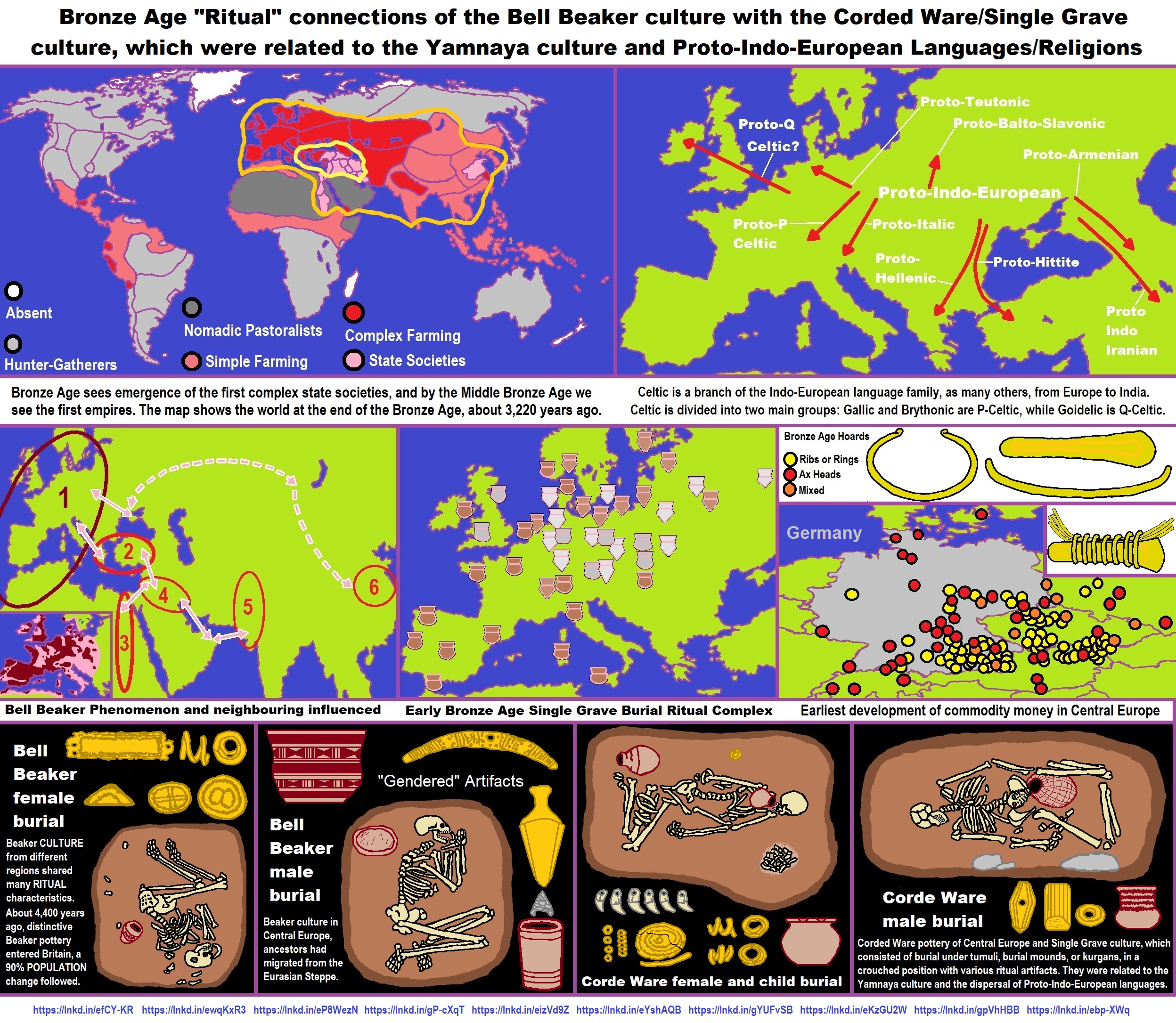
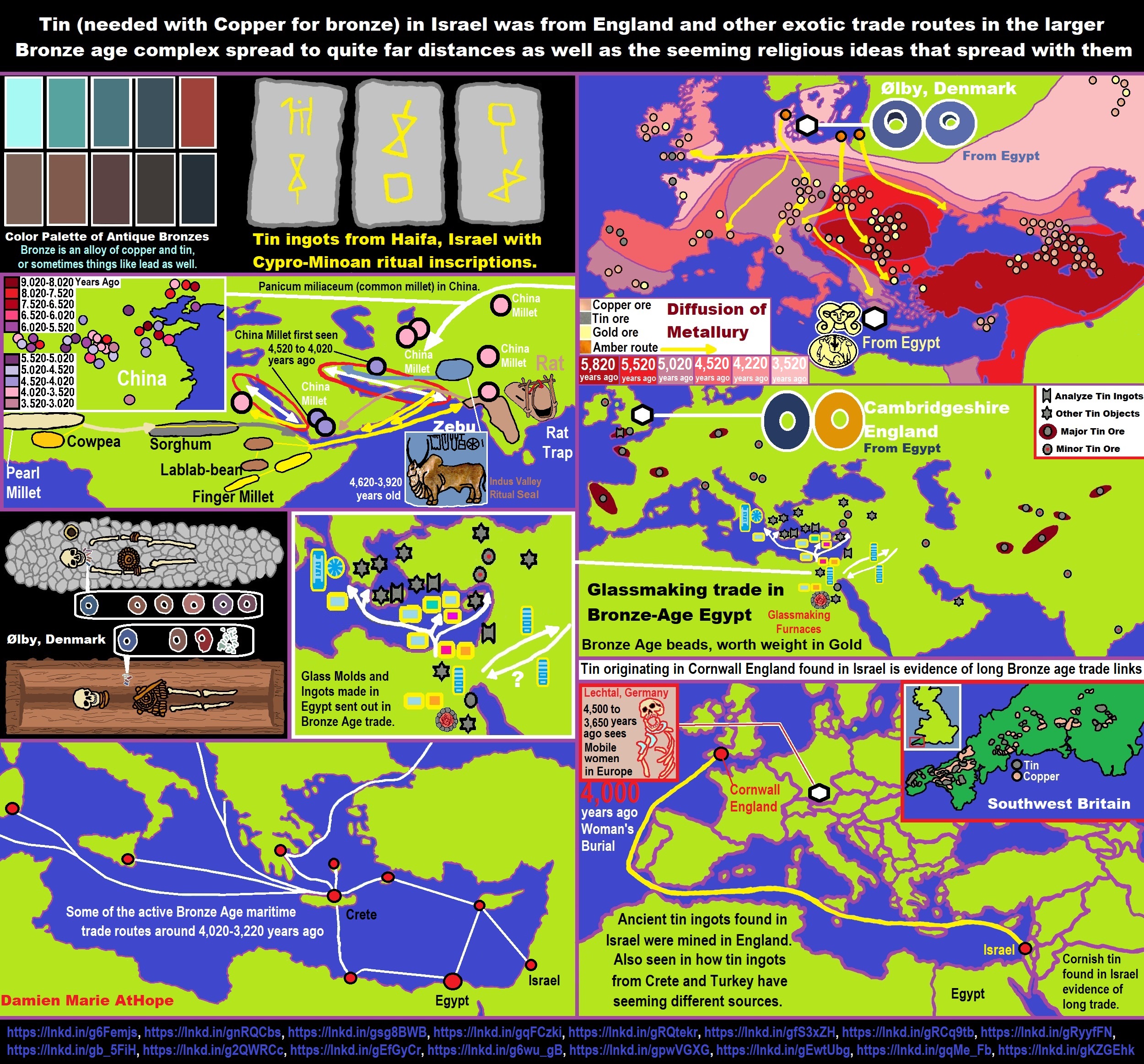
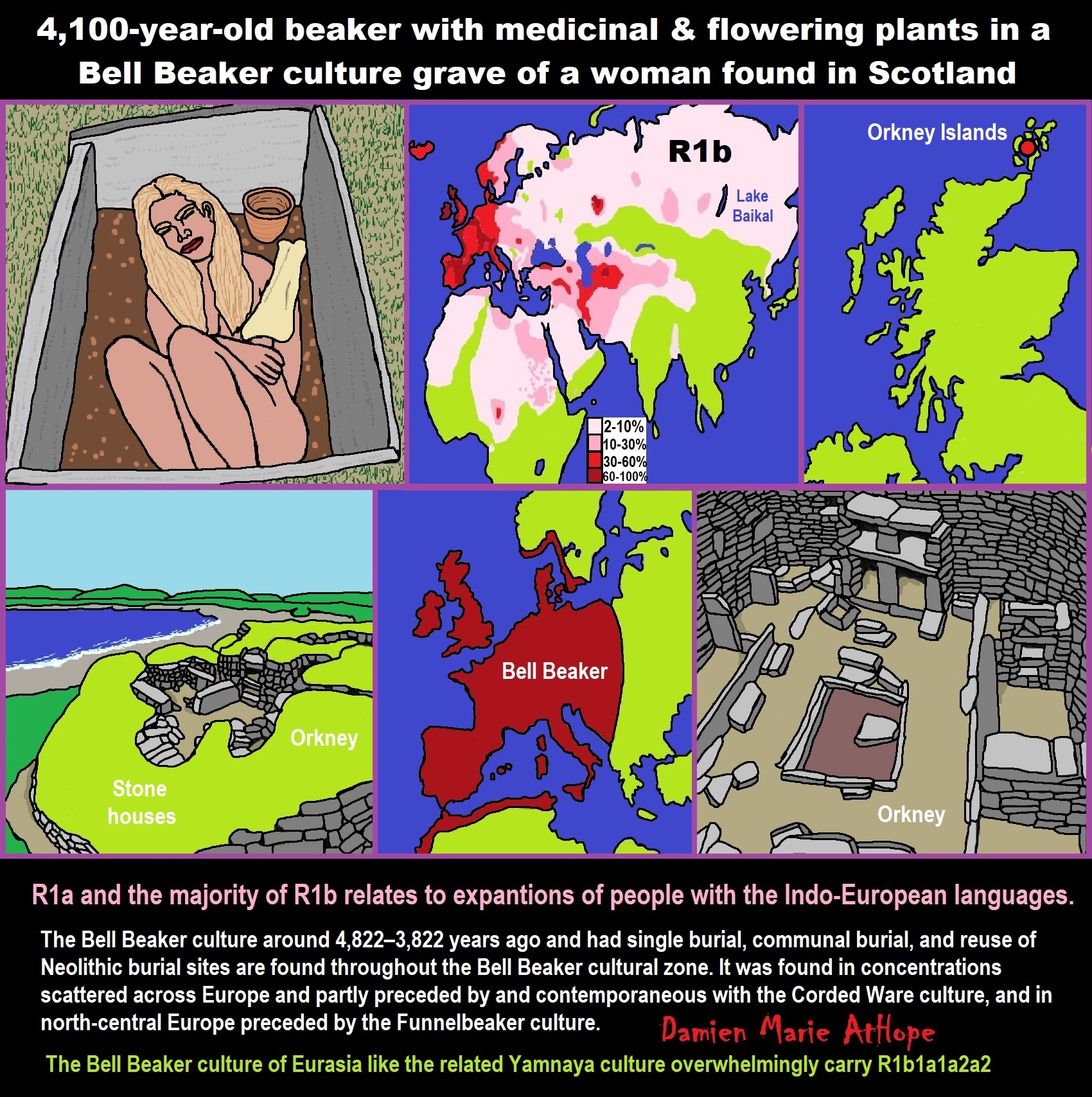

Animism: Respecting the Living World by Graham Harvey
“How have human cultures engaged with and thought about animals, plants, rocks, clouds, and other elements in their natural surroundings? Do animals and other natural objects have a spirit or soul? What is their relationship to humans? In this new study, Graham Harvey explores current and past animistic beliefs and practices of Native Americans, Maori, Aboriginal Australians, and eco-pagans. He considers the varieties of animism found in these cultures as well as their shared desire to live respectfully within larger natural communities. Drawing on his extensive casework, Harvey also considers the linguistic, performative, ecological, and activist implications of these different animisms.” ref
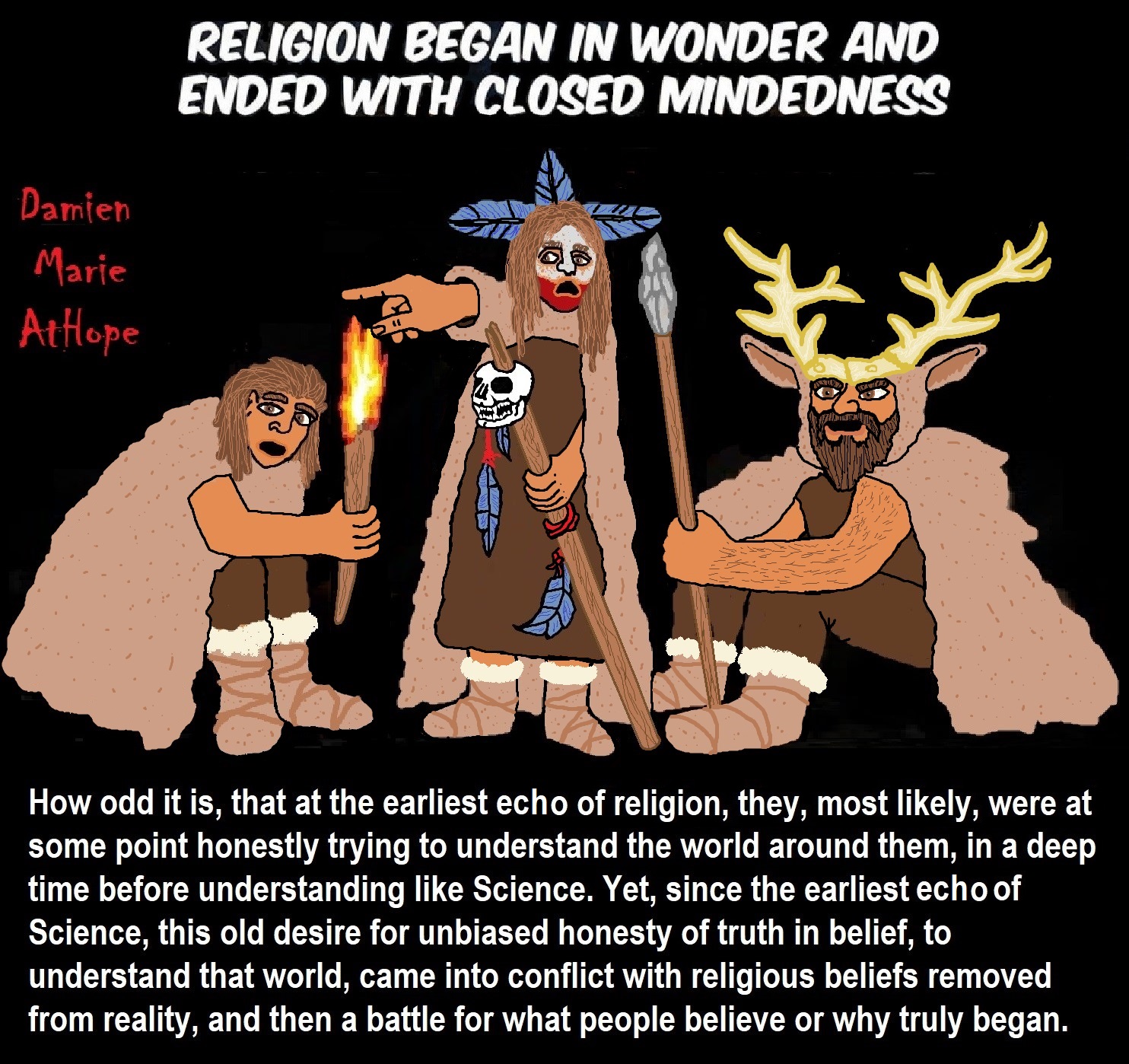

My thoughts on Religion Evolution with external links for more info:
- (Pre-Animism Africa mainly, but also Europe, and Asia at least 300,000 years ago), (Pre-Animism – Oxford Dictionaries)
- (Animism Africa around 100,000 years ago), (Animism – Britannica.com)
- (Totemism Europe around 50,000 years ago), (Totemism – Anthropology)
- (Shamanism Siberia around 30,000 years ago), (Shamanism – Britannica.com)
- (Paganism Turkey around 12,000 years ago), (Paganism – BBC Religion)
- (Progressed Organized Religion “Institutional Religion” Egypt around 5,000 years ago), (Ancient Egyptian Religion – Britannica.com)
- (CURRENT “World” RELIGIONS after 4,000 years ago) (Origin of Major Religions – Sacred Texts)
- (Early Atheistic Doubting at least by 2,600 years ago) (History of Atheism – Wikipedia)
“Religion is an Evolved Product” and Yes, Religion is Like Fear Given Wings…
Atheists talk about gods and religions for the same reason doctors talk about cancer, they are looking for a cure, or a firefighter talks about fires because they burn people and they care to stop them. We atheists too often feel a need to help the victims of mental slavery, held in the bondage that is the false beliefs of gods and the conspiracy theories of reality found in religions.
Understanding Religion Evolution:
- Pre-Animism (at least 300,000 years ago)
- Animism (Africa: 100,000 years ago)
- Totemism (Europe: 50,000 years ago)
- Shamanism (Siberia: 30,000 years ago)
- Paganism (Turkey: 12,000 years ago)
- Progressed organized religion (Egypt: 5,000 years ago), (Egypt, the First Dynasty 5,150 years ago)
- CURRENT “World” RELIGIONS (after 4,000 years ago)
- Early Atheistic Doubting (at least by 2,600 years ago)
“An Archaeological/Anthropological Understanding of Religion Evolution”
It seems ancient peoples had to survived amazing threats in a “dangerous universe (by superstition perceived as good and evil),” and human “immorality or imperfection of the soul” which was thought to affect the still living, leading to ancestor worship. This ancestor worship presumably led to the belief in supernatural beings, and then some of these were turned into the belief in gods. This feeble myth called gods were just a human conceived “made from nothing into something over and over, changing, again and again, taking on more as they evolve, all the while they are thought to be special,” but it is just supernatural animistic spirit-belief perceived as sacred.
Quick Evolution of Religion?
Pre-Animism (at least 300,000 years ago) pre-religion is a beginning that evolves into later Animism. So, Religion as we think of it, to me, all starts in a general way with Animism (Africa: 100,000 years ago) (theoretical belief in supernatural powers/spirits), then this is physically expressed in or with Totemism (Europe: 50,000 years ago) (theoretical belief in mythical relationship with powers/spirits through a totem item), which then enlists a full-time specific person to do this worship and believed interacting Shamanism (Siberia/Russia: 30,000 years ago) (theoretical belief in access and influence with spirits through ritual), and then there is the further employment of myths and gods added to all the above giving you Paganism (Turkey: 12,000 years ago) (often a lot more nature-based than most current top world religions, thus hinting to their close link to more ancient religious thinking it stems from). My hypothesis is expressed with an explanation of the building of a theatrical house (modern religions development). Progressed organized religion (Egypt: 5,000 years ago) with CURRENT “World” RELIGIONS (after 4,000 years ago).
Historically, in large city-state societies (such as Egypt or Iraq) starting around 5,000 years ago culminated to make religion something kind of new, a sociocultural-governmental-religious monarchy, where all or at least many of the people of such large city-state societies seem familiar with and committed to the existence of “religion” as the integrated life identity package of control dynamics with a fixed closed magical doctrine, but this juggernaut integrated religion identity package of Dogmatic-Propaganda certainly did not exist or if developed to an extent it was highly limited in most smaller prehistoric societies as they seem to lack most of the strong control dynamics with a fixed closed magical doctrine (magical beliefs could be at times be added or removed). Many people just want to see developed religious dynamics everywhere even if it is not. Instead, all that is found is largely fragments until the domestication of religion.
Religions, as we think of them today, are a new fad, even if they go back to around 6,000 years in the timeline of human existence, this amounts to almost nothing when seen in the long slow evolution of religion at least around 70,000 years ago with one of the oldest ritual worship. Stone Snake of South Africa: “first human worship” 70,000 years ago. This message of how religion and gods among them are clearly a man-made thing that was developed slowly as it was invented and then implemented peace by peace discrediting them all. Which seems to be a simple point some are just not grasping how devastating to any claims of truth when we can see the lie clearly in the archeological sites.
I wish people fought as hard for the actual values as they fight for the group/clan names political or otherwise they think support values. Every amount spent on war is theft to children in need of food or the homeless kept from shelter.
Here are several of my blog posts on history:
- To Find Truth You Must First Look
- (Magdalenian/Iberomaurusian) Connections to the First Paganists of the early Neolithic Near East Dating from around 17,000 to 12,000 Years Ago
- Natufians: an Ancient People at the Origins of Agriculture and Sedentary Life
- Possible Clan Leader/Special “MALE” Ancestor Totem Poles At Least 13,500 years ago?
- Jewish People with DNA at least 13,200 years old, Judaism, and the Origins of Some of its Ideas
- Baltic Reindeer Hunters: Swiderian, Lyngby, Ahrensburgian, and Krasnosillya cultures 12,020 to 11,020 years ago are evidence of powerful migratory waves during the last 13,000 years and a genetic link to Saami and the Finno-Ugric peoples.
- The Rise of Inequality: patriarchy and state hierarchy inequality
- Fertile Crescent 12,500 – 9,500 Years Ago: fertility and death cult belief system?
- 12,400 – 11,700 Years Ago – Kortik Tepe (Turkey) Pre/early-Agriculture Cultic Ritualism
- Ritualistic Bird Symbolism at Gobekli Tepe and its “Ancestor Cult”
- Male-Homosexual (female-like) / Trans-woman (female) Seated Figurine from Gobekli Tepe
- Could a 12,000-year-old Bull Geoglyph at Göbekli Tepe relate to older Bull and Female Art 25,000 years ago and Later Goddess and the Bull cults like Catal Huyuk?
- Sedentism and the Creation of goddesses around 12,000 years ago as well as male gods after 7,000 years ago.
- Alcohol, where Agriculture and Religion Become one? Such as Gobekli Tepe’s Ritualistic use of Grain as Food and Ritual Drink
- Neolithic Ritual Sites with T-Pillars and other Cultic Pillars
- Paganism: Goddesses around 12,000 years ago then Male Gods after 7,000 years ago
- First Patriarchy: Split of Women’s Status around 12,000 years ago & First Hierarchy: fall of Women’s Status around 5,000 years ago.
- Natufians: an Ancient People at the Origins of Agriculture and Sedentary Life
- J DNA and the Spread of Agricultural Religion (paganism)
- Paganism: an approximately 12,000-year-old belief system
- Paganism 12,000 years old: related to “Anarchism and Socialism” (Pre-Capitalism)
- Shaman burial in Israel 12,000 years ago and the Shamanism Phenomena
- Need to Mythicized: gods and goddesses
- 12,000 – 7,000 Years Ago – Paleo-Indian Culture (The Americas)
- 12,000 – 2,000 Years Ago – Indigenous-Scandinavians (Nordic)
- Norse did not wear helmets with horns?
- Pre-Pottery Neolithic Skull Cult around 11,500 to 8,400 Years Ago?
- 10,400 – 10,100 Years Ago, in Turkey the Nevail Cori Religious Settlement
- 9,000-6,500 Years Old Submerged Pre-Pottery/Pottery Neolithic Ritual Settlements off Israel’s Coast
- Catal Huyuk “first religious designed city” around 9,500 to 7,700 years ago (Turkey)
- Cultic Hunting at Catal Huyuk “first religious designed city”
- Special Items and Art as well as Special Elite Burials at Catal Huyuk
- New Rituals and Violence with the appearance of Pottery and People?
- Haplogroup N and its related Uralic Languages and Cultures
- Ainu people, Sámi people, Native Americans, the Ancient North Eurasians, and Paganistic-Shamanism with Totemism
- Ideas, Technology and People from Turkey, Europe, to China and Back again 9,000 to 5,000 years ago?
- First Pottery of Europe and the Related Cultures
- 9,000 years old Neolithic Artifacts Judean Desert and Hills Israel
- 9,000-7,000 years-old Sex and Death Rituals: Cult Sites in Israel, Jordan, and the Sinai
- 9,000-8500 year old Horned Female shaman Bad Dürrenberg Germany
- Neolithic Jewelry and the Spread of Farming in Europe Emerging out of West Turkey
- 8,600-year-old Tortoise Shells in Neolithic graves in central China have Early Writing and Shamanism
- Swing of the Mace: the rise of Elite, Forced Authority, and Inequality begin to Emerge 8,500 years ago?
- Migrations and Changing Europeans Beginning around 8,000 Years Ago
- My “Steppe-Anatolian-Kurgan hypothesis” 8,000/7,000 years ago
- Around 8,000-year-old Shared Idea of the Mistress of Animals, “Ritual” Motif
- Pre-Columbian Red-Paint (red ochre) Maritime Archaic Culture 8,000-3,000 years ago
- 7,522-6,522 years ago Linear Pottery culture which I think relates to Arcane Capitalism’s origins
- Arcane Capitalism: Primitive socialism, Primitive capital, Private ownership, Means of production, Market capitalism, Class discrimination, and Petite bourgeoisie (smaller capitalists)
- 7,500-4,750 years old Ritualistic Cucuteni-Trypillian culture of Moldova, Romania, and Ukraine
- Roots of a changing early society 7,200-6,700 years ago Jordan and Israel
- Agriculture religion (Paganism) with farming reached Britain between about 7,000 to 6,500 or so years ago and seemingly expressed in things like Western Europe’s Long Barrows
- My Thoughts on Possible Migrations of “R” DNA and Proto-Indo-European?
- “Millet” Spreading from China 7,022 years ago to Europe and related Language may have Spread with it leading to Proto-Indo-European
- Proto-Indo-European (PIE), ancestor of Indo-European languages: DNA, Society, Language, and Mythology
- The Dnieper–Donets culture and Asian varieties of Millet from China to the Black Sea region of Europe by 7,022 years ago
- Kurgan 6,000 years ago/dolmens 7,000 years ago: funeral, ritual, and other?
- 7,020 to 6,020-year-old Proto-Indo-European Homeland of Urheimat or proposed home of their Language and Religion
- Ancient Megaliths: Kurgan, Ziggurat, Pyramid, Menhir, Trilithon, Dolman, Kromlech, and Kromlech of Trilithons
- The Mytheme of Ancient North Eurasian Sacred-Dog belief and similar motifs are found in Indo-European, Native American, and Siberian comparative mythology
- Elite Power Accumulation: Ancient Trade, Tokens, Writing, Wealth, Merchants, and Priest-Kings
- Sacred Mounds, Mountains, Kurgans, and Pyramids may hold deep connections?
- Between 7,000-5,000 Years ago, rise of unequal hierarchy elite, leading to a “birth of the State” or worship of power, strong new sexism, oppression of non-elites, and the fall of Women’s equal status
- Paganism 7,000-5,000 years old: related to “Anarchism and Socialism” (Capitalism) (World War 0) Elite & their slaves
- Hell and Underworld mythologies starting maybe as far back as 7,000 to 5,000 years ago with the Proto-Indo-Europeans?
- The First Expression of the Male God around 7,000 years ago?
- White (light complexion skin) Bigotry and Sexism started 7,000 years ago?
- Around 7,000-year-old Shared Idea of the Divine Bird (Tutelary and/or Trickster spirit/deity), “Ritual” Motif
- Nekhbet an Ancient Egyptian Vulture Goddess and Tutelary Deity
- 6,720 to 4,920 years old Ritualistic Hongshan Culture of Inner Mongolia with 5,000-year-old Pyramid Mounds and Temples
- First proto-king in the Balkans, Varna culture around 6,500 years ago?
- 6,500–5,800 years ago in Israel Late Chalcolithic (Copper Age) Period in the Southern Levant Seems to Express Northern Levant Migrations, Cultural and Religious Transfer
- KING OF BEASTS: Master of Animals “Ritual” Motif, around 6,000 years old or older…
- Around 6000-year-old Shared Idea of the Solid Wheel & the Spoked Wheel-Shaped Ritual Motif
- “The Ghassulian Star,” a mysterious 6,000-year-old mural from Jordan; a Proto-Star of Ishtar, Star of Inanna or Star of Venus?
- Religious/Ritual Ideas, including goddesses and gods as well as ritual mounds or pyramids from Northeastern Asia at least 6,000 years old, seemingly filtering to Iran, Iraq, the Mediterranean, Europe, Egypt, and the Americas?
- Maykop (5,720–5,020 years ago) Caucasus region Bronze Age culture-related to Copper Age farmers from the south, influenced by the Ubaid period and Leyla-Tepe culture, as well as influencing the Kura-Araxes culture
- 5-600-year-old Tomb, Mummy, and First Bearded Male Figurine in a Grave
- Kura-Araxes Cultural 5,520 to 4,470 years old DNA traces to the Canaanites, Arabs, and Jews
- Minoan/Cretan (Keftiu) Civilization and Religion around 5,520 to 3,120 years ago
- Evolution Of Science at least by 5,500 years ago
- 5,500 Years old birth of the State, the rise of Hierarchy, and the fall of Women’s status
- “Jiroft culture” 5,100 – 4,200 years ago and the History of Iran
- Stonehenge: Paganistic Burial and Astrological Ritual Complex, England (5,100-3,600 years ago)
- Around 5,000-year-old Shared Idea of the “Tree of Life” Ritual Motif
- Complex rituals for elite, seen from China to Egypt, at least by 5,000 years ago
- Around 5,000 years ago: “Birth of the State” where Religion gets Military Power and Influence
- The Center of the World “Axis Mundi” and/or “Sacred Mountains” Mythology Could Relate to the Altai Mountains, Heart of the Steppe
- Progressed organized religion starts, an approximately 5,000-year-old belief system
- China’s Civilization between 5,000-3,000 years ago, was a time of war and class struggle, violent transition from free clans to a Slave or Elite society
- Origin of Logics is Naturalistic Observation at least by around 5,000 years ago.
- Paganism 5,000 years old: progressed organized religion and the state: related to “Anarchism and Socialism” (Kings and the Rise of the State)
- Ziggurats (multi-platform temples: 4,900 years old) to Pyramids (multi-platform tombs: 4,700 years old)
- Did a 4,520–4,420-year-old Volcano In Turkey Inspire the Bible God?
- Finland’s Horned Shaman and Pre-Horned-God at least 4,500 years ago?
- 4,000-year-Old Dolmens in Israel: A Connected Dolmen Religious Phenomenon?
- Creation myths: From chaos, Ex nihilo, Earth-diver, Emergence, World egg, and World parent
- Bronze Age “Ritual” connections of the Bell Beaker culture with the Corded Ware/Single Grave culture, which were related to the Yamnaya culture and Proto-Indo-European Languages/Religions
- Low Gods (Earth/ Tutelary deity), High Gods (Sky/Supreme deity), and Moralistic Gods (Deity enforcement/divine order)
- The exchange of people, ideas, and material-culture including, to me, the new god (Sky Father) and goddess (Earth Mother) religion between the Cucuteni-Trypillians and others which is then spread far and wide
- Koryaks: Indigenous People of the Russian Far East and Big Raven myths also found in Tlingit, Haida, Tsimshian, and other Indigenous People of North America
- 42 Principles Of Maat (Egyptian Goddess of the justice) around 4,400 years ago, 2000 Years Before Ten Commandments
- “Happy Easter” Well Happy Eostre/Ishter
- 4,320-3,820 years old “Shimao” (North China) site with Totemistic-Shamanistic Paganism and a Stepped Pyramid
- 4,250 to 3,400 Year old Stonehenge from Russia: Arkaim?
- 4,100-year-old beaker with medicinal & flowering plants in a grave of a woman in Scotland
- Early European Farmer ancestry, Kelif el Boroud people with the Cardial Ware culture, and the Bell Beaker culture Paganists too, spread into North Africa, then to the Canary Islands off West Africa
- Flood Accounts: Gilgamesh epic (4,100 years ago) Noah in Genesis (2,600 years ago)
- Paganism 4,000 years old: related to “Anarchism and Socialism” (First Moralistic gods, then the Origin time of Monotheism)
- When was the beginning: TIMELINE OF CURRENT RELIGIONS, which start around 4,000 years ago.
- Early Religions Thought to Express Proto-Monotheistic Systems around 4,000 years ago
- Kultepe? An archaeological site with a 4,000 years old women’s rights document.
- Single God Religions (Monotheism) = “Man-o-theism” started around 4,000 years ago with the Great Sky Spirit/God Tiān (天)?
- Confucianism’s Tiān (Shangdi god 4,000 years old): Supernaturalism, Pantheism or Theism?
- Yes, Your Male God is Ridiculous
- Mythology, a Lunar Deity is a Goddess or God of the Moon
- Sacred Land, Hills, and Mountains: Sami Mythology (Paganistic Shamanism)
- Horse Worship/Sacrifice: mythical union of Ruling Elite/Kingship and the Horse
- The Amorite/Amurru people’s God Amurru “Lord of the Steppe”, relates to the Origins of the Bible God?
- Bronze Age Exotic Trade Routes Spread Quite Far as well as Spread Religious Ideas with Them
- Sami and the Northern Indigenous Peoples Landscape, Language, and its Connection to Religion
- Prototype of Ancient Analemmatic Sundials around 3,900-3,150 years ago and a Possible Solar Connection to gods?
- Judaism is around 3,450 or 3,250 years old. (“Paleo-Hebrew” 3,000 years ago and Torah 2,500 years ago)
- The Weakening of Ancient Trade and the Strengthening of Religions around 3000 years ago?
- Are you aware that there are religions that worship women gods, explain now religion tears women down?
- Animistic, Totemistic, and Paganistic Superstition Origins of bible god and the bible’s Religion.
- Myths and Folklore: “Trickster gods and goddesses”
- Jews, Judaism, and the Origins of Some of its Ideas
- An Old Branch of Religion Still Giving Fruit: Sacred Trees
- Dating the BIBLE: naming names and telling times (written less than 3,000 years ago, provable to 2,200 years ago)
- Did a Volcano Inspire the bible god?
- The Amorite/Amurru people’s God Amurru “Lord of the Steppe”, relates to the Origins of the Bible God?
- Dené–Yeniseian language, Old Copper Complex, and Pre-Columbian Mound Builders?
- No “dinosaurs and humans didn’t exist together just because some think they are in the bible itself”
- Sacred Shit and Sacred Animals?
- Everyone Killed in the Bible Flood? “Nephilim” (giants)?
- Hey, Damien dude, I have a question for you regarding “the bible” Exodus.
- Archaeology Disproves the Bible
- Bible Battle, Just More, Bible Babble
- The Jericho Conquest lie?
- Canaanites and Israelites?
- Accurate Account on how did Christianity Began?
- Let’s talk about Christianity.
- So the 10 commandments isn’t anything to go by either right?
- Misinformed christian
- Debunking Jesus?
- Paulism vs Jesus
- Ok, you seem confused so let’s talk about Buddhism.
- Unacknowledged Buddhism: Gods, Savior, Demons, Rebirth, Heavens, Hells, and Terrorism
- His Foolishness The Dalai Lama
- Yin and Yang is sexist with an ORIGIN around 2,300 years ago?
- I Believe Archaeology, not Myths & Why Not, as the Religious Myths Already Violate Reason!
- Archaeological, Scientific, & Philosophic evidence shows the god myth is man-made nonsense.
- Aquatic Ape Theory/Hypothesis? As Always, Just Pseudoscience.
- Ancient Aliens Conspiracy Theorists are Pseudohistorians
- The Pseudohistoric and Pseudoscientific claims about “Bakoni Ruins” of South Africa
- Why do people think Religion is much more than supernaturalism and superstitionism?
- Religion is an Evolved Product
- Was the Value of Ancient Women Different?
- 1000 to 1100 CE, human sacrifice Cahokia Mounds a pre-Columbian Native American site
- Feminist atheists as far back as the 1800s?
- Promoting Religion as Real is Mentally Harmful to a Flourishing Humanity
- Screw All Religions and Their Toxic lies, they are all fraud
- Forget Religions’ Unfounded Myths, I Have Substantiated “Archaeology Facts.”
- Religion Dispersal throughout the World
- I Hate Religion Just as I Hate all Pseudoscience
- Exposing Scientology, Eckankar, Wicca and Other Nonsense?
- Main deity or religious belief systems
- Quit Trying to Invent Your God From the Scraps of Science.
- Archaeological, Scientific, & Philosophic evidence shows the god myth is man-made nonsense.
- Ancient Alien Conspiracy Theorists: Misunderstanding, Rhetoric, Misinformation, Fabrications, and Lies
- Misinformation, Distortion, and Pseudoscience in Talking with a Christian Creationist
- Judging the Lack of Goodness in Gods, Even the Norse God Odin
- Challenging the Belief in God-like Aliens and Gods in General
- A Challenge to Christian use of Torture Devices?
- Yes, Hinduism is a Religion
- Trump is One of the Most Reactionary Forces of Far-right Christian Extremism
- Was the Bull Head a Symbol of God? Yes!
- Primate Death Rituals
- Christian – “God and Christianity are objectively true”
- Australopithecus afarensis Death Ritual?
- You Claim Global Warming is a Hoax?
- Doubter of Science and Defamer of Atheists?
- I think that sounds like the Bible?
- History of the Antifa (“anti-fascist”) Movements
- Indianapolis Anti-Blasphemy Laws #Free Soheil Rally
- Damien, you repeat the golden rule in so many forms then you say religion is dogmatic?
- Science is a Trustable Methodology whereas Faith is not Trustable at all!
- Was I ever a believer, before I was an atheist?
- Atheists rise in reason
- Mistrust of science?
- Open to Talking About the Definition of ‘God’? But first, we address Faith.
- ‘United Monarchy’ full of splendor and power – Saul, David, and Solomon? Most likely not.
- Is there EXODUS ARCHAEOLOGY? The short answer is “no.”
- Lacking Proof of Bigfoots, Unicorns, and Gods is Just a Lack of Research?
- Religion and Politics: Faith Beliefs vs. Rational Thinking
- Hammer of Truth that lying pig RELIGION: challenged by an archaeologist
- “The Hammer of Truth” -ontology question- What do You Mean by That?
- Navigation of a bad argument: Ad Hominem vs. Attack
- Why is it Often Claimed that Gods have a Gender?
- Why are basically all monotheistic religions ones that have a male god?
- Shifting through the Claims in support of Faith
- Dear Mr. AtHope, The 20th Century is an Indictment of Secularism and a Failed Atheist Century
- An Understanding of the Worldwide Statistics and Dynamics of Terrorist Incidents and Suicide Attacks
- Intoxication and Evolution? Addressing and Assessing the “Stoned Ape” or “Drunken Monkey” Theories as Catalysts in Human Evolution
- Sacred Menstrual cloth? Inanna’s knot, Isis knot, and maybe Ma’at’s feather?
- Damien, why don’t the Hebrews accept the bible stories?
- Dealing with a Troll and Arguing Over Word Meaning
- Knowledge without Belief? Justified beliefs or disbeliefs worthy of Knowledge?
- Afrocentrism and African Religions
- Crecganford @crecganford offers history & stories of the people, places, gods, & culture
- Empiricism-Denier?
I am not an academic. I am a revolutionary that teaches in public, in places like social media, and in the streets. I am not a leader by some title given but from my commanding leadership style of simply to start teaching everywhere to everyone, all manner of positive education.









ref, ref, ref, ref, ref, ref, ref, ref, ref, ref, ref, ref, ref, ref, ref, ref, ref, ref, ref, ref, ref
Low Gods “Earth” or Tutelary deity and High Gods “Sky” or Supreme deity
“An Earth goddess is a deification of the Earth. Earth goddesses are often associated with the “chthonic” deities of the underworld. Ki and Ninhursag are Mesopotamian earth goddesses. In Greek mythology, the Earth is personified as Gaia, corresponding to Roman Terra, Indic Prithvi/Bhūmi, etc. traced to an “Earth Mother” complementary to the “Sky Father” in Proto-Indo-European religion. Egyptian mythology exceptionally has a sky goddess and an Earth god.” ref
“A mother goddess is a goddess who represents or is a personification of nature, motherhood, fertility, creation, destruction or who embodies the bounty of the Earth. When equated with the Earth or the natural world, such goddesses are sometimes referred to as Mother Earth or as the Earth Mother. In some religious traditions or movements, Heavenly Mother (also referred to as Mother in Heaven or Sky Mother) is the wife or feminine counterpart of the Sky father or God the Father.” ref
“Any masculine sky god is often also king of the gods, taking the position of patriarch within a pantheon. Such king gods are collectively categorized as “sky father” deities, with a polarity between sky and earth often being expressed by pairing a “sky father” god with an “earth mother” goddess (pairings of a sky mother with an earth father are less frequent). A main sky goddess is often the queen of the gods and may be an air/sky goddess in her own right, though she usually has other functions as well with “sky” not being her main. In antiquity, several sky goddesses in ancient Egypt, Mesopotamia, and the Near East were called Queen of Heaven. Neopagans often apply it with impunity to sky goddesses from other regions who were never associated with the term historically. The sky often has important religious significance. Many religions, both polytheistic and monotheistic, have deities associated with the sky.” ref
“In comparative mythology, sky father is a term for a recurring concept in polytheistic religions of a sky god who is addressed as a “father”, often the father of a pantheon and is often either a reigning or former King of the Gods. The concept of “sky father” may also be taken to include Sun gods with similar characteristics, such as Ra. The concept is complementary to an “earth mother“. “Sky Father” is a direct translation of the Vedic Dyaus Pita, etymologically descended from the same Proto-Indo-European deity name as the Greek Zeûs Pater and Roman Jupiter and Germanic Týr, Tir or Tiwaz, all of which are reflexes of the same Proto-Indo-European deity’s name, *Dyēus Ph₂tḗr. While there are numerous parallels adduced from outside of Indo-European mythology, there are exceptions (e.g. In Egyptian mythology, Nut is the sky mother and Geb is the earth father).” ref
Tutelary deity
“A tutelary (also tutelar) is a deity or spirit who is a guardian, patron, or protector of a particular place, geographic feature, person, lineage, nation, culture, or occupation. The etymology of “tutelary” expresses the concept of safety and thus of guardianship. In late Greek and Roman religion, one type of tutelary deity, the genius, functions as the personal deity or daimon of an individual from birth to death. Another form of personal tutelary spirit is the familiar spirit of European folklore.” ref
“A tutelary (also tutelar) in Korean shamanism, jangseung and sotdae were placed at the edge of villages to frighten off demons. They were also worshiped as deities. Seonangshin is the patron deity of the village in Korean tradition and was believed to embody the Seonangdang. In Philippine animism, Diwata or Lambana are deities or spirits that inhabit sacred places like mountains and mounds and serve as guardians. Such as: Maria Makiling is the deity who guards Mt. Makiling and Maria Cacao and Maria Sinukuan. In Shinto, the spirits, or kami, which give life to human bodies come from nature and return to it after death. Ancestors are therefore themselves tutelaries to be worshiped. And similarly, Native American beliefs such as Tonás, tutelary animal spirit among the Zapotec and Totems, familial or clan spirits among the Ojibwe, can be animals.” ref
“A tutelary (also tutelar) in Austronesian beliefs such as: Atua (gods and spirits of the Polynesian peoples such as the Māori or the Hawaiians), Hanitu (Bunun of Taiwan‘s term for spirit), Hyang (Kawi, Sundanese, Javanese, and Balinese Supreme Being, in ancient Java and Bali mythology and this spiritual entity, can be either divine or ancestral), Kaitiaki (New Zealand Māori term used for the concept of guardianship, for the sky, the sea, and the land), Kawas (mythology) (divided into 6 groups: gods, ancestors, souls of the living, spirits of living things, spirits of lifeless objects, and ghosts), Tiki (Māori mythology, Tiki is the first man created by either Tūmatauenga or Tāne and represents deified ancestors found in most Polynesian cultures). ” ref, ref, ref, ref, ref, ref, ref
Mesopotamian Tutelary Deities can be seen as ones related to City-States
“Historical city-states included Sumerian cities such as Uruk and Ur; Ancient Egyptian city-states, such as Thebes and Memphis; the Phoenician cities (such as Tyre and Sidon); the five Philistine city-states; the Berber city-states of the Garamantes; the city-states of ancient Greece (the poleis such as Athens, Sparta, Thebes, and Corinth); the Roman Republic (which grew from a city-state into a vast empire); the Italian city-states from the Middle Ages to the early modern period, such as Florence, Siena, Ferrara, Milan (which as they grew in power began to dominate neighboring cities) and Genoa and Venice, which became powerful thalassocracies; the Mayan and other cultures of pre-Columbian Mesoamerica (including cities such as Chichen Itza, Tikal, Copán and Monte Albán); the central Asian cities along the Silk Road; the city-states of the Swahili coast; Ragusa; states of the medieval Russian lands such as Novgorod and Pskov; and many others.” ref
“The Uruk period (ca. 4000 to 3100 BCE; also known as Protoliterate period) of Mesopotamia, named after the Sumerian city of Uruk, this period saw the emergence of urban life in Mesopotamia and the Sumerian civilization. City-States like Uruk and others had a patron tutelary City Deity along with a Priest-King.” ref
“Chinese folk religion, both past, and present, includes myriad tutelary deities. Exceptional individuals, highly cultivated sages, and prominent ancestors can be deified and honored after death. Lord Guan is the patron of military personnel and police, while Mazu is the patron of fishermen and sailors. Such as Tu Di Gong (Earth Deity) is the tutelary deity of a locality, and each individual locality has its own Earth Deity and Cheng Huang Gong (City God) is the guardian deity of an individual city, worshipped by local officials and locals since imperial times.” ref
“A tutelary (also tutelar) in Hinduism, personal tutelary deities are known as ishta-devata, while family tutelary deities are known as Kuladevata. Gramadevata are guardian deities of villages. Devas can also be seen as tutelary. Shiva is the patron of yogis and renunciants. City goddesses include: Mumbadevi (Mumbai), Sachchika (Osian); Kuladevis include: Ambika (Porwad), and Mahalakshmi. In NorthEast India Meitei mythology and religion (Sanamahism) of Manipur, there are various types of tutelary deities, among which Lam Lais are the most predominant ones. Tibetan Buddhism has Yidam as a tutelary deity. Dakini is the patron of those who seek knowledge.” ref
“A tutelary (also tutelar) The Greeks also thought deities guarded specific places: for instance, Athena was the patron goddess of the city of Athens. Socrates spoke of hearing the voice of his personal spirit or daimonion:
You have often heard me speak of an oracle or sign which comes to me … . This sign I have had ever since I was a child. The sign is a voice which comes to me and always forbids me to do something which I am going to do, but never commands me to do anything, and this is what stands in the way of my being a politician.” ref
“Tutelary deities who guard and preserve a place or a person are fundamental to ancient Roman religion. The tutelary deity of a man was his Genius, that of a woman her Juno. In the Imperial era, the Genius of the Emperor was a focus of Imperial cult. An emperor might also adopt a major deity as his personal patron or tutelary, as Augustus did Apollo. Precedents for claiming the personal protection of a deity were established in the Republican era, when for instance the Roman dictator Sulla advertised the goddess Victory as his tutelary by holding public games (ludi) in her honor.” ref
“Each town or city had one or more tutelary deities, whose protection was considered particularly vital in time of war and siege. Rome itself was protected by a goddess whose name was to be kept ritually secret on pain of death (for a supposed case, see Quintus Valerius Soranus). The Capitoline Triad of Juno, Jupiter, and Minerva were also tutelaries of Rome. The Italic towns had their own tutelary deities. Juno often had this function, as at the Latin town of Lanuvium and the Etruscan city of Veii, and was often housed in an especially grand temple on the arx (citadel) or other prominent or central location. The tutelary deity of Praeneste was Fortuna, whose oracle was renowned.” ref
“The Roman ritual of evocatio was premised on the belief that a town could be made vulnerable to military defeat if the power of its tutelary deity were diverted outside the city, perhaps by the offer of superior cult at Rome. The depiction of some goddesses such as the Magna Mater (Great Mother, or Cybele) as “tower-crowned” represents their capacity to preserve the city. A town in the provinces might adopt a deity from within the Roman religious sphere to serve as its guardian, or syncretize its own tutelary with such; for instance, a community within the civitas of the Remi in Gaul adopted Apollo as its tutelary, and at the capital of the Remi (present-day Rheims), the tutelary was Mars Camulus.” ref
Household deity (a kind of or related to a Tutelary deity)
“A household deity is a deity or spirit that protects the home, looking after the entire household or certain key members. It has been a common belief in paganism as well as in folklore across many parts of the world. Household deities fit into two types; firstly, a specific deity – typically a goddess – often referred to as a hearth goddess or domestic goddess who is associated with the home and hearth, such as the ancient Greek Hestia.” ref
“The second type of household deities are those that are not one singular deity, but a type, or species of animistic deity, who usually have lesser powers than major deities. This type was common in the religions of antiquity, such as the Lares of ancient Roman religion, the Gashin of Korean shamanism, and Cofgodas of Anglo-Saxon paganism. These survived Christianisation as fairy-like creatures existing in folklore, such as the Anglo-Scottish Brownie and Slavic Domovoy.” ref
“Household deities were usually worshipped not in temples but in the home, where they would be represented by small idols (such as the teraphim of the Bible, often translated as “household gods” in Genesis 31:19 for example), amulets, paintings, or reliefs. They could also be found on domestic objects, such as cosmetic articles in the case of Tawaret. The more prosperous houses might have a small shrine to the household god(s); the lararium served this purpose in the case of the Romans. The gods would be treated as members of the family and invited to join in meals, or be given offerings of food and drink.” ref
“In many religions, both ancient and modern, a god would preside over the home. Certain species, or types, of household deities, existed. An example of this was the Roman Lares. Many European cultures retained house spirits into the modern period. Some examples of these include:
- Brownie (Scotland and England) or Hob (England) / Kobold (Germany) / Goblin / Hobgoblin
- Domovoy (Slavic)
- Nisse (Norwegian or Danish) / Tomte (Swedish) / Tonttu (Finnish)
- Húsvættir (Norse)” ref
“Although the cosmic status of household deities was not as lofty as that of the Twelve Olympians or the Aesir, they were also jealous of their dignity and also had to be appeased with shrines and offerings, however humble. Because of their immediacy they had arguably more influence on the day-to-day affairs of men than the remote gods did. Vestiges of their worship persisted long after Christianity and other major religions extirpated nearly every trace of the major pagan pantheons. Elements of the practice can be seen even today, with Christian accretions, where statues to various saints (such as St. Francis) protect gardens and grottos. Even the gargoyles found on older churches, could be viewed as guardians partitioning a sacred space.” ref
“For centuries, Christianity fought a mop-up war against these lingering minor pagan deities, but they proved tenacious. For example, Martin Luther‘s Tischreden have numerous – quite serious – references to dealing with kobolds. Eventually, rationalism and the Industrial Revolution threatened to erase most of these minor deities, until the advent of romantic nationalism rehabilitated them and embellished them into objects of literary curiosity in the 19th century. Since the 20th century this literature has been mined for characters for role-playing games, video games, and other fantasy personae, not infrequently invested with invented traits and hierarchies somewhat different from their mythological and folkloric roots.” ref
“In contradistinction to both Herbert Spencer and Edward Burnett Tylor, who defended theories of animistic origins of ancestor worship, Émile Durkheim saw its origin in totemism. In reality, this distinction is somewhat academic, since totemism may be regarded as a particularized manifestation of animism, and something of a synthesis of the two positions was attempted by Sigmund Freud. In Freud’s Totem and Taboo, both totem and taboo are outward expressions or manifestations of the same psychological tendency, a concept which is complementary to, or which rather reconciles, the apparent conflict. Freud preferred to emphasize the psychoanalytic implications of the reification of metaphysical forces, but with particular emphasis on its familial nature. This emphasis underscores, rather than weakens, the ancestral component.” ref
“William Edward Hearn, a noted classicist, and jurist, traced the origin of domestic deities from the earliest stages as an expression of animism, a belief system thought to have existed also in the neolithic, and the forerunner of Indo-European religion. In his analysis of the Indo-European household, in Chapter II “The House Spirit”, Section 1, he states:
The belief which guided the conduct of our forefathers was … the spirit rule of dead ancestors.” ref
“In Section 2 he proceeds to elaborate:
It is thus certain that the worship of deceased ancestors is a vera causa, and not a mere hypothesis. …
In the other European nations, the Slavs, the Teutons, and the Kelts, the House Spirit appears with no less distinctness. … [T]he existence of that worship does not admit of doubt. … The House Spirits had a multitude of other names which it is needless here to enumerate, but all of which are more or less expressive of their friendly relations with man. … In [England] … [h]e is the Brownie. … In Scotland this same Brownie is well known. He is usually described as attached to particular families, with whom he has been known to reside for centuries, threshing the corn, cleaning the house, and performing similar household tasks. His favorite gratification was milk and honey.” ref
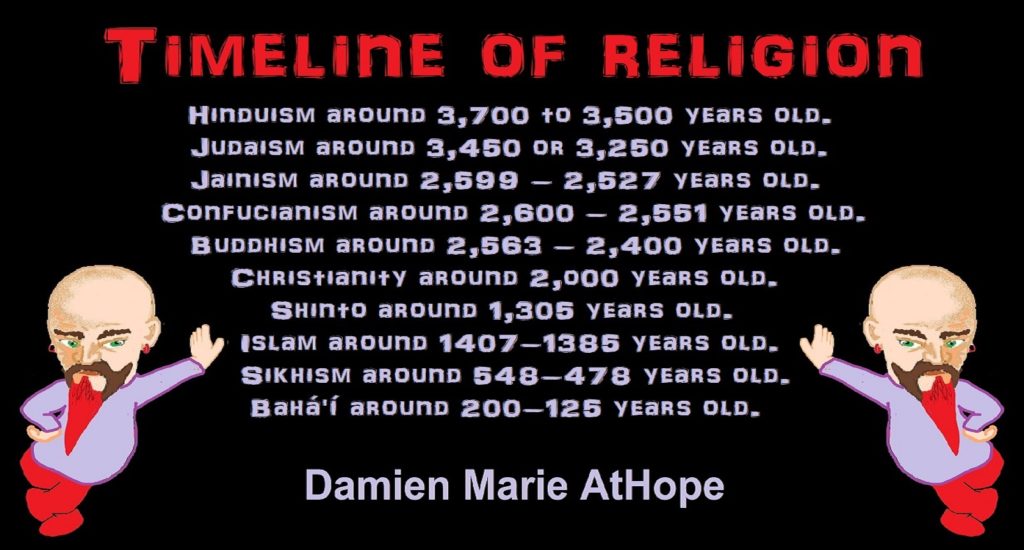
Hinduism around 3,700 to 3,500 years old. ref
Judaism around 3,450 or 3,250 years old. (The first writing in the bible was “Paleo-Hebrew” dated to around 3,000 years ago Khirbet Qeiyafa is the site of an ancient fortress city overlooking the Elah Valley. And many believe the religious Jewish texts were completed around 2,500) ref, ref
Judaism is around 3,450 or 3,250 years old. (“Paleo-Hebrew” 3,000 years ago and Torah 2,500 years ago)
“Judaism is an Abrahamic, its roots as an organized religion in the Middle East during the Bronze Age. Some scholars argue that modern Judaism evolved from Yahwism, the religion of ancient Israel and Judah, by the late 6th century BCE, and is thus considered to be one of the oldest monotheistic religions.” ref
“Yahwism is the name given by modern scholars to the religion of ancient Israel, essentially polytheistic, with a plethora of gods and goddesses. Heading the pantheon was Yahweh, the national god of the Israelite kingdoms of Israel and Judah, with his consort, the goddess Asherah; below them were second-tier gods and goddesses such as Baal, Shamash, Yarikh, Mot, and Astarte, all of whom had their own priests and prophets and numbered royalty among their devotees, and a third and fourth tier of minor divine beings, including the mal’ak, the messengers of the higher gods, who in later times became the angels of Judaism, Christianity and Islam. Yahweh, however, was not the ‘original’ god of Israel “Isra-El”; it is El, the head of the Canaanite pantheon, whose name forms the basis of the name “Israel”, and none of the Old Testament patriarchs, the tribes of Israel, the Judges, or the earliest monarchs, have a Yahwistic theophoric name (i.e., one incorporating the name of Yahweh).” ref
“El is a Northwest Semitic word meaning “god” or “deity“, or referring (as a proper name) to any one of multiple major ancient Near Eastern deities. A rarer form, ‘ila, represents the predicate form in Old Akkadian and in Amorite. The word is derived from the Proto-Semitic *ʔil-, meaning “god”. Specific deities known as ‘El or ‘Il include the supreme god of the ancient Canaanite religion and the supreme god of East Semitic speakers in Mesopotamia’s Early Dynastic Period. ʼĒl is listed at the head of many pantheons. In some Canaanite and Ugaritic sources, ʼĒl played a role as father of the gods, of creation, or both. For example, in the Ugaritic texts, ʾil mlk is understood to mean “ʼĒl the King” but ʾil hd as “the god Hadad“. The Semitic root ʾlh (Arabic ʾilāh, Aramaic ʾAlāh, ʾElāh, Hebrew ʾelōah) may be ʾl with a parasitic h, and ʾl may be an abbreviated form of ʾlh. In Ugaritic the plural form meaning “gods” is ʾilhm, equivalent to Hebrew ʾelōhîm “powers”. In the Hebrew texts this word is interpreted as being semantically singular for “god” by biblical commentators. However the documentary hypothesis for the Old Testament (corresponds to the Jewish Torah) developed originally in the 1870s, identifies these that different authors – the Jahwist, Elohist, Deuteronomist, and the Priestly source – were responsible for editing stories from a polytheistic religion into those of a monotheistic religion. Inconsistencies that arise between monotheism and polytheism in the texts are reflective of this hypothesis.” ref
Jainism around 2,599 – 2,527 years old. ref
Confucianism around 2,600 – 2,551 years old. ref
Buddhism around 2,563/2,480 – 2,483/2,400 years old. ref
Christianity around 2,o00 years old. ref
Shinto around 1,305 years old. ref
Islam around 1407–1385 years old. ref

Knowledge to Ponder:
Stars/Astrology:
- Possibly, around 30,000 years ago (in simpler form) to 6,000 years ago, Stars/Astrology are connected to Ancestors, Spirit Animals, and Deities.
- The star also seems to be a possible proto-star for Star of Ishtar, Star of Inanna, or Star of Venus.
- Around 7,000 to 6,000 years ago, Star Constellations/Astrology have connections to the “Kurgan phenomenon” of below-ground “mound” stone/wood burial structures and “Dolmen phenomenon” of above-ground stone burial structures.
- Around 6,500–5,800 years ago, The Northern Levant migrations into Jordon and Israel in the Southern Levant brought new cultural and religious transfer from Turkey and Iran.
- “The Ghassulian Star,” a mysterious 6,000-year-old mural from Jordan may have connections to the European paganstic kurgan/dolmens phenomenon.
“Astrology is a range of divinatory practices, recognized as pseudoscientific since the 18th century, that claim to discern information about human affairs and terrestrial events by studying the apparent positions of celestial objects. Different cultures have employed forms of astrology since at least the 2nd millennium BCE, these practices having originated in calendrical systems used to predict seasonal shifts and to interpret celestial cycles as signs of divine communications. Most, if not all, cultures have attached importance to what they observed in the sky, and some—such as the Hindus, Chinese, and the Maya—developed elaborate systems for predicting terrestrial events from celestial observations. Western astrology, one of the oldest astrological systems still in use, can trace its roots to 19th–17th century BCE Mesopotamia, from where it spread to Ancient Greece, Rome, the Islamicate world and eventually Central and Western Europe. Contemporary Western astrology is often associated with systems of horoscopes that purport to explain aspects of a person’s personality and predict significant events in their lives based on the positions of celestial objects; the majority of professional astrologers rely on such systems.” ref
Around 5,500 years ago, Science evolves, The first evidence of science was 5,500 years ago and was demonstrated by a body of empirical, theoretical, and practical knowledge about the natural world. ref
Around 5,000 years ago, Origin of Logics is a Naturalistic Observation (principles of valid reasoning, inference, & demonstration) ref
Around 4,150 to 4,000 years ago: The earliest surviving versions of the Sumerian Epic of Gilgamesh, which was originally titled “He who Saw the Deep” (Sha naqba īmuru) or “Surpassing All Other Kings” (Shūtur eli sharrī) were written. ref
Hinduism:
- 3,700 years ago or so, the oldest of the Hindu Vedas (scriptures), the Rig Veda was composed.
- 3,500 years ago or so, the Vedic Age began in India after the collapse of the Indus Valley Civilization.
Judaism:
- around 3,000 years ago, the first writing in the bible was “Paleo-Hebrew”
- around 2,500 years ago, many believe the religious Jewish texts were completed
Myths: The bible inspired religion is not just one religion or one myth but a grouping of several religions and myths
- Around 3,450 or 3,250 years ago, according to legend, is the traditionally accepted period in which the Israelite lawgiver, Moses, provided the Ten Commandments.
- Around 2,500 to 2,400 years ago, a collection of ancient religious writings by the Israelites based primarily upon the Hebrew Bible, Tanakh, or Old Testament is the first part of Christianity’s bible.
- Around 2,400 years ago, the most accepted hypothesis is that the canon was formed in stages, first the Pentateuch (Torah).
- Around 2,140 to 2,116 years ago, the Prophets was written during the Hasmonean dynasty, and finally the remaining books.
- Christians traditionally divide the Old Testament into four sections:
- The first five books or Pentateuch (Torah).
- The proposed history books telling the history of the Israelites from their conquest of Canaan to their defeat and exile in Babylon.
- The poetic and proposed “Wisdom books” dealing, in various forms, with questions of good and evil in the world.
- The books of the biblical prophets, warning of the consequences of turning away from God:
- Henotheism:
- Exodus 20:23 “You shall not make other gods besides Me (not saying there are no other gods just not to worship them); gods of silver or gods of gold, you shall not make for yourselves.”
- Polytheism:
- Judges 10:6 “Then the sons of Israel again did evil in the sight of the LORD, served the Baals and the Ashtaroth, the gods of Aram, the gods of Sidon, the gods of Moab, the gods of the sons of Ammon, and the gods of the Philistines; thus they forsook the LORD and did not serve Him.”
- 1 Corinthians 8:5 “For even if there are so-called gods whether in heaven or on earth, as indeed there are many gods and many lords.”
- Monotheism:
- Isaiah 43:10 “You are my witnesses,” declares the LORD, “and my servant whom I have chosen, so that you may know and believe me and understand that I am he. Before me no god was formed, nor will there be one after me.
Around 2,570 to 2,270 Years Ago, there is a confirmation of atheistic doubting as well as atheistic thinking, mainly by Greek philosophers. However, doubting gods is likely as old as the invention of gods and should destroy the thinking that belief in god(s) is the “default belief”. The Greek word is apistos (a “not” and pistos “faithful,”), thus not faithful or faithless because one is unpersuaded and unconvinced by a god(s) claim. Short Definition: unbelieving, unbeliever, or unbelief.

Expressions of Atheistic Thinking:
- Around 2,600 years ago, Ajita Kesakambali, ancient Indian philosopher, who is the first known proponent of Indian materialism. ref
- Around 2,535 to 2,475 years ago, Heraclitus, Greek pre-Socratic philosopher, a native of the Greek city Ephesus, Ionia, on the coast of Anatolia, also known as Asia Minor or modern Turkey. ref
- Around 2,500 to 2,400 years ago, according to The Story of Civilization book series certain African pygmy tribes have no identifiable gods, spirits, or religious beliefs or rituals, and even what burials accrue are without ceremony. ref
- Around 2,490 to 2,430 years ago, Empedocles, Greek pre-Socratic philosopher and a citizen of Agrigentum, a Greek city in Sicily. ref
- Around 2,460 to 2,370 years ago, Democritus, Greek pre-Socratic philosopher considered to be the “father of modern science” possibly had some disbelief amounting to atheism. ref
- Around 2,399 years ago or so, Socrates, a famous Greek philosopher was tried for sinfulness by teaching doubt of state gods. ref
- Around 2,341 to 2,270 years ago, Epicurus, a Greek philosopher known for composing atheistic critics and famously stated, “Is God willing to prevent evil, but not able? Then he is not omnipotent. Is he able, but not willing? Then he is malevolent. Is he both able and willing? Then whence cometh evil? Is he neither able nor willing? Then why call him god?” ref
This last expression by Epicurus, seems to be an expression of Axiological Atheism. To understand and utilize value or actually possess “Value Conscious/Consciousness” to both give a strong moral “axiological” argument (the problem of evil) as well as use it to fortify humanism and positive ethical persuasion of human helping and care responsibilities. Because value-blindness gives rise to sociopathic/psychopathic evil.



While hallucinogens are associated with shamanism, it is alcohol that is associated with paganism.
The Atheist-Humanist-Leftist Revolutionaries Shows in the prehistory series:
Show two: Pre-animism 300,000 years old and animism 100,000 years old: related to “Anarchism and Socialism”
Show tree: Totemism 50,000 years old: related to “Anarchism and Socialism”
Show four: Shamanism 30,000 years old: related to “Anarchism and Socialism”
Show five: Paganism 12,000 years old: related to “Anarchism and Socialism”
Show six: Emergence of hierarchy, sexism, slavery, and the new male god dominance: Paganism 7,000-5,000 years old: related to “Anarchism and Socialism” (Capitalism) (World War 0) Elite and their slaves!
Prehistory: related to “Anarchism and Socialism” the division of labor, power, rights, and recourses: VIDEO
Pre-animism 300,000 years old and animism 100,000 years old: related to “Anarchism and Socialism”: VIDEO
Totemism 50,000 years old: related to “Anarchism and Socialism”: VIDEO
Shamanism 30,000 years old: related to “Anarchism and Socialism”: VIDEO
Paganism 12,000 years old: related to “Anarchism and Socialism” (Pre-Capitalism): VIDEO
Paganism 7,000-5,000 years old: related to “Anarchism and Socialism” (Capitalism) (World War 0) Elite and their slaves: VIEDO
Paganism 5,000 years old: progressed organized religion and the state: related to “Anarchism and Socialism” (Kings and the Rise of the State): VIEDO
Paganism 4,000 years old: related to “Anarchism and Socialism” (First Moralistic gods, then the Origin time of Monotheism): VIEDO
I do not hate simply because I challenge and expose myths or lies any more than others being thought of as loving simply because of the protection and hiding from challenge their favored myths or lies.
The truth is best championed in the sunlight of challenge.
An archaeologist once said to me “Damien religion and culture are very different”
My response, So are you saying that was always that way, such as would you say Native Americans’ cultures are separate from their religions? And do you think it always was the way you believe?
I had said that religion was a cultural product. That is still how I see it and there are other archaeologists that think close to me as well. Gods too are the myths of cultures that did not understand science or the world around them, seeing magic/supernatural everywhere.
I personally think there is a goddess and not enough evidence to support a male god at Çatalhöyük but if there was both a male and female god and goddess then I know the kind of gods they were like Proto-Indo-European mythology.
This series idea was addressed in, Anarchist Teaching as Free Public Education or Free Education in the Public: VIDEO
Our 12 video series: Organized Oppression: Mesopotamian State Force and the Politics of power (9,000-4,000 years ago), is adapted from: The Complete and Concise History of the Sumerians and Early Bronze Age Mesopotamia (7000-2000 BC): https://www.youtube.com/watch?v=szFjxmY7jQA by “History with Cy“
Show #1: Mesopotamian State Force and the Politics of Power (Samarra, Halaf, Ubaid)
Show #2: Mesopotamian State Force and the Politics of Power
Show #3: Mesopotamian State Force and the Politics of Power (Uruk and the First Cities)
Show #4: Mesopotamian State Force and the Politics of Power (First Kings)
Show #5: Mesopotamian State Force and the Politics of Power (Early Dynastic Period)
Show #6: Mesopotamian State Force and the Politics of Power
Show #7: Mesopotamian State Force and the Politics of Power (Sargon and Akkadian Rule)
Show #9: Mesopotamian State Force and the Politics of Power (Gudea of Lagash and Utu-hegal)
Show #12: Mesopotamian State Force and the Politics of Power (Aftermath and Legacy of Sumer)

The “Atheist-Humanist-Leftist Revolutionaries”
Cory Johnston ☭ Ⓐ Atheist Leftist @Skepticallefty & I (Damien Marie AtHope) @AthopeMarie (my YouTube & related blog) are working jointly in atheist, antitheist, antireligionist, antifascist, anarchist, socialist, and humanist endeavors in our videos together, generally, every other Saturday.
Why Does Power Bring Responsibility?
Think, how often is it the powerless that start wars, oppress others, or commit genocide? So, I guess the question is to us all, to ask, how can power not carry responsibility in a humanity concept? I know I see the deep ethical responsibility that if there is power their must be a humanistic responsibility of ethical and empathic stewardship of that power. Will I be brave enough to be kind? Will I possess enough courage to be compassionate? Will my valor reach its height of empathy? I as everyone, earns our justified respect by our actions, that are good, ethical, just, protecting, and kind. Do I have enough self-respect to put my love for humanity’s flushing, over being brought down by some of its bad actors? May we all be the ones doing good actions in the world, to help human flourishing.
I create the world I want to live in, striving for flourishing. Which is not a place but a positive potential involvement and promotion; a life of humanist goal precision. To master oneself, also means mastering positive prosocial behaviors needed for human flourishing. I may have lost a god myth as an atheist, but I am happy to tell you, my friend, it is exactly because of that, leaving the mental terrorizer, god belief, that I truly regained my connected ethical as well as kind humanity.
Cory and I will talk about prehistory and theism, addressing the relevance to atheism, anarchism, and socialism.
At the same time as the rise of the male god, 7,000 years ago, there was also the very time there was the rise of violence, war, and clans to kingdoms, then empires, then states. It is all connected back to 7,000 years ago, and it moved across the world.
Cory Johnston: https://damienmarieathope.com/2021/04/cory-johnston-mind-of-a-skeptical-leftist/?v=32aec8db952d
The Mind of a Skeptical Leftist (YouTube)
Cory Johnston: Mind of a Skeptical Leftist @Skepticallefty
The Mind of a Skeptical Leftist By Cory Johnston: “Promoting critical thinking, social justice, and left-wing politics by covering current events and talking to a variety of people. Cory Johnston has been thoughtfully talking to people and attempting to promote critical thinking, social justice, and left-wing politics.” http://anchor.fm/skepticalleft
Cory needs our support. We rise by helping each other.
Cory Johnston ☭ Ⓐ @Skepticallefty Evidence-based atheist leftist (he/him) Producer, host, and co-host of 4 podcasts @skeptarchy @skpoliticspod and @AthopeMarie
Damien Marie AtHope (“At Hope”) Axiological Atheist, Anti-theist, Anti-religionist, Secular Humanist. Rationalist, Writer, Artist, Poet, Philosopher, Advocate, Activist, Psychology, and Armchair Archaeology/Anthropology/Historian.
Damien is interested in: Freedom, Liberty, Justice, Equality, Ethics, Humanism, Science, Atheism, Antiteism, Antireligionism, Ignosticism, Left-Libertarianism, Anarchism, Socialism, Mutualism, Axiology, Metaphysics, LGBTQI, Philosophy, Advocacy, Activism, Mental Health, Psychology, Archaeology, Social Work, Sexual Rights, Marriage Rights, Woman’s Rights, Gender Rights, Child Rights, Secular Rights, Race Equality, Ageism/Disability Equality, Etc. And a far-leftist, “Anarcho-Humanist.”
I am not a good fit in the atheist movement that is mostly pro-capitalist, I am anti-capitalist. Mostly pro-skeptic, I am a rationalist not valuing skepticism. Mostly pro-agnostic, I am anti-agnostic. Mostly limited to anti-Abrahamic religions, I am an anti-religionist.
To me, the “male god” seems to have either emerged or become prominent around 7,000 years ago, whereas the now favored monotheism “male god” is more like 4,000 years ago or so. To me, the “female goddess” seems to have either emerged or become prominent around 11,000-10,000 years ago or so, losing the majority of its once prominence around 2,000 years ago due largely to the now favored monotheism “male god” that grow in prominence after 4,000 years ago or so.
My Thought on the Evolution of Gods?
Animal protector deities from old totems/spirit animal beliefs come first to me, 13,000/12,000 years ago, then women as deities 11,000/10,000 years ago, then male gods around 7,000/8,000 years ago. Moralistic gods around 5,000/4,000 years ago, and monotheistic gods around 4,000/3,000 years ago.


Damien Marie AtHope (Said as “At” “Hope”)/(Autodidact Polymath but not good at math):
Axiological Atheist, Anti-theist, Anti-religionist, Secular Humanist, Rationalist, Writer, Artist, Jeweler, Poet, “autodidact” Philosopher, schooled in Psychology, and “autodidact” Armchair Archaeology/Anthropology/Pre-Historian (Knowledgeable in the range of: 1 million to 5,000/4,000 years ago). I am an anarchist socialist politically. Reasons for or Types of Atheism
My Website, My Blog, & Short-writing or Quotes, My YouTube, Twitter: @AthopeMarie, and My Email: damien.marie.athope@gmail.com




